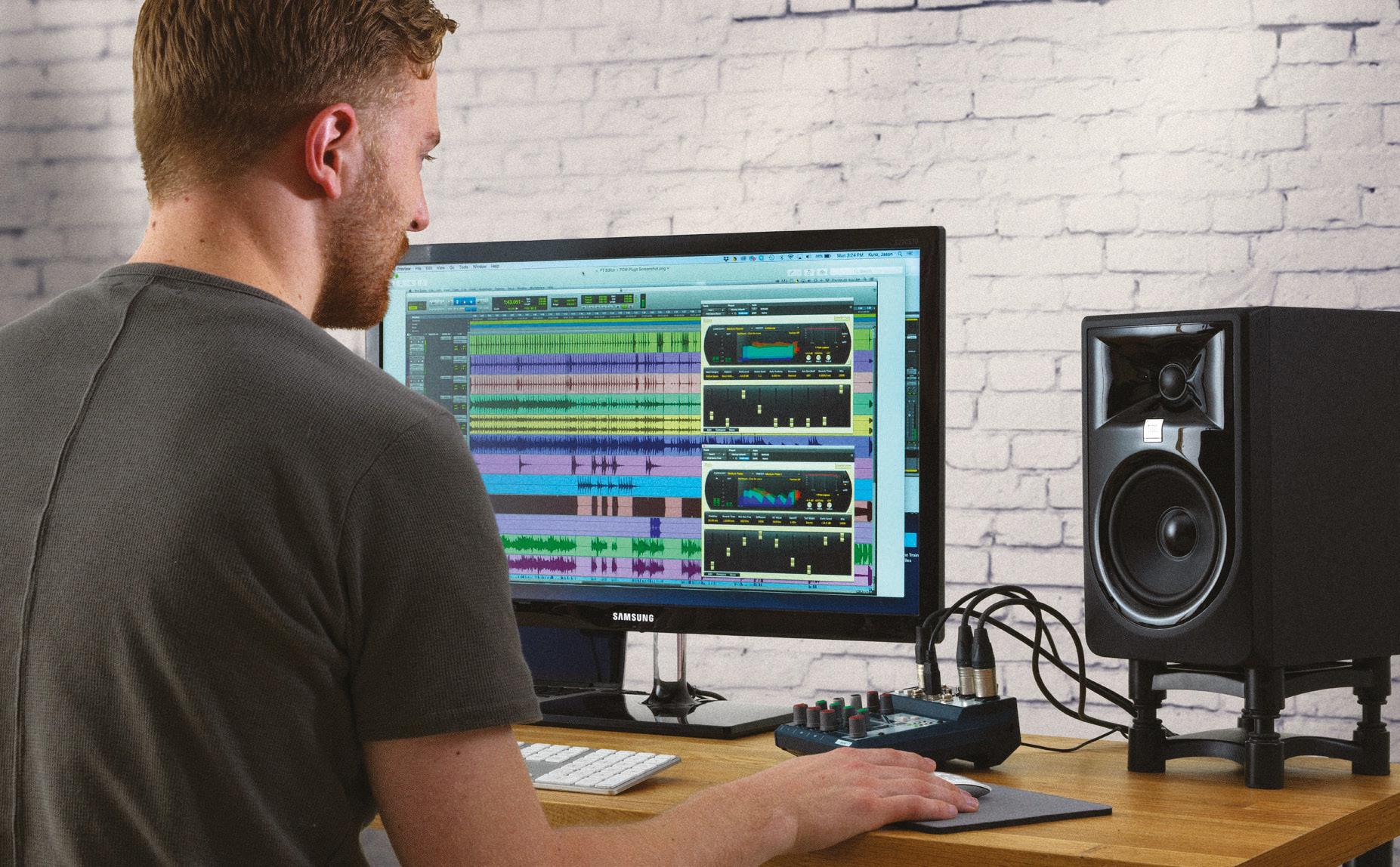

 ©2022 QSC, LLC. All rights reserved. QSC and the QSC logo are registered trademarks of QSC, LLC in the U.S. Patent and Trademark Office and other countries. Play Out Loud is a trademark of QSC, LLC.
Conner Pledger
©2022 QSC, LLC. All rights reserved. QSC and the QSC logo are registered trademarks of QSC, LLC in the U.S. Patent and Trademark Office and other countries. Play Out Loud is a trademark of QSC, LLC.
Conner Pledger



 ©2022 QSC, LLC. All rights reserved. QSC and the QSC logo are registered trademarks of QSC, LLC in the U.S. Patent and Trademark Office and other countries. Play Out Loud is a trademark of QSC, LLC.
Conner Pledger
©2022 QSC, LLC. All rights reserved. QSC and the QSC logo are registered trademarks of QSC, LLC in the U.S. Patent and Trademark Office and other countries. Play Out Loud is a trademark of QSC, LLC.
Conner Pledger

45It’s been a huge year for this industry. It certainly feels as though it’s the closest it has been to its pre-Covid state. We’ve seen the return of Glastonbury after two years away; the annual NAMM Show making its first post-pandemic in-person outing, albeit it in June as opposed to its customary January scheduling; and we’ve seen large scale gatherings come back after a period rife with challenges and uncertainty.
What’s more, we’ve also seen many leading businesses across the pro audio and music tech markets ramping up their R&D efforts in a bid to kick off 2023 on the front foot. Sentiments that are certainly true of this issue’s cover star, Holoplot CEO Roman Sick.
A few months back, Headliner paid him a visit in Berlin to get the inside track on his plans to revolutionise the world of immersive audio and pro AV. Unlike most CEOs or company founders in the market, his background is not in audio, which, as you’ll find in our interview, has afforded him a fresh perspective on an industry that hasn’t always been open to change. He certainly has some strong opinions on where he sees the industry headed, and is absolutely determined that it will be Holoplot that leads the next major revolution in pro audio.
With one particularly high-profile project in the offing early next year, it will be fascinating to see how he and the company deal with being placed under the market’s microscope, and indeed, how his competitors respond in turn.
What most people will surely agree on is that any industry can only benefit from the arrival of a disruptor entering the fray. If it means that everyone else feels the urge and necessity to up their game and push boundaries just a little harder then it’s good news for everyone.
Of course, there is an ever-shifting menu of challenges for the industry to tackle, be it the lingering impacts of the pandemic, the cost-of-living crisis, or the ongoing supply chain issues affecting pretty much every tech manufacturer on the planet. But after two years of recovery, here’s hoping 2023 will be a year of prosperity and success.
Daniel Gumble Head of Music, Headliner
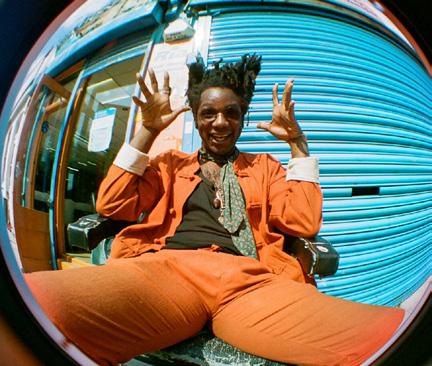
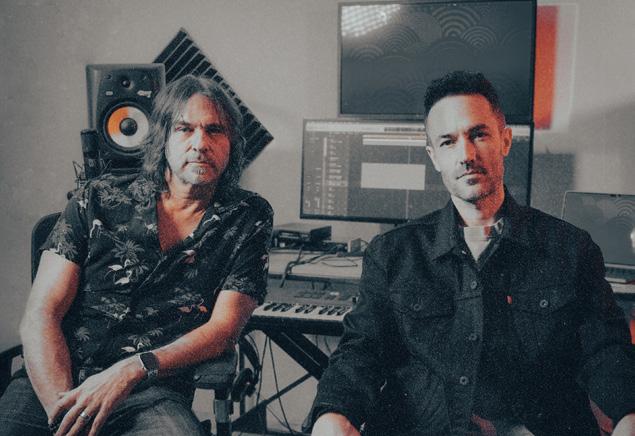
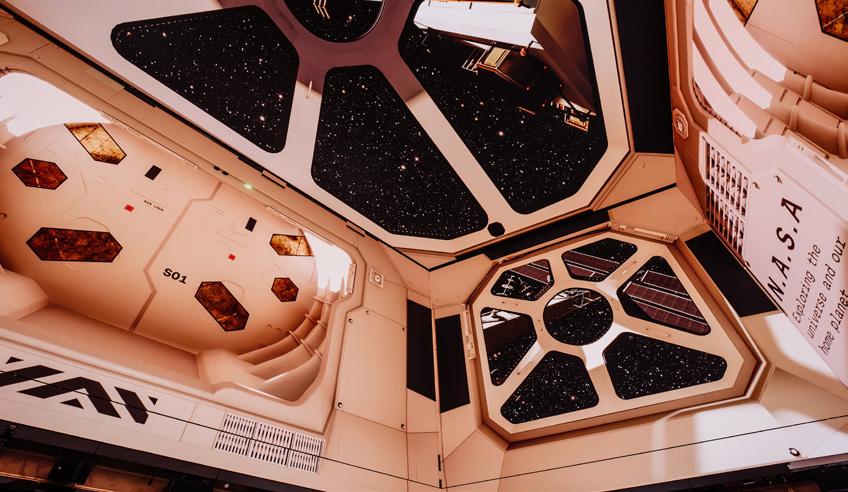





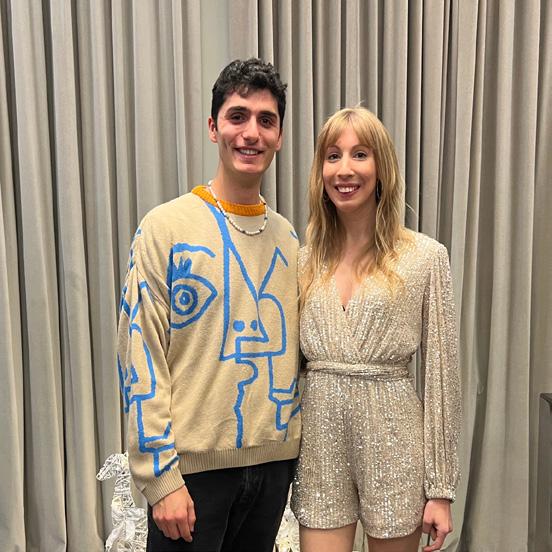
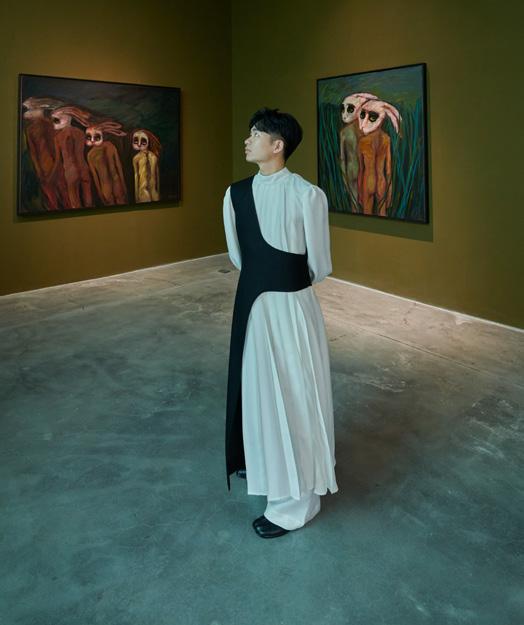






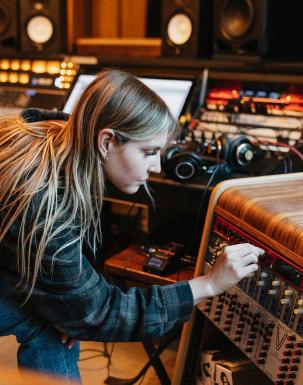
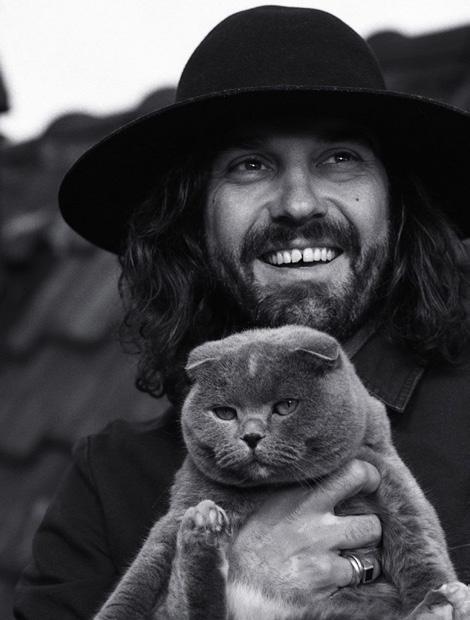

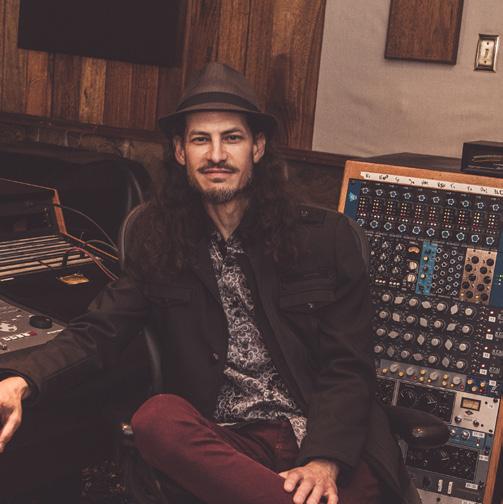


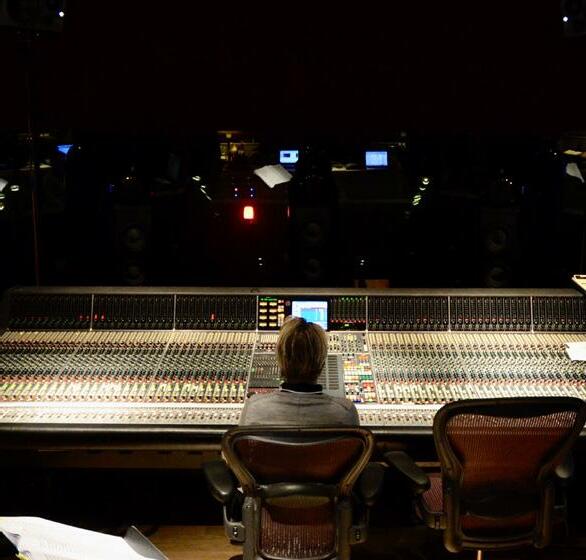


Don’t ask L.A. Salami to play his greatest hits — this British singersongwriter who grew up between Kent and South London says he grows detached from his older songs very quickly after releasing them. It’s partly due to his desire to keep his music and creative approach as firmly in the present moment as possible. This might explain why Ottoline, his new album, is such a genre-hopping, undefinable piece of work. He chats about viewing his music career as non-linear, and the big sonic leaps he has taken with Ottoline.
Born Lookman Adekunle Salami, his father was absent during his coastal and city upbringing (he lived between Peckham and Ramsgate) and his first few years were spent in a foster home, which has imprinted upon him a longstanding feeling of being an outsider. Creativity was always completely intuitive for Salami, inspired by visual art, music, the written word, and an early desire to be the next Spielberg. Over the years, his songs, which combine folk, blues, acoustic, rock and plenty more, have entered the millions on streaming platforms, in particular, I Can’t Slow
Her Down and Day to Day for 6 Days a Week
Some have pinpointed Salami’s breakthrough moment as happening in 2012, with several key events happening: he was chosen to support Lianne La Havas on tour, and was signed to London independent label Camouflage Recordings. And then Burberry got in touch; Christopher Bailey, their chief creative officer, reached out to perform at a Burberry acoustic session, and he even got to open a 2014 fashion runway show.
It’s 4pm on a Monday afternoon, and Salami joins the Zoom call with his phone camera aimed so that Headliner can only see the ceiling and intermittently his silhouette and his vast shadow. Headliner asks how his day has been so far, and he replies, “short”. It’s a fairly safe bet that Salami is not a morning person.
“It was the ‘90s when I was growing up in Peckham,” Salami says, with a yawn occasionally breaking up his sentences. “It was a lot rougher than it is now; I actually quite appreciate how it is today, to be honest. Everything shapes you, and Peckham has definitely been an ingredient for my perspective on life.”
He reflects on his entry point to music being via dancing to Nigerian music at a young age:
“There was always music in the background, in the home
environment, and lots of worship music, praising the Lord, etc in the church environment. Which you can interpret as celebrating life – I think all good music does that. I also remember cutting loose to James Brown and Michael Jackson – I didn’t think Jackson was human,” he laughs. “Any music I moved to, I would always strongly remember. It was kind of spiritual.”
Salami’s career has seen him release four albums and four EPs. He debuted with Another Shade of Blue in 2013, largely flavoured by his vocals and acoustic guitar. His first full LP, Dancing With Bad Grammar saw him graduate to a fuller band sound. 2020’s The Cause of Doubt & a Reason to Have Faith is certainly an example of Salami’s work where you cannot pin him down as merely an acoustic singer-songwriter or an indie-rock artist, as all manner of instruments and sounds fly out of the floodgates.
“I grew up around a lot of siblings, so you have to compete for attention,” he says. “I have a lot of personal songwriting targets I have to meet just to feel I have the right to stand in front of people and sing. It takes a certain audacity to enter a career in music, I think. And the fact I enjoy doing it, of course. But in terms of exploring different sounds, I’ve always wondered why anyone would want to do just one thing when there are so many different sounds, so many different avenues you can go down.”
Salami’s new album offers yet more stark contrast to virtually everything that has come before. Its album cover is a striking red, with a silhouette of the man himself covering one eye, and the hand in question is a ghostly blue. Prior to its release, he had let people know this would be his most hip-hop-inspired album thus far, and
its searing opener, Desperate Times, Mediocre Measures is quite blistering in its samples, bass, drum beat, and Salami takes no prisoners in the lyrics.
“Since I started doing music professionally in 2016, I would be recording very fast,” he says. “We’d record an album in a week, and then mix it in a week. And then since 2020 it’s been more meticulous. I took more care and time or what have you. I didn’t rush it so much. And you can definitely hear that in the sound.
“I’m constantly talking about masters; because you have to master yourself, and we’re constantly under the threat of being tamed by our masters. And we kind of are at the moment. Because the structures are sort of working so well that we’re apathetic and walking into a new state of authoritarianism.”
This message is perhaps never stronger than in Systemic Pandemic, in which Salami’s singing has an undeniable hip-hop flow to it: “Genocide, psychopaths, warlords make the maps / A masculine audacity that’s woven in the stats / Femininity in wanton touch she heals her servant back / And if healing is a balance act, let balance take control.”
While it’s not uncommon for a lot of musicians to grow weary of the expectation to perform their older, biggest hits at their shows, Salami takes this to the next level. He really dislikes playing any older material. In fact, and bearing in mind this is an album that came out in October this year, he says “I’m over Ottoline already! [laughs] But it’s all stopped being linear for me.”
Regarding playing his material that might be typically regarded as older (i.e having been out a few years rather than a few months), he says,

‘The more I play stuff that’s old to me, the more I feel guilty. I feel like I’m a con artist or something. I understand that people more often than not want to go and see things they know already. But the more I’m playing things to people that I know are old, the more I feel like I’m cheating them. I don’t feel great playing older songs, it just feels safe, like a crutch. I want to take the risk of playing new songs.”
Even though Salami seeks to live as much in the present as possible and questions the very concept of time itself, he does still have one foot in the realm of future plans and releases. It’s brilliant to hear that an expanded edition of Ottoline is in the pipeline.
“I’ll be releasing a quote-unquote director’s cut of it. So the full 19 tracks, in a different order. And the plan is to have a little movie come out with it. And some more singles to come out, too.”
It’s quite clear from just speaking to Salami, even if you had never heard a single note of his music, that he is an artist we should prize and cherish, both for this singular approach to always striving forwards musically, and for his general outlook on life.
Ottoline is an exceptional piece of work, and is clear evidence that Salami can’t bear the idea of merely being known as an acoustic folk act.
It’s the kind of album that makes you ponder, “What on Earth will the next one sound like?” It’s a question I’m sure many of us will keep with us as we follow him throughout his career and with each new record. QSC.COM LASALAMI.COM
SPONSORED BY

“THE MORE I PLAY STUFF THAT’S OLD, THE MORE I FEEL LIKE I’M A CON ARTIST.”Photographer: Ruari Meehan
For over 15 years, GLM loudspeaker manager software has enabled sound engineers across the globe to utilise our Smart Active Monitors and dial in precise mixes that translate flawlessly to other rooms and playback systems. GLM automatically adjusts your monitor’s settings to counteract unwanted room-acoustic effects, ensuring that you hear the sonic truth, no matter where you choose to set up your system.
With the introduction of our powerful new GRADE report, GLM 4.2 offers you the unique possibility to completely understand and transform your entire listening environment – creating detailed readouts in a matter of minutes.
It’s time to mix faster and better.
Get to know GLM, visit www.genelec.com/glm
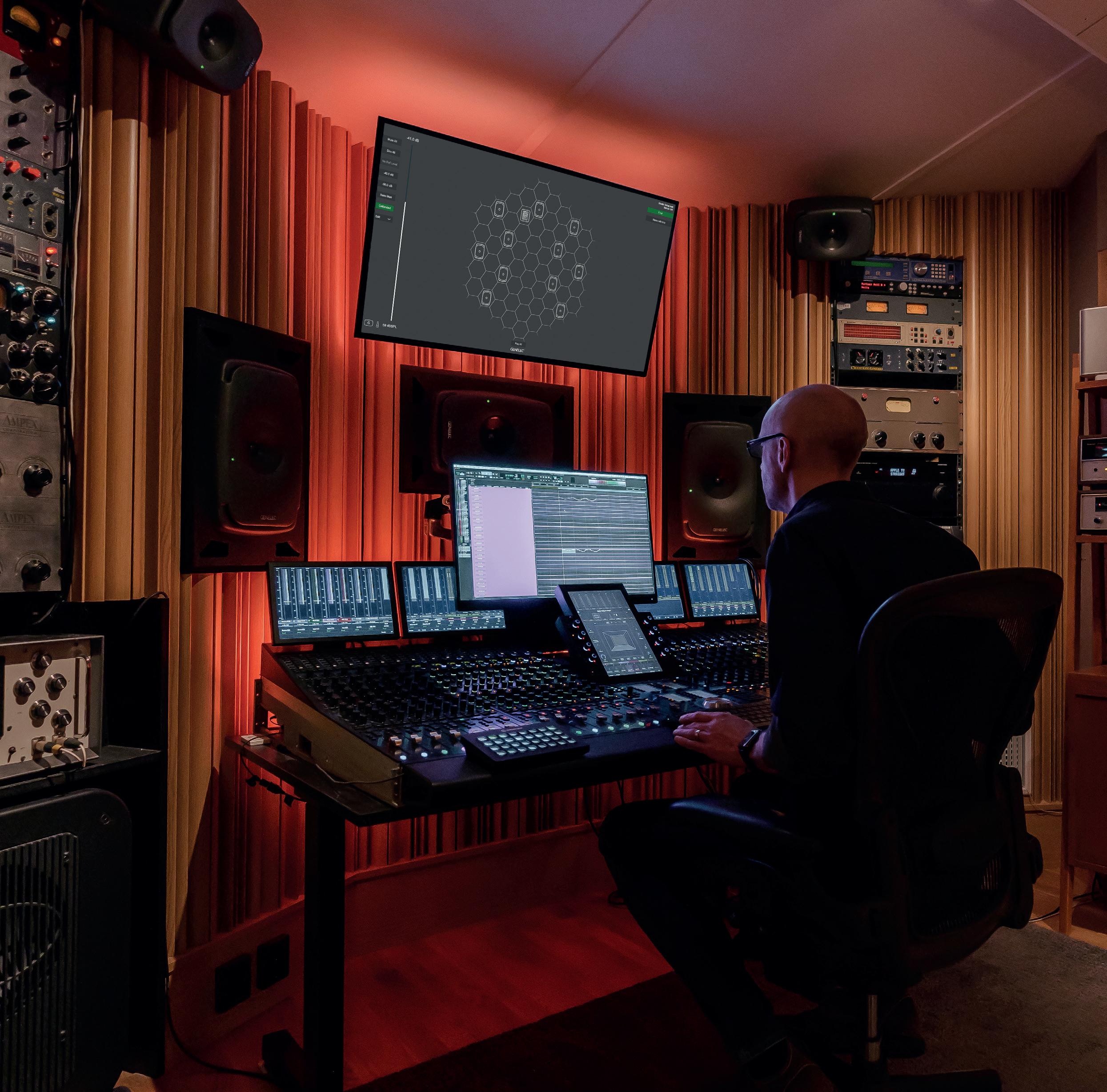
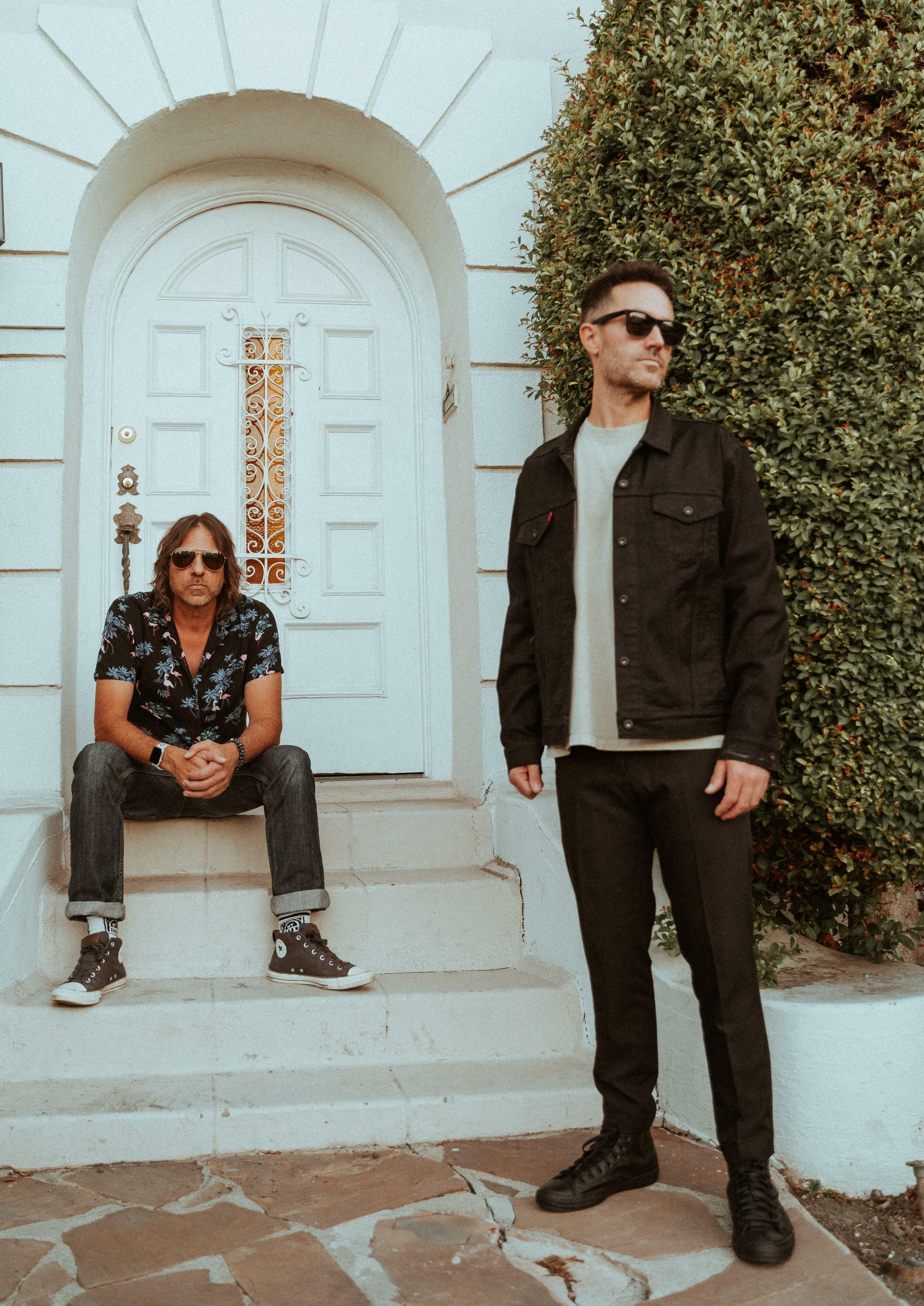
Electronic producer duo Crush Effect, made up of Jesse Molloy – best known for playing sax for Panic! At The Disco – and David Veith –who play keys for Karl Denson’s Tiny Universe – chat to Headliner about their first foray into score composing with new animated series Transformers: EarthSpark, now streaming exclusively on Paramount+.
Many years after the end of the war between the Autobots and Decepticons, young humans Robby and Mo Malto are struggling to adapt after moving from Philadelphia to the small town of Witwicky, Pennsylvania. When they find a strange object in a cave, it grants them mysterious robotic cybersleeves and gives life to Twitch and Thrash — the first ever Transformers
to be born on Earth. With new threats on the horizon, such as the mad scientist Mandroid and the Decepticons still at large, the Maltos work together to keep each other safe and find their place in the world while learning what it truly means to be a family.
Much like the lore that birthed this latest manifestation of the everpopular Transformers franchise, both Molloy and Veith’s individual experiences in live music and production runs deep. Between them, they have produced with some of the biggest names in the world of music.
Having worked together under the name Crush Effect for nearly a decade, the pair were ready to embark on a new challenge. As seasoned touring musicians with their respective acts, and both growing up in the ‘80s, Molloy and Veith’s musical influences draw a number of parallels.
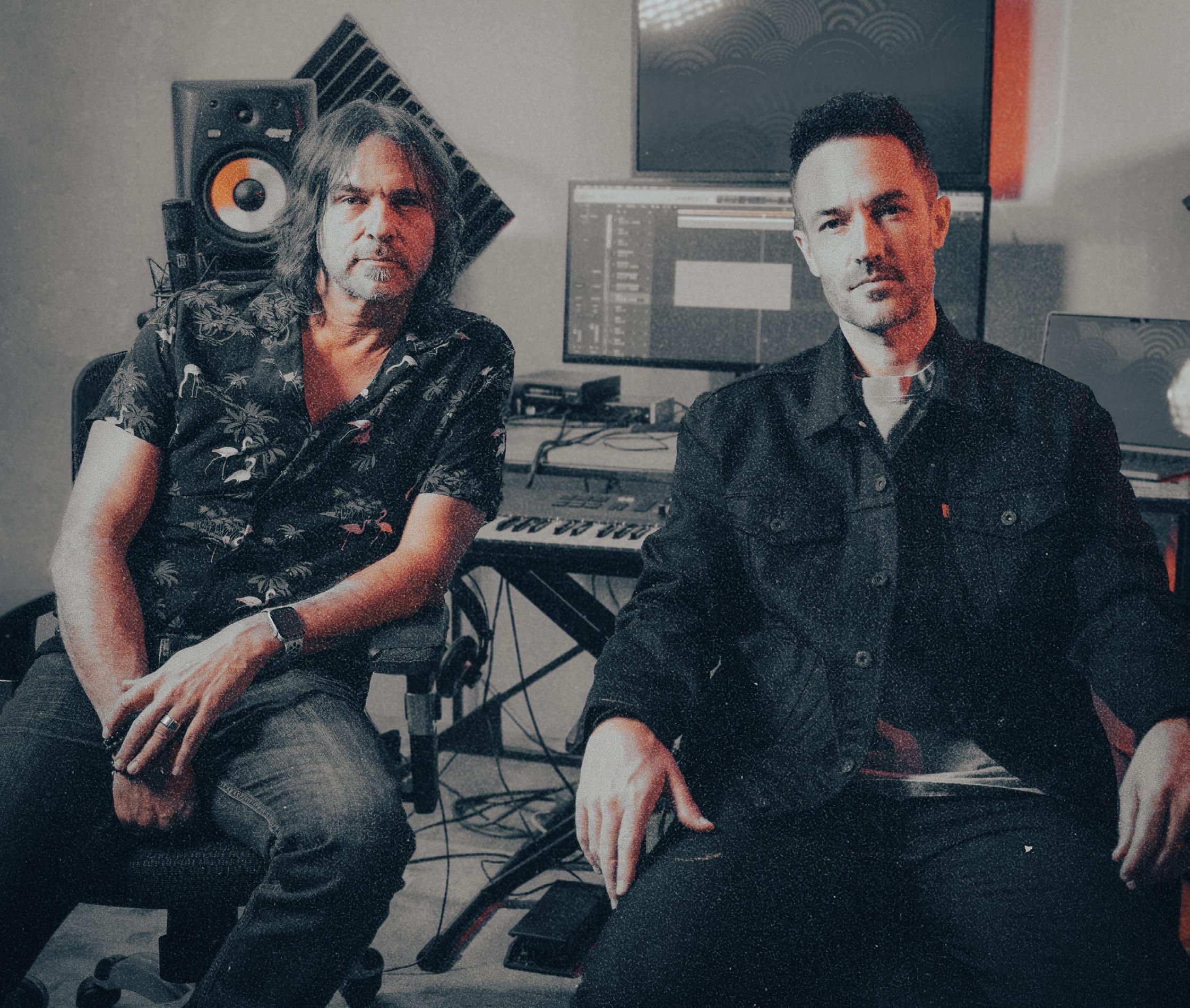
“I’ve always been really fascinated and intrigued by not only playing
music, but the aspect of sound and writing it too,” Veith begins. “And so to bring all those elements into this project, which is very synth-heavy, and invokes all these childhood memories, was totally a dream come true. The writers, producers and directors at Nickelodeon gave us a lot of free rein creatively.”
Music has always played a huge role in the Transformers identity, so taking on the task of composing the score for EarthSpark – Crush Effect’s first big project of this kind – didn’t come without its pressures.
“Originally they wanted more of a traditional orchestral sound,” Veith continues. “And then some time later
they changed the musical direction, giving us Tangerine Dream, Wendy Carlos’ Tron score, and some of the Atticus Ross Watchmen stuff as reference. It was very much up mine and Jesse’s alley, as we’d done a lot of that stuff before.
“The only real suggestion they gave to us musically was to try to punch up; it’s a kids show, but when there’s drama, they let us go as hard as we liked on the intensity of the score. They didn’t want it sounding light or corny in any way, so we definitely took that to heart when we started working on the show’s sound.”
The resulting score for Transformers: EarthSpark remains true to its roots – synth-laden and very cinematic, while pulling sounds from the worlds of cyberpunk and electronic dance music.
“The sounds of the ‘80s have become so prominent in modern music, so in a moment there could be a dark bass drone, and in the next some delicate or warm pads,” explains Molloy. “It was about bringing these elements and textures into each scene with lots of simple layering, filters and automation. It’s a very thematic show, so when things get dark so does the music, and we created recurring themes for different characters in this hybrid world.”
With both Molloy and Veith working remotely, it made practical sense for them to keep things in the box to make sharing sounds and ideas a more malleable process. They were very much conscious of keeping things in the MIDI world with plugins, giving them the ability to shoot cues back and forth to each other with ease.
“When we got the show, we stocked up on a lot of the sounds and plugins that we knew we wanted to use,” Veith recalls. “We made sure we both had the same template, and then started building channel strips and patches and all kinds of sounds for certain characters and scenes. The way we were able to share them back and forth definitely made it easier to build a world together for the show.”
In building said world, Crush Effect ensured their use of digital sound processing tools was focused and meaningful. One of the most essential plugins throughout the process, Molloy tells Headliner, was oeksound’s soothe2.
“Soothe2 is just fantastic when creating textures and layers – I use it all the time and it is so impressive,” he says. “If a synth has a bright 2K or 3K then you can just throw soothe on there without necessarily having to use an EQ, and it makes it sound more ear-friendly. I find it to be one of the most valuable plugins for sound design – it really helps with glueing the overall mix together, whether that’s drums, synths, vocals, or even your master bus. It’s an incredible thing to have in the tool belt for scoring and production.”
“IT’S A VERY THEMATIC SHOW, SO WHEN THINGS GET DARK SO DOES THE MUSIC, AND WE CREATED RECURRING THEMES FOR DIFFERENT CHARACTERS IN THIS HYBRID WORLD.”
Veith agrees in that soothe2 serves as a huge time saver, with the ability to identify problem areas quickly and fix them transparently:
“Everything is bussed out into sonic groups – drums, basses, different types of keyboards, orchestral stuff, guitars – and on each one of those buses is a soothe that just sits in the template,” he reveals. “You can dial it in to taste as much as you want. The thing I love about it is that it just does its thing without you having to mess with it much. We have to work so fast between the writing, producing, mixing, and then the stemming out, so plugins like this are a godsend for sure.”
While Crush Effect’s music has been featured in various film and TV projects over the years, Headliner was curious to find out how composing an original score from
scratch for Transformers: EarthSpark stacked up.
“We’re still using the same writing, production and mixing skill sets that we’ve developed together for the last 10 years, as they lend themselves really well to the sound of the show,” continues Veith. “The sonic aspect was familiar; the new challenge was, when writing to picture, things aren’t graded out like in dance music, so we had to figure out how to twist and turn emotionally to help tell the story in a better way with the music, sometimes in a very short space of time.
“We’ve worked together for a long time on a variety of projects, whether that’s writing for ourselves as Crush Effect, producing and writing for lots of singer-songwriters in Los Angeles, or doing work for hire on commercials. So Jesse and I have a really nice
musical shorthand – we tend to like and respond well to the same types of music so it just works really well.”
“I think it’s unique to have a partnership like we do, where we find so many similarities in our interests,” Molloy adds. “When we have a mission at hand, we’re like kids in a candy store to get after it. When we get time together in the studio, sometimes all of a sudden we realise we’ve just been talking for four hours! There’s definitely some intuition there though, and we’ve always been on the same wavelength creatively. It’s something I find really enjoyable about our partnership.”
Transformers: EarthSpark is available to stream on Paramount+ now.


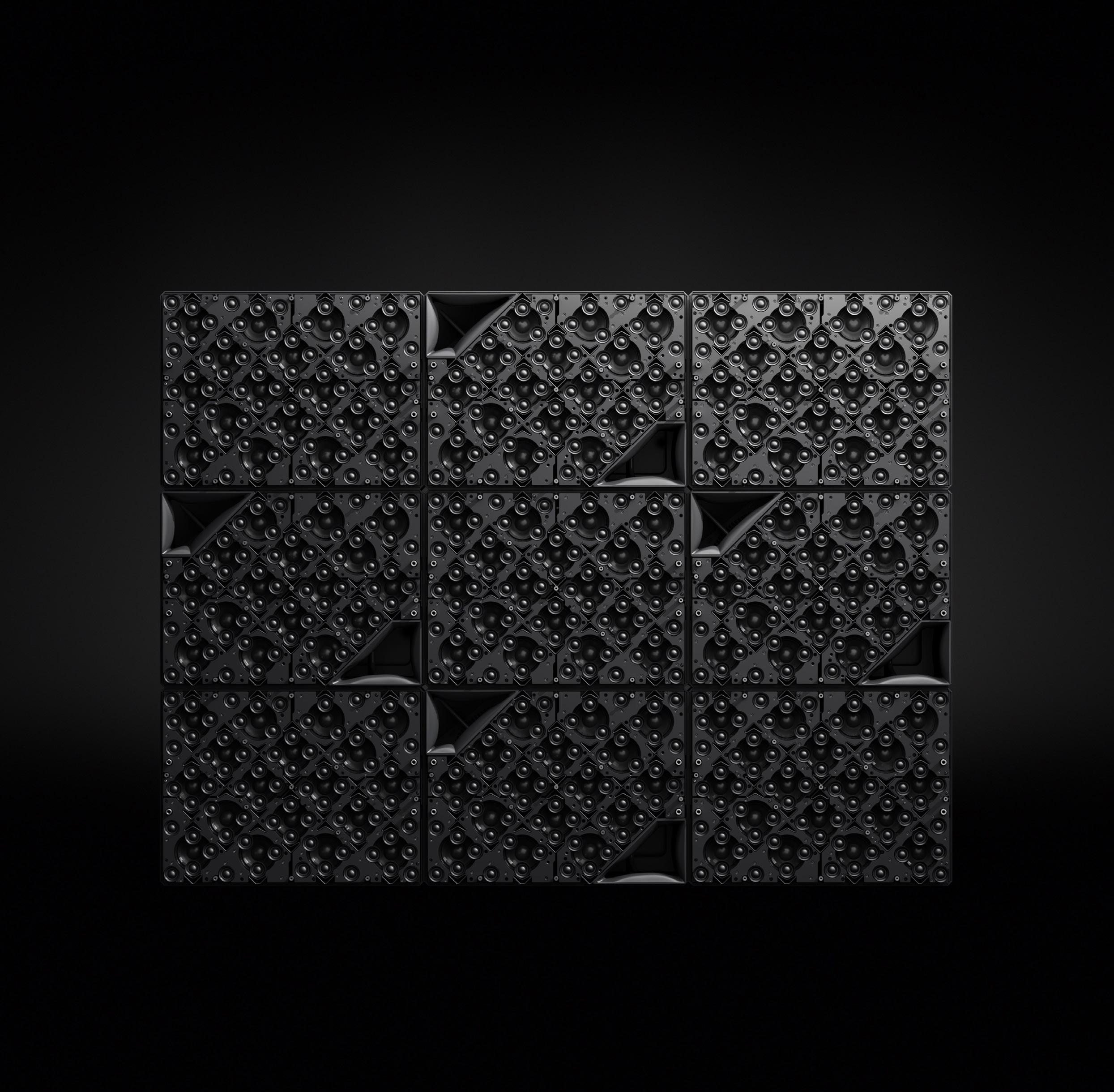

Before Headliner even lands in Berlin for our rendezvous with Holoplot CEO Roman Sick, it is evident that our meeting isn’t going to be quite the standard business interview fare. When invited to sit down for an extended in-person chat, the venue of choice is typically a meeting room at the company in question’s HQ. If not, it’ll be a nearby café of some description. In this case, we are told to head to MaHalla – a building located in one of east Berlin’s thriving creative quarters…
When we pull up outside, we are met by a sprawling industrial building that looks something akin to a power station. Vast chimneys protrude at various points, looming
heavily over the street outside, while rows of glass windows beam in shafts of bright sunlight.
Upon entering the imposing and impressive structure, all long-sinceused cast iron machinery and steely surfaces, one can’t help but feel transported to a remnant of a bygone era, harking back to the city’s heritage as an industrial powerhouse. Skylights funnel even more natural light inside, making for a warmer welcome than its interior invites one to expect.
Before long we are greeted by members of the Holoplot team, equipped with sandwiches, hot drinks and cakes, who explain that MaHalla is today utilised as a community focused creative hub, renting out its various rooms as studios for virtually all conceivable art forms, while the large space in which we are about to conduct our interview is routinely used for exhibitions, parties and all manner of events and gatherings.
Just before Sick’s arrival, we are shown to our interview spot. A cosy 1950s style living room setup has been assembled in the centre of the venue’s biggest open space, complete with small coffee table, lamp, TV, sofa and armchair. As we said, it’s far from standard fare…
Unsurprisingly, Sick is not your typical pro audio/pro AV CEO, and not just because his backstory is stark in its contrast to most of his contemporaries. Donning a red beanie hat, neatly trimmed beard and dressed in a dark blue blazer over a pink jumper, his look doesn’t fit the profile of a suited and booted corporate executive.

If the aim here was to make a statement, then Holoplot has certainly succeeded. Indeed, the company has been making some big noises since Sick took over the reins in
2016. Despite his warm, affable demeanour, he has been quick to opine on the state of the pro audio industry, highlighting not only on what he considers a dearth of innovation, but also his company’s unique ability to drive what he considers some much-needed evolution.
With a background in economics, audio admittedly wasn’t a vocation. Unlike the founders of so many of the industry’s biggest players, he wasn’t a sound engineer, inventor or audiophile. Instead, his interest in the market and subsequent passion for it was piqued over time.
“I met the original Holoplot team in 2013 by coincidence when there were just four people in a garage in Potsdam, and it was like lab work that was being done at that point,” he says, explaining his introduction to the business. “But the bits and pieces I could experience were very impressive. Even though I wasn’t from the AV industry I knew this was radically different. That excited me. I didn’t plan to engage with them, I was doing other things, but then the company got into difficulties and the original founder left the company. The tech team was still there, and the question was ‘does the business continue or not’? I looked into it to see if there was something that could be built from an entrepreneurial perspective. I was extremely intrigued, so I decided to give it a shot.”
It didn’t take long for Sick to begin implementing his vision for Holoplot. He quickly identified that the technology the company had been developing prior to his arrival had the potential to bring something
new to the pro AV market. As he tells us, the technology really needs to be experienced to be fully appreciated, but essentially, its USP is an ability to control sound similar to light. A Holoplot system delivers precision audio with consistent quality and level over large distances, nullifying the most challenging acoustics of a space. It can also be deployed to produce full, 360-degree spatial audio experiences. Audio objects can be brought to life inside an audience area and there’s no longer a need to surround a space with speakers. Using reflections to create virtual audio sources, sound can be located in places where there’s no room for a loudspeaker.
“The beauty and the beast of our technology is that it sounds too good on paper to be true,” he says. “This is a next generation, software-driven audio technology that allows you to use sound with an extremely high degree of flexibility and fidelity. In general, we provide a completely new level
of control over sound propagation by creating custom soundwaves, which are perfectly tailored via software to target the desired audience area only and hardly lose energy over distance. On the functional side, we thereby enable people to achieve significantly better results wherever they want to use sound, because all the negative effects of sound bouncing off objects, travelling in all directions and level attenuation are removed. On the more creative side, we offer sound designers, show producers and mixing engineers another layer of access to their creative content and experience creation. It’s not just sound reproduction anymore, it’s a new toolbox that allows you to paint creatively with sound output as opposed to just sound input. That completely enables a new level of creativity that simply wasn’t there before.”
“IT’S NOT JUST SOUND REPRODUCTION ANYMORE, IT’S A NEW TOOLBOX THAT ALLOWS YOU TO PAINT CREATIVELY.”
Perhaps inevitably, coming into the industry as a self-described outsider has afforded Sick a different perspective to those for whom their pro audio career was a lifelong calling. And he’s not shy about sharing his observations.
“I have a lot of respect for people who have built businesses in any sector, particularly this industry, but entering this world was an interesting experience,” he smiles. “It’s a very special industry, but it hasn’t been shaken up a lot. Talking to a lot of audio people, there is sometimes bitterness that audio doesn’t take priority in projects over other things. I hear the complaint that we have to make compromises over where the system goes because of where the visuals go… and I’m like, well, yeah! The visuals have stepped up! They took big risks and investments on certain innovations, and they just kept advancing and impressing. Audio played it very safe in my opinion and therefore didn’t have much to offer to keep up.
“And people in this industry don’t want to be told anything,” he continues. “They don’t want to be convinced. They want to convince themselves. And I appreciate that. So, we are trying to present them with facts. Our products and technology are very, very strong, and superior to conventional technologies in many regards, I would say. We are trying to present that and let them validate it for themselves. That has worked quite well. And if you can’t convince them, you need to hire them [he laughs]! We’ve been lucky to have some industry figureheads join the company, and that gives us credibility - that we’re not just a bunch of crazy people from Berlin but actually know what we’re doing!”
The subject of recruitment is a pertinent one, not just in terms of sheer numbers, but also in the calibre of personnel joining the ranks. The company has added senior staff from market leading
brands of late, which goes a long way not only in bolstering its position as not only a significant industry disruptor, but one possessed of a high working knowledge of the market.
“We have been growing fairly rapidly in the last few years,” he says. “When I took over we were four people, now we are just above 130. In the past three years we have been scaling up significantly. We are predominantly located in Berlin, but we have a team in the US. We will continue to grow, and it has been quite an experience, as we started from virtually nothing, and in a small period of time we had to make very big leaps, with little margin for error because we had to deliver on some large key projects in short periods of time. It’s been very exciting so far and is going to be very exciting in the coming years.”
As Sick puts it, there really is very little margin for error as a newcomer, especially one facing substantial scrutiny on account of its bold claims. Does the weight of the pressure sit heavy on his shoulders?
“There is pressure,” he says casually. “If you are a newcomer and you want to play top of the league you are going to be viewed by different measures. You need to do things significantly better because everyone
is going to be watching you. You need that hunger to excel, but you have to be focused at the same time and choose your battles. Frankly, we have been under a lot of scrutiny for the last few years, as we are doing the Sphere in Vegas, which is one of the biggest projects in the world. And coming from where we were, as a small company without a marketable product at that point in time, to do this project, you need to pass a lot of gates to prove that you are ready for it.
“The only reason we got there is because we have a phenomenal team. There were so many moments in the history of Holoplot where we were like, that’s it, there is no way we are going to get through this! But somehow, we did, and we moved on. It happened so many times, and that has, I believe, changed the way the brain works and how the team looks at new challenges. It gives you that confidence that you can overcome almost anything, and I can see that in the drive that everyone in the team has. That’s what I truly love the most about the whole journey with Holoplot. To see this spirit develop and unleash. I’m really proud of the team we have been able to assemble and the culture that developed around it.”
“IF YOU ARE A NEWCOMER AND YOU WANT TO PLAY TOP OF THE LEAGUE YOU ARE GOING TO BE VIEWED BY DIFFERENT MEASURES.”
For those who may be unaware, the Madison Square Garden Sphere project in Las Vegas represents not only a major milestone for Holoplot, but for the pro AV sector as a whole. Set to open in the last quarter of 2023, Sphere is a spherical shaped venue lined completely, inside and out, with LED screens, meaning any image can be mapped onto it. Designed as a fully immersive space, a comprehensive spatial audio solution was required. Had the contract gone to one of the industry’s established giants, it would have been a project of major significance. For Holoplot, it is a company defining one. And while
its magnitude isn’t lost on Sick, he’s typically unphased by it.
“It’s going to change the world,” he asserts, “in terms of how we experience entertainment and what the next generation of that looks like. It follows a fantastic vision and we’ve been working on it closely with MSG for a number of years now. It’s going to be something the world has never seen before in terms of scale and capabilities. For us as a company, it has been a great opportunity to develop. It has challenged us enormously; I think every major manufacturer would
have been challenged by the scale and complexity of the project, so we had to grow up very quickly.
“But we maybe had an advantage over others because as we were growing, we were able to put the bricks in just the way they needed to be in order to make something like this happen. We could still decide on how we were doing things to be optimal for projects of that scale, whereas others may not have that flexibility anymore because they already have established infrastructures. It was great to overcome those challenges, and

it’s a real validation of our technology. We have been working with some of the best people in the industry, and they took a very close look at us – ‘who is that little company from Berlin that is trying to make the audio experience happen here’? And we were able to prove multiple times what we can do and that we’re ready for it.”
While Sphere is unquestionably a project that will showcase the very extremities of Holoplot’s capabilities, Sick is also quick to highlight that there is a vast spectrum of applications in which they can be applied. Again, he speaks of a creative and a functional side to the technology.
“I struggled to understand what people meant by the term ‘immersive audio’ when I joined the industry, and had the impression everyone means something different,” he laughs. “So, I always have to find out what we’re actually talking about, because it’s not super well defined. When I think immersive, I try to think about what an end-user experience needs to look like and there are a couple of things that would be important to me as a listener. First of all, the sound needs to come from everywhere, which means you need to be able to position sound somewhere where
there isn’t a speaker, and that is already quite a challenge. Also, for audio to really feel immersive it has to work with proximity, it needs to go far away and most importantly be able to come close to you. You need to be able to have an intimate and a dynamic experience. I need to be able to explore and move around - If I walk over there, I want to have a different experience to over here. If these things are happening, then I’m pretty immersed. If I’m fixed on a seat with speakers all around and then hear a sound from behind me, I don’t feel very immersed, I feel artificially positioned. We are able to create experiences that are more natural and more independent of speaker locations – we don’t have to position them all around as we can use targeted reflections to create a sound emitting from an object even though there is no speaker.
“On the functional side, anywhere that you want to project sound in a more challenging environment, or anything where you just care about a great acoustic result, is where we are exceptionally strong. We recently installed an X1 system in one of the largest mosques in Africa. We’re talking about a 10,000sqm marble room able to hold 12,000 worshipers so the scale is enormous and the acoustic environment
extremely challenging. In the end, in comparison to the best design with conventional technology they had, we reduced the number of speaker positions and surface of acoustic absorption by 50-80%, while increasing speech intelligibility to levels others couldn’t even reach. We also did the Beacon Theatre in New York, a beautifully ornate theatre turned live music venue with plenty of hard to reach audience areas and reflective surfaces. We deployed a classic LCR system with a HOLOPLOT twist and our unique sound control abilities ensure everyone has the same and best experience. That is predominantly where I see us in the future, because these are the majority of the projects out there – you either solve a problem or do something significantly better.”
And that, it seems, is a mantra that can be applied to all things Holoplot. So far, Sick’s highly ambitious stance has put the firm in good stead, and having secured one of the most sought after contracts in the world with Sphere, all eyes and ears will be on the company come opening night. And the man at the top wouldn’t have it any other way. HOLOPLOT.COM


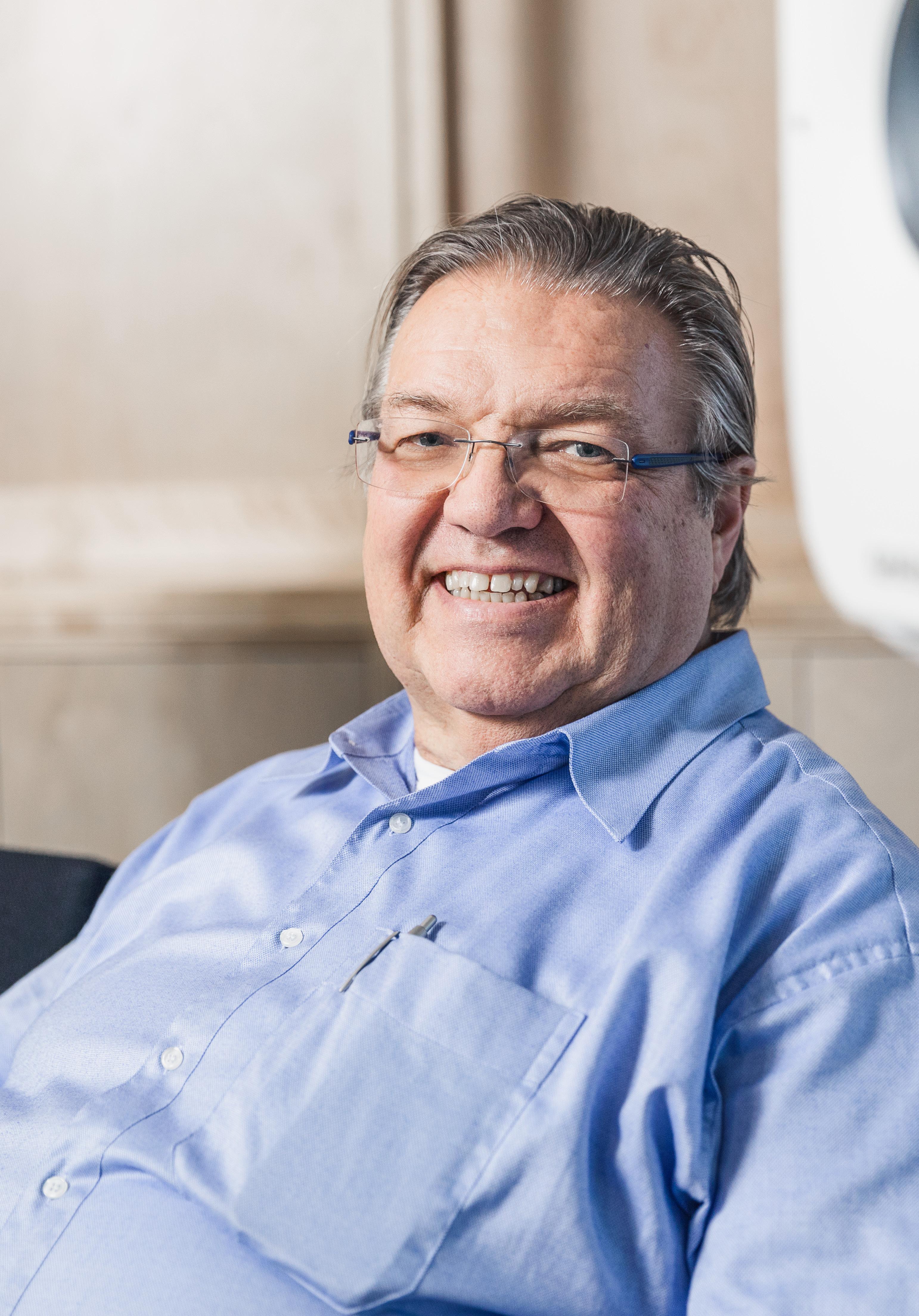
Ever since its foundation back in 1978, Genelec has prided itself not only on the quality of its products, but also the family values instilled into the business by its founder, the late Ilpo Martikainen. Like so many businesses that have grown from family roots into significantly larger, international institutions, the balance of maintaining that family feel with the requisite upscaling and ambition that comes with being a market leader can be tricky, and one that some find easier to achieve than others. In the case of Genelec, as many of its staff will testify, that sense of being part of a wider family network is very much alive and well. But in the case of industry veteran Lars-Olof Janflod, such sentiments are perhaps even more pertinent. If anyone from outside of the Martikainen family, who still own the business, can be considered an honorary relative, it’s him.
“My career with Genelec is longer than 30 years,” Janflod tells Headliner as we join him over Zoom from his Stockholm abode. “My first contact with the company was at the beginning of the ‘80s, and then I started to sell the products alone in 1995 here in Sweden, and then I worked myself into the company. In
1992 I was hired by Ilpo. At that time we were 20 employees, and now we are somewhere in between 250-300 if we count all the subsidiaries we have around the world. There’s quite a lot of us these days.”

For more than three decades, Janflod has not only served Genelec with distinction, but has essentially become something of a brand ambassador. Leading the charge on international sales and marketing, his has become one of the most recognisable faces in the professional studio sector, and one that is synonymous with the company name. It’s a commitment that is seldom seen in the business of pro audio.
“There are various things that have kept me here all this time,” he says, his speech always gentle, his answers thoughtful and considered. “There have been lots of challenges through the years, but the main thing is the people. When Ilpo hired me, we became like brothers. It’s a family company and he brought me into the family. And it’s been a lot of fun, there has been a lot of success… and why would you leave a company that is successful?
“I think everyone who works in the company has that same feeling,” he continues. “I had the privilege to work very closely with Ilpo for a long time, so obviously it’s a different thing for someone who starts today. But I feel that everyone still has that feeling.”
The connection he felt with Martikainen, who died in 2017 at the age of 69 after a long illness, is evidently something that still holds strong and continues to inform his role to this day.

“It was obviously very close,” he says of their relationship. “We had some kind of understanding where we didn’t have to talk that much – and Finnish people don’t tend to talk a lot! And Ilpo was absolutely like that. He would only speak when he had something to say. He didn’t do small talk. For us Swedish people, or at least for me, that was a bit different. In the beginning we travelled a lot together all over the world. And at the time, sales and marketing was basically him and me. Naturally we became very close.”
With a career so heavily defined by his work with Genelec, what was Janflod doing before joining forces with the fledgling Finnish firm?
“I was originally an electrical engineer,” he recalls. “Then I got into the theatre industry through friends. I had friends working in the industry and my training was quite suitable, as there weren’t many trained engineers who worked in theatre. I started in lighting and then moved into sound and stage management.
“Of course, nothing stays the same, so I got more into managerial positions
in theatre... then one day I got fed up with it,” he laughs. “I had been working in a theatre that we built from the ground up. So, I was involved in the sound system for the theatre, buying everything, which got me in touch with a lot of distributors in Sweden, and one of them asked if I wanted to work for them. That’s how I got into audio distribution. That was mid- 80s and they were the Genelec distributor.”
So how did the crossover from distributor to manufacturer occur?
“I was working with the distributor and I just got more and more interested in working closely with the manufacturers,” he says. “And one day I wrote to Ilpo saying I’d like to work for a manufacturer, he got back to me, and about six months later I started working for the company. At the time in 1995 Genelec had built the factory they are in right now, although it has been expanded through the years. My role was to expand the distribution network. That meant a lot of travelling and remote work.”
As our conversation veers towards the subject of career milestones, Janflod points towards what he considers some of the company’s most pivotal moments in its 44 years to date.
“The first one was before I joined, and that was the launch of the 1035, which was in 1989 at AES in Hamburg,” he
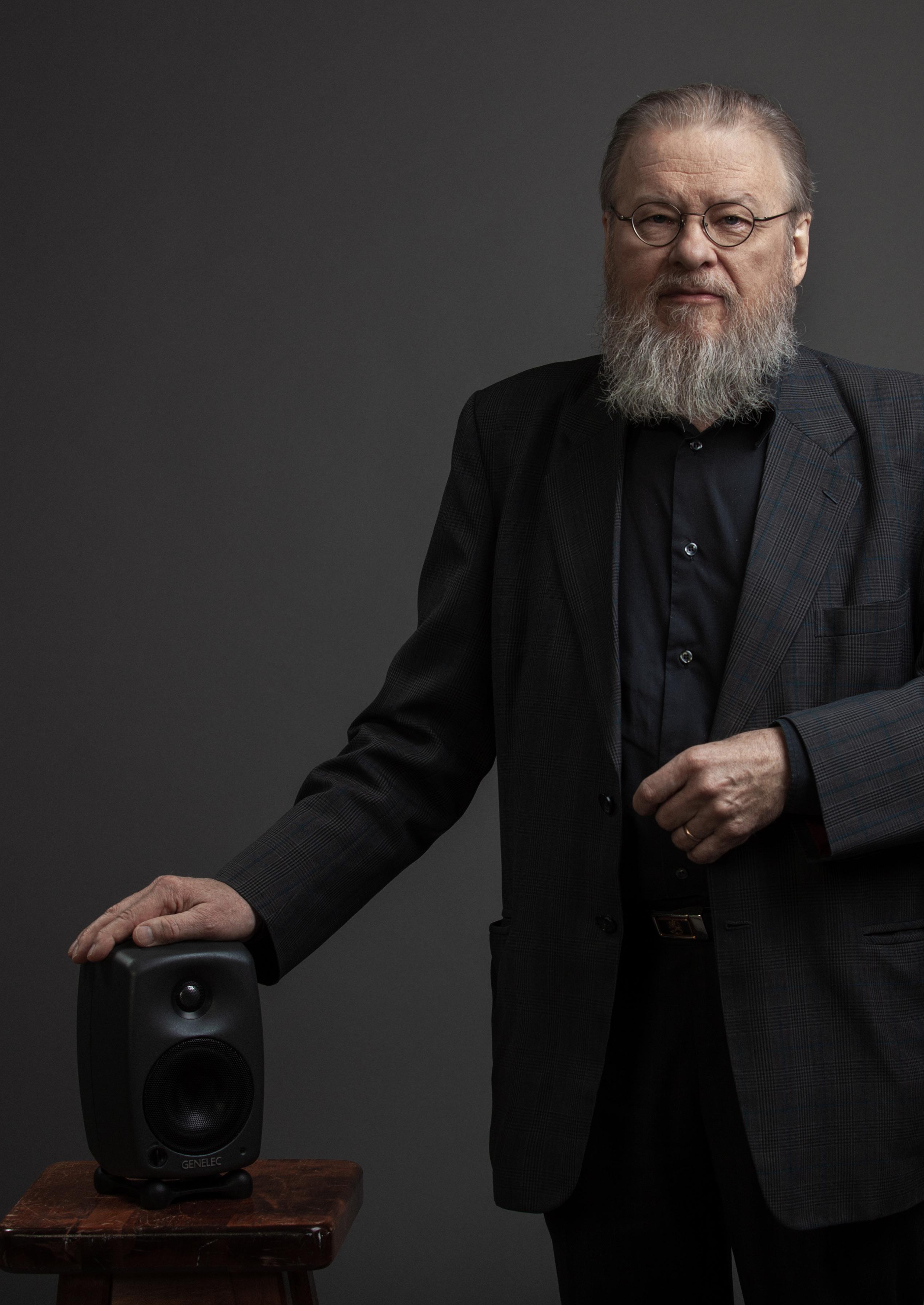
states. “What followed was this scaling down from the big 1035 down to the 1031 and then the 1030 and 1029. They were great years, and fun years, brining so many new products to the market.
“Another milestone was the launch of the 8000 series at the beginning of the 2000s when we realised we couldn’t make these 1030s and 1031s forever. It took several years to come to the conclusion of what we were going to do. And during that era the market changed. Initially we sold quite a lot of big speakers, but it turned gradually to smaller and smaller speakers, and the builds of bigger studios became fewer and fewer. Today, everyone who makes monitors makes their bread and butter off of small speakers.
“Then a big step was going into DSP-based products. Actually, from when I started, the company was involved in developing DSP systems, but that didn’t turn into products until much later.”
The latest milestone for Genelec is its ongoing push into the field of immersive audio. For many years, the company has been investing significantly in this area, particularly in creating spaces in which customers can experience its technology.
“It’s no secret, for many companies immersive audio is the one big thing that occupies our time,” he says. “On the pro audio side, that is basically
what we are looking at. Over the past 10 years we have gradually grown into the AV business, where our IP system has been very successful, and we are looking at developing new products in that line.
“Our DSP-based systems and the calibration and AutoCal algorithm in GLM have been a major focus. We’ve been at it for quite a number of years, long before it became sellable. We have been doing immersive systems at trade shows for about 15 years. The problem has been the ability to demonstrate immersive audio. If you do that at a trade show it is very expensive. Then after three or four days you have to take it all down again. What we are trying to do now is build experience centres. We just had one here in Stockholm, we have one in Helsinki, Berlin, London, Beijing, Tokyo, Boston. These are places where we have been able to build a proper room for proper demos without having to say ‘this demo room is not that good’ at trade shows.”
On the subject of trade shows, he is frank in his assessment of their cost and the change in attitudes towards them from exhibitors.
“I think it will become harder for the shows to attract exhibitors,” he asserts. “When I was visiting IBC this year I heard that next year the RAI will increaser its prices and exhibitors will have to pay for that. Everyone talks about return on investment. At the last
show we did at IBC we spent about €200,000. It’s quite hard to get return on that investment. And in a week, it is just gone. I don’t mean that this means the end of trade shows because it depends on what kind of company you are. We don’t sell direct to end users, we go through resellers and systems integrators.”
For now, in his semi-retirement, Janflod is taking time to help nurture the next generation of Genelec executives and engineers passing through its doors. It’s a role he relishes.
“We have a lot of new people in the company, and my role is to help bring forward and mentor some of these people,” he explains. “I’m basically handing over, seeing through the next generation of Genelec talent.”
The future, it seems, couldn’t be in safer hands.
GENELEC.COM“IT’S NO SECRET, FOR MANY COMPANIES IMMERSIVE AUDIO IS THE ONE BIG THING THAT OCCUPIES OUR TIME.”


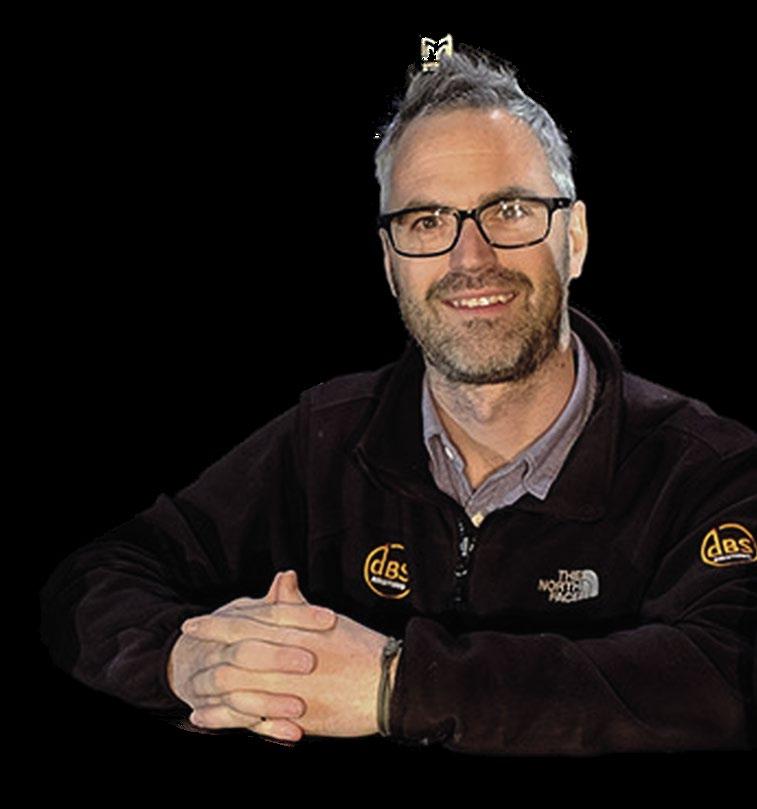

In partnership with Yamaha Music London, Headliner recently offered an exciting opportunity to emerging solo artists in the UK whereby the winner would become the 2023 ambassador for Yamaha Music London’s unique flagship UK store.
The finalists were invited to Yamaha Music London in Soho in December where they performed two original songs. Following this, the judging panel (which comprised Clean Bandit’s Grace Chatto and Yasmin Green, Ash Dutton, A&R at EMI Records, Stephen Davies, retail operations manager at Yamaha Music London, Kavitha Rao, music and marketing manager at Boisdale and Grace Mcguigan, client relations manager at Headliner) deliberated before each artist was welcomed back to perform a third and final song.
After impressing the judging panel due to the high standard of finalists, it was decided that indie/pop artist
Bertie Green and pop artist Beth Keeping would be awarded joint winners of the ambassadorship prize.
Green is an unsigned artist, songwriter and multi instrumentalist from North West London that has played at Glastonbury and writes for a wide range of artists, spanning the genres of folk, pop, indie and rock, and he’s a regular on the live music showcase circuit in London.
“The Yamaha employees and team are so kind,” says Green. “As independent artists, we’re so used to being sold a dream and then you get there and it’s just not what they said. What was so funny about this
was it was the complete opposite – what was advertised was brilliant and you got there and it exceeded all expectations.
“The first note I ever played on an instrument was on a Yamaha piano,” he points out, “so that’s just crazy to think that I started my musical journey on a Yamaha piano and now I’m an ambassador for them. Their grand pianos are absolutely amazing – best in class. To be working with a brand who produces the most beautiful instruments and then also back that up with such a kind, welcoming, warm and genuine love of music is so nice.
“I don’t think that you can put a limit on how important and special this is,” Green says of his win. “Being an emerging or an independent artist in the early stages of your career is difficult for such a range of reasons, so when someone gives you support and space to express yourself in such a genuine way, it is transformative. Beyond that, the biggest thing is the feeling of welcome and love, and knowing that you’re being supported by people who owe you nothing, but because of your craft, they’ve really listened. It just means so much to be working with Headliner and Yamaha who really care and really want us to succeed. When you have that support, that pushes you further than anything, you can’t really put a number on that.”
Joint-ambassador, Keeping is a UK-based singer/songwriter who started out writing for other artists in Singapore, Ireland and the USA before recording her first EP in Nashville. After gaining close to a million views on TikTok over the pandemic, Keeping felt inspired to start focusing on her own music as an artist. Keeping’s desire to champion and empower women is evident not only through her lyrics, but also in her initiative, Write Like A Girl, which shines a light on female songwriters.
“I didn’t really understand how big and important this opportunity was at the time – I just applied and then the more I heard about it, and then when I
got into the final, I started to get a little bit nervous!” says Keeping.
“I’m so excited for 2023 and to be able to work with Yamaha. Their instruments and their brand is just amazing. The first few songs I performed on this beautiful concert grand piano that is worth a lot of money – it’s so big, it’s for huge, orchestral halls – it wouldn’t even fit in my house! It was so beautiful – it was an absolute joy to be able to play my songs on it.
“I’m so grateful to Yamaha and Headliner for this opportunity, because I’ve grown as an artist over the last
year through doing live shows and through social media, and I’ve gained some new fans, but actually, gaining the attention of the industry is a whole other ballgame, and it’s actually really hard sometimes. It’s a real privilege to have this opportunity and hopefully to open some doors that maybe were closed to me before. I’m really excited for these incredible opportunities and to be able to really throw myself into 2023, full pelt, and see what happens.”

“WHEN SOMEONE GIVES YOU SUPPORT AND SPACE TO EXPRESS YOURSELF IN SUCH A GENUINE WAY, IT IS TRANSFORMATIVE.”
As joint winners, Green and Keeping now have access to Yamaha’s extensive collection of award-winning instruments for a year, a free recording session each at a professional studio, a chance to perform at some of London’s best venues (including Yamaha’s Sohobased music store) and will receive exclusive mentorship to develop their future success as artists.
In addition, they will both receive an editorial profile in Headliner, will each be welcomed as a guest on Headliner’s podcast platform, Headliner Radio, will receive three months of PR
support, will feature on Yamaha Music London’s (YML) socials and will be able to use the Yamaha Music London Ambassador logo on all their marketing materials and assets.
“When I was asked to be a judge I had no idea how difficult it would be to get it down to one winner, hence why we had joint winners,” commented Mcguigan.
“Each artist was amazing in their own way; we would have put them all through if we could have! Bertie Green blew me away with his voice
and stage presence – I couldn’t help but smile while he was performing. Beth Keeping’s ability to play the piano and guitar was amazing and her voice was effortless. I feel blessed to have met such a talented, humble group of artists.”
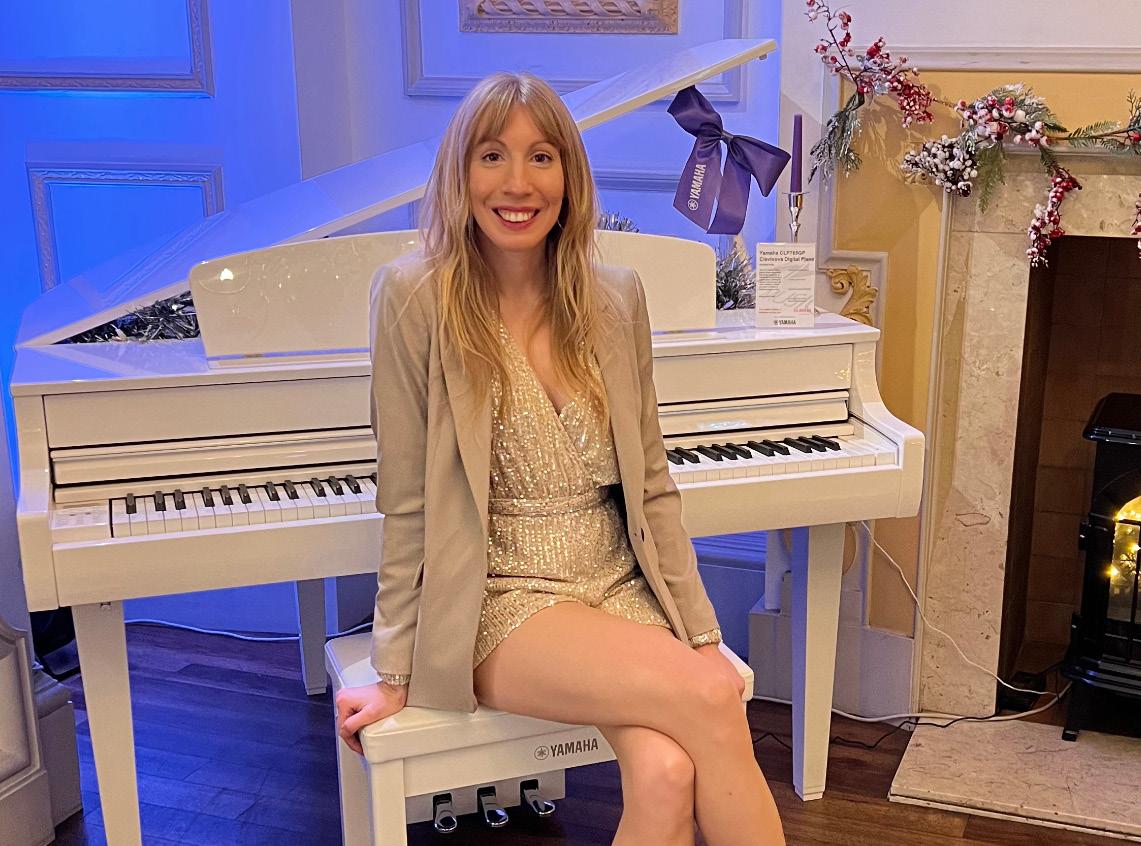

Newton Faulker is never happier than when he’s making his life overly complicated. He explains why his recent UK tour was strangely terrifying, and why he wouldn’t have it any other way.
Faulkner has been making lists and bribing taxi drivers. “I’m sitting in a pile of bags,” he immediately volunteers, speaking to Headliner the day he leaves for his 23-date Feels Like Home UK tour, which saw him return to basics with a stripped back set focusing on the songs that work best with just a vocal and guitar part, minus the usual musical multitasking and live looping which helped make his name.
“I leave tonight,” he says, “so I took most of my gear in yesterday. I had
a very annoyed cab driver who I had to bribe to take all this stuff. About halfway through loading up he just gave me a look. I was like, ‘I’ve got some cash and I’ll give you some sheets to protect the car’. So I had to bribe him, but he was very nice – pre and post bribe, to be fair.”
Faulkner’s last tour involved an immensely complicated setup, “like flying a musical helicopter,” he says, so this time around he was keen to take it back to basics.
“I do feel quite naked. Not now,” he quickly points out. “But in terms of the previous tour, I took the entire studio with me and was doing multi instrument looping. It was ridiculous and very hard work, but very fun. This tour I’m just sitting in a chair with a guitar and yesterday it became very real that that was actually what I’m doing. Strangely, considering it’s where I came from, I haven’t done just what I do without loads of sprinkles and toys and distractions. I was also on a click for the whole tour, so every song I had the tempo in my ear, and I just got used to it. Now it’s just me. It’s strangely terrifying.”
Normally each tour is new recorddriven, whereas Faulkner’s recent tour was named after a song from his debut album which was never even released as a single. 2007’s Hand Built by Robots’ big moments came courtesy of mega hits Dream Catch Me, I Need Something and a
On choosing Feels Like Home as the tour’s namesake, he says he deliberately chose songs that he rarely plays on tour, like Long Shot, Against The Grain, I’m Not Giving Up Yet, Never Alone, Been Here Before and Waiting On You.
“The whole way people consume music has changed,” he acknowledges. “The nature of releasing albums has totally changed. I think with that, touring has to change as well. It can’t be completely project-dependent, so this is more about going with a concept. It’s quite funny that I’m saying this because I’m also massively wobbling on the concept, like, ‘Do you know what? Shall we just change it and take everything?’ But no, we’ll stick to the concept because there’s been a press release, so I can’t fuck that up,” he laughs, adding with mock confidence: “So now I am doing
what I said I’m going to do, very happily, with no fear whatsoever.”
Seven albums down and despite gigging “relentlessly” since the age of 13, Faulkner shares that he still gets nervous before every show –although he mostly blames that on his tendency to make his life more stressful than it needs to be.
“I make my life very complicated,” he nods, “whether it’s the technical guitar stuff or vocal acrobatics, or if it’s all harmonics and tuning pegs – it is truly terrifying. But it’s keeping everything interesting for the audience. Someone came up to me after a festival I did and they said, ‘Every time I’ve seen you, it’s been completely different’ – and I like that. I like the fact that it’s just me, but I think even on my own, it’s important that it’s not the same every time. What I haven’t done for a while is strip it right back and be quite strict.”
He assures Headliner that he includes his biggest hits on his tours, in addition to some that he didn’t realise were fan favourites to begin with, including his debut album’s second to last track, Ageing Superhero
“That dropped off the setlist quite a long time ago, and suddenly I had hundreds and hundreds of requests for it. I was like, ‘Oh, I guess I’ll do that then’. Gotta give the people what they want. So that was surprising. There’s loads of tracks where I was like, ‘How did you even find that?’ There’s songs that I can’t not do, because people really like them, which is a nice problem to have. Then there’s songs that I want to do for me – usually because they’re bordering on impossible. That’s what I find the most exciting: how hard is this? Can I do it without feeling like my brain’s going to explode? If not, then I’m not really that bothered,” he laughs. “I love the fear of really pushing myself, technically and physically. Normally I have to tick those boxes and then promote whatever I’ve just released, but this is outside of the rules.”
Headliner has got this far into writing this without mentioning the obvious: Faulkner is funny. During the interview, he shares that he is “upon the TikTok, doing straight up dance and make up tips”, he’s forgotten to include Dream Catch Me multiple times during sets – “people haven’t complained!”–and that he sometimes adapts the arrangements of his songs as he goes along – “probably a terrible idea”.
His self deprecating sense of humour is what makes him so likeable. On his recent early morning ritual of “noodling” on the guitar for two solid hours, he admits he got the idea from a cellist. “Yep, I totally stole it. This cellist, who is a friend of mine, gets up very early every morning and plays for two hours. I thought, ‘That sounds delicious. I’m having that.’”
He also embraces the uncertainty of leaving a gap in his set list for a mystery song, which could result in anything from incorporating Kiss The Girl from Disney’s The Little Mermaid into the gig, to using the ‘80s X-Men theme tune as his entrance music.
“I MAKE MY LIFE VERY COMPLICATED. NOW IT’S JUST ME, IT’S STRANGELY TERRIFYING.”
“I’ve got so many theme tunes in my head. I’m an encyclopaedia of useless theme tunes. I’ve never even seen The Littlest Hobo and I know the theme tune. Around The Twist,” he throws out, on a roll now. “It’s a stone cold classic. There is a mystery cover I’ve been bouncing around that I haven’t done live,” he ponders. “I’ve done bits of it, but I’ve never done the whole thing. I could just whip that out…”
Anyone that has seen Faulkner live will know that he has a knack of pulling people out of their shells. Even the most reserved audiences are no match for him.
“Crowd participation and some of the out-and-out stupidity really helps loosen up the room,” he smiles, recalling one particular night at the Royal Albert Hall.
“I’ve done such stupid things in such lovely places. I was opening for John Mayer and I was four songs in. Everyone was sitting very still, clapping very politely and stopping
very abruptly. You could feel the pressure of the situation on the crowd itself, like, [his already well spoken voice kicks up a notch] ‘We have to behave. It’s very serious, be serious’. There was that kind of vibe, but I wanted them to get involved. I was like, ‘If you get involved with this, I’ll do something really stupid. Then you’ve got something, I’ve got something – everyone’s happy’. So they did amazing three-group crowd participation, which I wasn’t expecting them to do as well as they did. In exchange for that I played the SpongeBob SquarePants theme tune. When I did that, it was like the entire room changed shape. It had a tangible effect on the air in the room itself. Everyone relaxed and it was amazing.”
When asked what the best UK crowds are, he doesn’t hesitate: “Manchester’s always good. Dublin’s always amazing. London…I don’t want to jinx this, but it has been consistently one of the best shows for the last however many tours, which is not what anyone else says, ever.
“There are sections in songs that I put in just for the crowd to sing,” he adds. “It’s amazing when I don’t say anything and people just start doing bits because it makes me sound amazing, because I’m just sitting playing guitar and people are literally doing BVs for me. Everyone approaches live performance differently though. With me, my set list always has loads of question marks and gaps where I’m like, ‘I don’t know what’s gonna happen here, but let’s leave a gap and see what transpires,’” he laughs.

That reminds him, he’s got some last minute planning to do:
“I need to finish my list. I need to get out the door. I’ve got a whole satchel – I’ve never said satchel in my life – of effects pedals to go and play with. I’m off to bribe some more taxi drivers and fill up my satchel. I’ll take my lunch pail.”
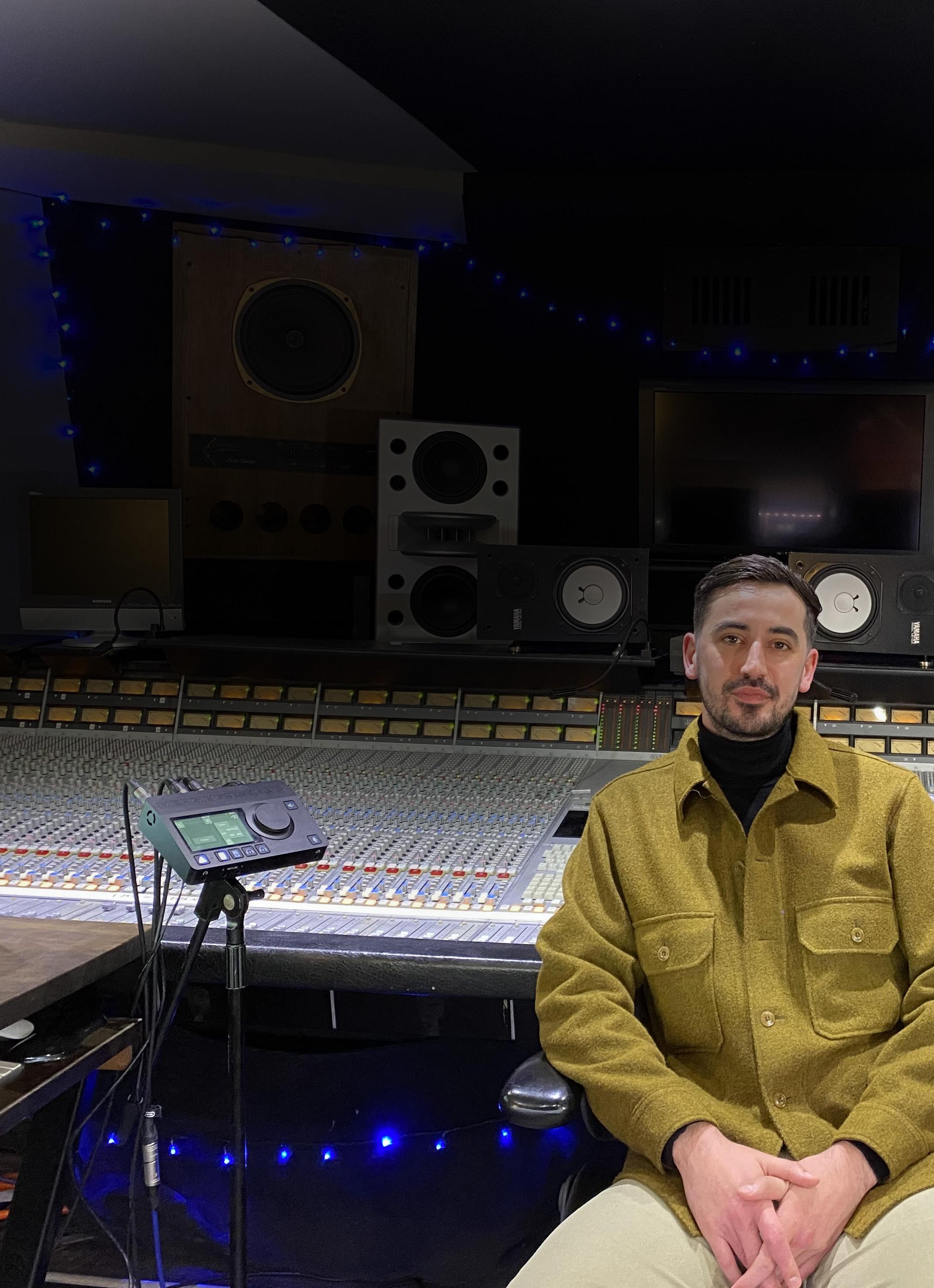
“One day you could be recording a string section, the next you could be recording a Skepta vocal or a soprano. So having something as solid and easily portable as the Anubis interface, which sounds amazing every time, is priceless.”
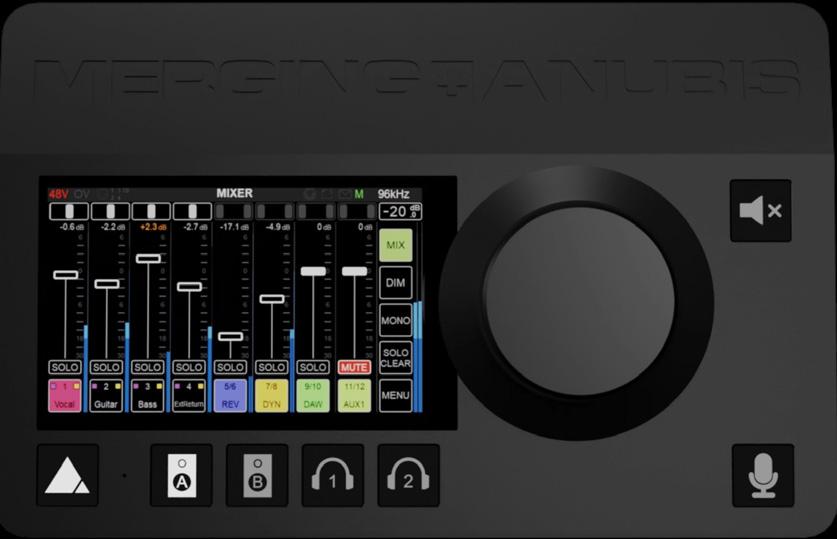


A leading British producer has revealed the secret behind his awardwinning success: using Neve equipment.
Sound engineer Matt Taylor was honoured with the award for Rising Star at the Music Producers Guild (MPG) Awards 2022, thanks to his stellar rise to the top of the British recording industry.
Taylor has gone from strength to strength after graduating from the prestigious Liverpool Institute of Performing Arts (LIPA) just three years ago, with a degree in Sound Technology.
The producer, who is based at ARC Studios in Eynsham, Oxfordshire, has worked on a host of projects for big names like Ninebarrow, alongside
noted audio engineers including Rich Costey and Troy Miller.
Taylor also co-engineered Frank Turner’s album FTHC, which topped the charts when it was released last February, and credits that success with his recording equipment.
“When recording Frank’s amazing voice, we had a Townsend L22 mic going into two 1073LB preamps,” Taylor reveals. “The Neve sound is versatile, clean, larger than life, reliable, sublime, compelling, and just amazing.
“There is something in the way the transformers of a Neve preamp clip the transients in such a musical way, that it is just so tantalising, and even addictive. Neve equipment always adds magic to a song; it’s something you just can’t quite put your finger on, but it always works so well.”
Designed and manufactured in England, the 1073LB uses the same architecture as the original 1073 preamplifier packed into a single 500 series module.
The guitars featured throughout FTHC, Frank Turner’s ninth studio album, also went through Neve 1081s. Designed in 1972, the 1081 classic was originally conceived as a combined mic/line preamp and equaliser section for the Neve modular consoles.
“We had a setup where we split the feed of the guitar into three separate amps in the live room and summed them all together through the 1081 unit,” adds Taylor. “That iconic EQ sound was a real chef’s kiss.
“Within every industry, a particular name becomes synonymous with innovation, quality, and excellence, and when I think of professional audio equipment, I think of Neve. It is a rite of passage for every aspiring engineer and producer to use a piece of Neve equipment.
“It’s a benchmark of a shift from hobby to professional, and I remember my first time as clear as if it was yesterday.”
ARC Studios houses the Neve 1073LB and 1081 Classic, which Taylor took full advantage of while recording Ninebarrow’s award-winning folk album A Pocket Full of Acorns.
He continues: “Neve consoles provided a warm and succulent bottom end, sprinkled with saturation, as you would expect. Where it really came into its own was how it tamed the transients of the double bass, in such a musical way.
“It’s always the Neve for that lovely tickle of low-end saturation. However, right now, I’m really into using them as a super aggressive DI distortion for guitars. Opening these preamps just projects so much energy into the recordings, they feel larger than life.”

Taylor was over the moon when he was named ‘Rising Star’ at the MPG Awards in June, as the event was held on a special anniversary for him.
“My interest in music production began at school, but because I was in the care system, I did not have many opportunities to pursue my dreams when I was younger,” he explains. “This year’s MPG Awards were held on the 10th anniversary of me leaving the social care system, so the award was doubly special to me. To be recognised in this way by my industry is surreal, and an honour.
“This is a brutal industry for a care leaver, where having no family or financial support makes it nearly impossible, but I hope that my success will now begin to shift the tides so more people like me can survive and thrive in recording. I may be the first care leaver to win an MPG Award, but I’m going to make sure that I’m not the last.”
Taylor had also been supporting the MPG by creating newsletters for members during the pandemic, which provided information and updates about government announcements, and how the guild was helping them. He was honoured with a place on the MPG board, where he has been advocating support for people from disadvantaged backgrounds like his.
He has since worked on campaigns including MPG’s #KnowYourWorth, and supported organisations such as #TheWrd and We Are Punch.
MATT-TAYLOR.UK AMS-NEVE.COMTransparent – picks up the true sound of the drum
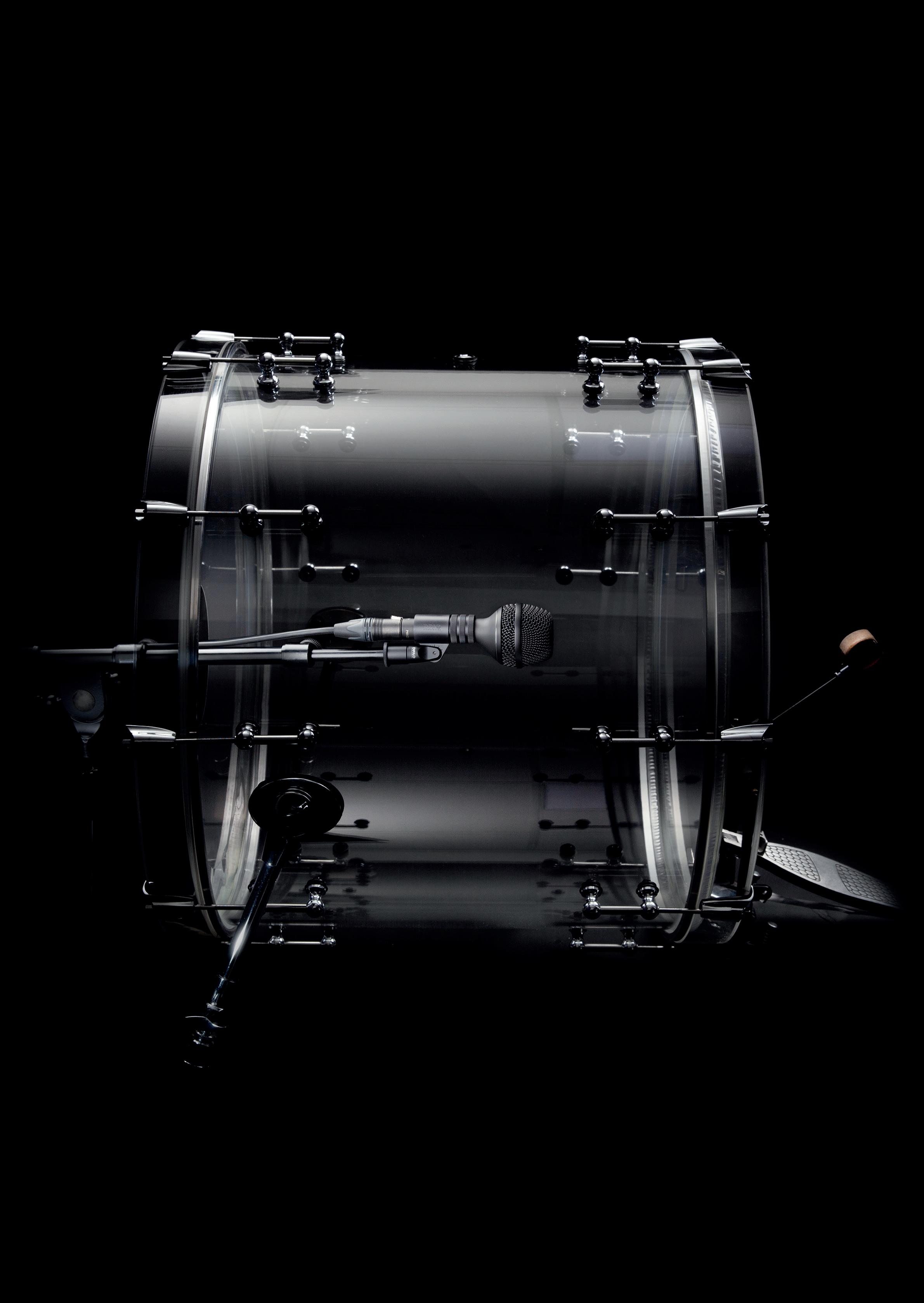
Versatile – allows you to shape the sound you want
Tough – withstands rough use on the live stage
Flexible – effortless placement inside or outside
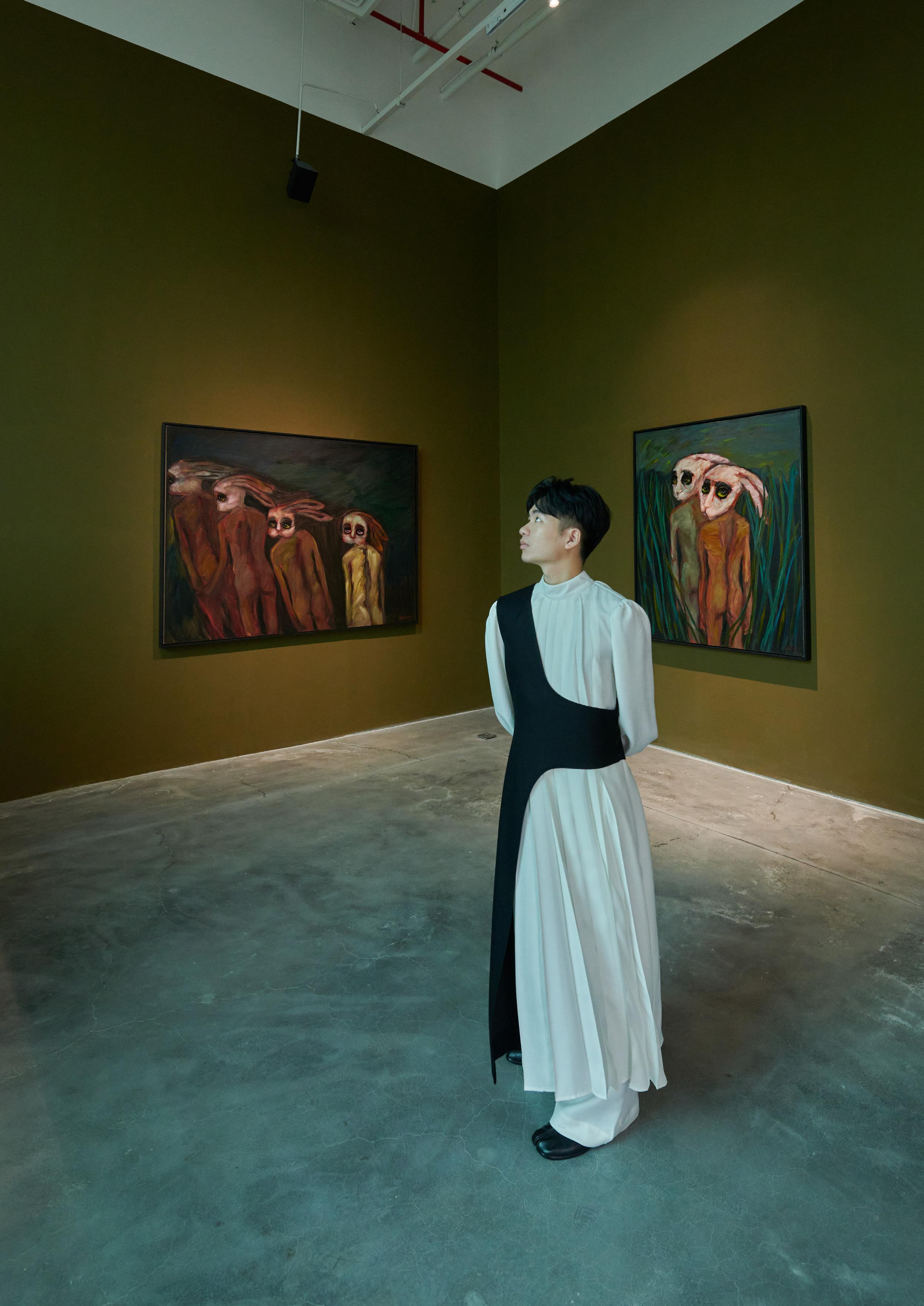

Vietnamese artist Pham Minh Hieu recently specified a d&b Soundscape system to serve as a vessel for his artistic expression on his latest project The Contemporary. Headliner spoke to him about the installation and the role that Soundscape played in bringing it to life.
Through a collaboration representing the awakening of Vietnamese contemporary art culture, Pham was commissioned to create an installation for the unveiling of a new art space based in Hanoi called The Outpost. The installation, which runs from November 29 2022 to Feb 28 2023, honours the past of Vietnam, recognises the present, and looks to the future by bringing together six Vietnamese contemporary artists of all ages and demographics.
Pham Minh Hieu’s work titled The Contemporary is described by the artist as a “total installation” that takes audiences on a journey through the history of artistic expression in his home country, with the audience guided by footsteps of ‘wanderers’, helping them picture the Vietnamese contemporary art landscape. The installation uses d&b Soundscape to bring the sound of the invisible wanderers alive as they roam the exhibit, evoking their presence and
superimposing their realms onto the physical site of the exhibition.
“With traditional sound systems using level panning it would have been impossible to achieve spatialisation so quickly,” said Ningru (Ning) Guo, sound designer for the production. “d&b Soundscape is a great system for this purpose since it supports objectbased audio and is easy to use for scenarios where audio needs to be moved around the space seamlessly. In The Contemporary, the sound system is placed in different rooms and we have to send contents across these rooms to trigger much bigger sound events to achieve a tsunami of sound. Soundscape’s visualisation of sound makes it much easier for everyone involved in this project to understand how sound travels from one room to another room and how we can design the sound to interact with the museum visitors.”
“I created this work from the foundation of Whitehead’s process philosophy, which argues that reality is a series of perishing events,” Pham told Headliner “Thus, I designed The Contemporary to be a contingent reality consisting of such a series of events that are either continuous or superimposing on one another. At the exhibition space, The Outpost, these events can take place indeterminately in one or multiple galleries at a time.
“I chose to work with d&b Soundscape because its object-based mixing allows me to control sound sources as individual objects and create events by programming the movement of these sound objects.
“Since the wanderers of The Contemporary move from one gallery to another, it’s crucial for the audience to perceive these movements.
Soundscape’s source localisation capacity can afford this. As the sound object moves from afar to up close or as the volume of each sound object alters, the calculated delay evokes clear presence of invisible wanderers.”
By using En-Scene, a sound object positioning tool, Pham could work with the individual placement and
movement of up to 64 sound objects. As audiences make their way through the non-linear exhibit, these ethereal presences will be heard not seen, as Soundscape guides visitors through the works of other artists, allowing them to attain multiple perspectives of the exhibition and come up with their own definition of ‘Vietnamese contemporary art’.
To add to the “total installation” concept, there are scenarios in which Guo and Pham planted triggers around the gallery to increase interactivity and engagement. These triggers were able to respond to the various distances and sounds from the visitors with various predetermined sounds designed using Soundscape to transform the gallery experience into a fully immersive one. In this case, the actions of the visitors would also result in a consequence which is translated aurally.
Complementing Soundscape, the team also utilised d&b’s xS-Series. With their unobtrusive cabinet design the xS loudspeakers are suited for a contemporary art space like The Outpost. For added flexibility, rotatable horns enable the loudspeakers to be deployed in either orientation, while the cardioid subwoofer technology
delivers low frequencies exactly where needed and not behind the system. This setup helps the system to hide at the peripheral of the visitors’ attention when they are musing on other artworks and can easily return to their focus once the sound plays.
This is the first time d&b has worked on an art installation in Vietnam, with the exhibition pushing the boundaries of Soundscape, something that the d&b team was very willing and excited to take on.
“d&b had faith in me as a young creator, and supported my work,” said Pham. “I highly appreciate the collaborative spirit demonstrated throughout this project. They were supportive from the very beginning. From the first online consultation to many in-person meetings and experimenting in their workshop, they were willing to share extensive and in-depth information about the system. On top of that, d&b had also connected us with other creators in their network which played a crucial part in the success of The Contemporary, a highly collaborative project.”

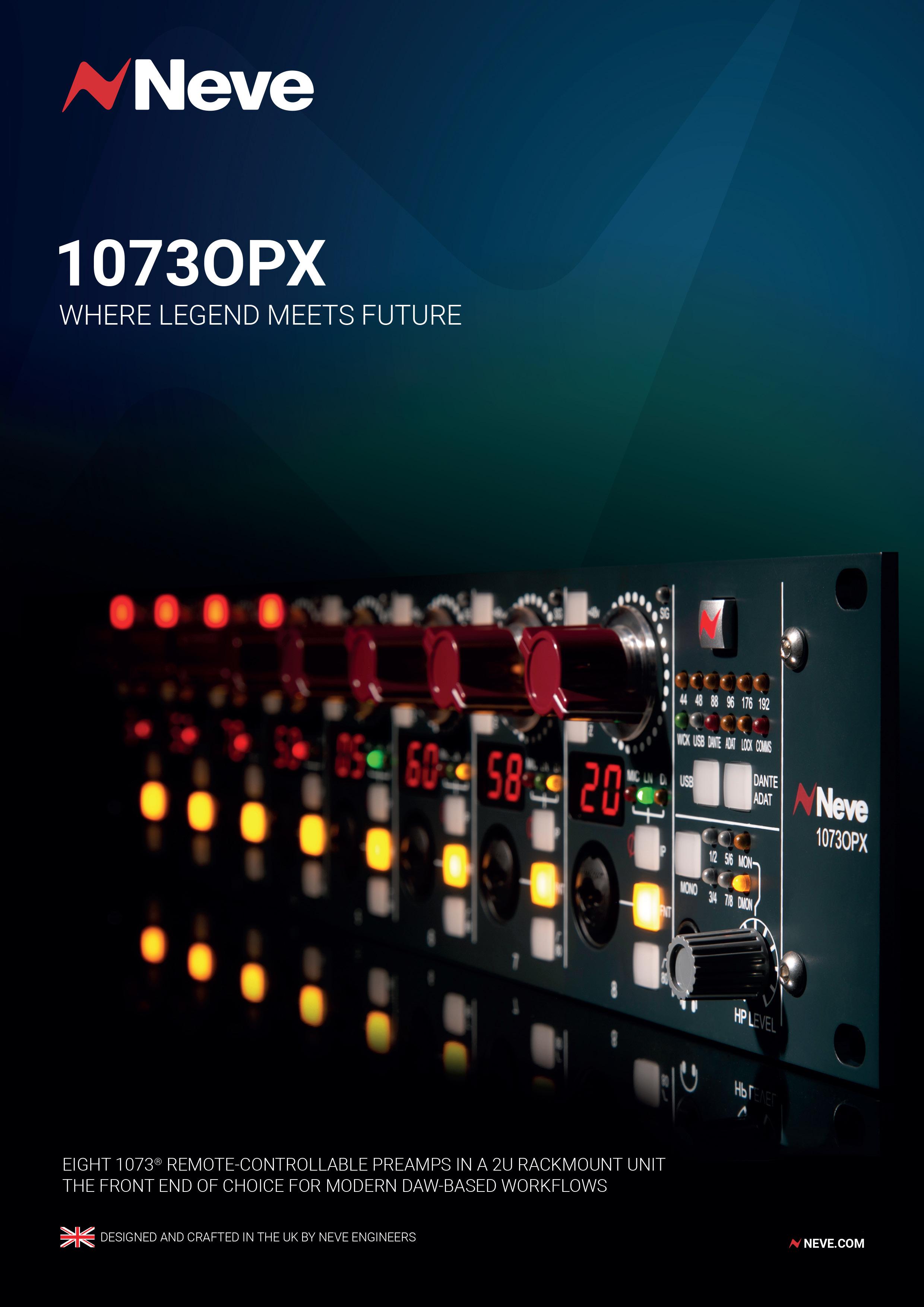 BY DAN GU M ELB
BY DAN GU M ELB
Outernet London an immersive atrium, complete with the largest deployment of video screens in the world at the entrance of Tottenham Court Road tube station. The project also incorporates the opening of a new 2,000-capacity multi-purpose entertainment venue, the restoration of the iconic 12 Bar Club, as well as a new music-driven focus on the area’s surrounding retail outlets, celebrating the location’s storied musical history.
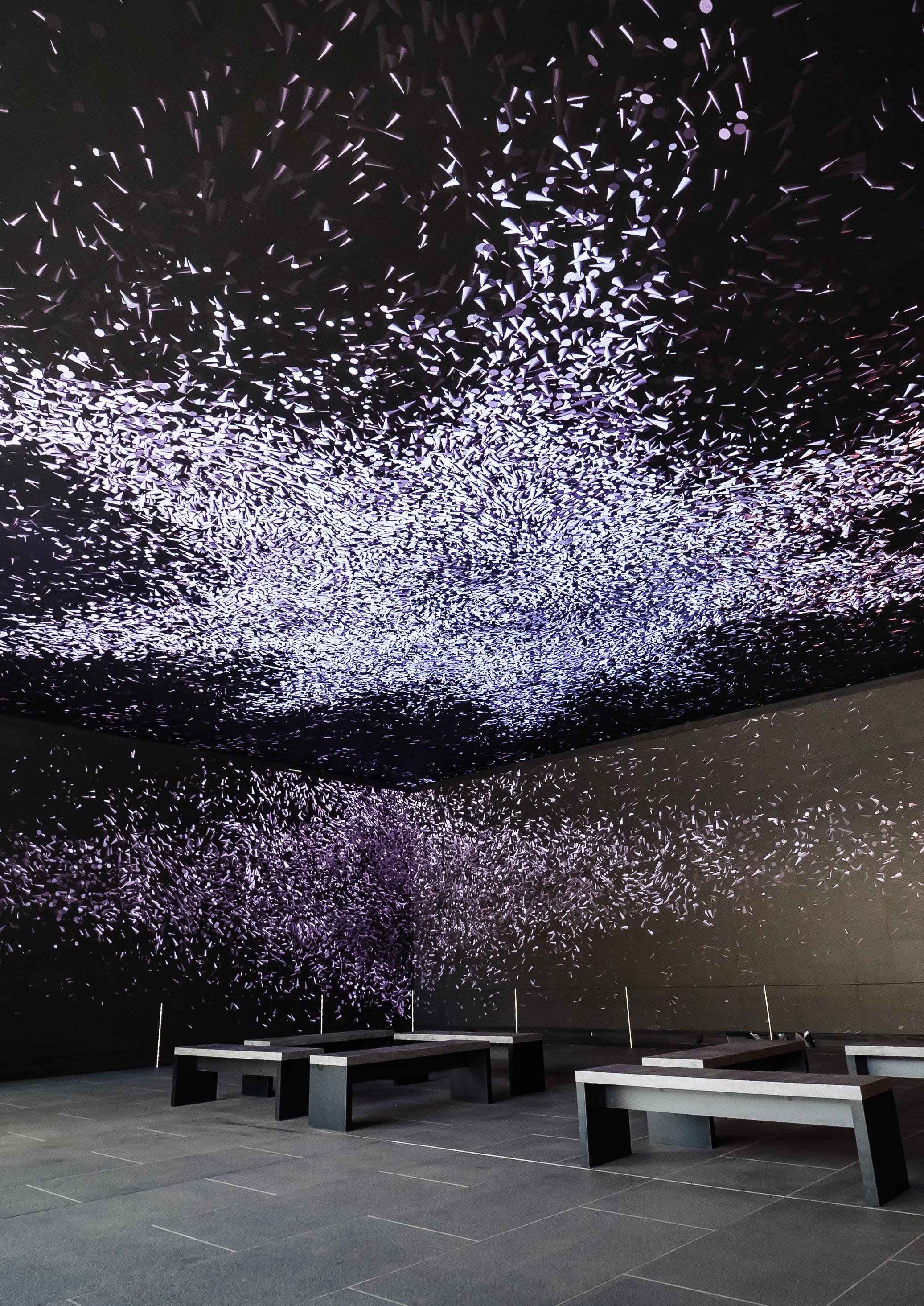
Working closely with the UK music industry, Outernet has teamed up with the BPI (organiser of the BRITs) in a partnership that will see BPI-
related music and video content beamed onto the vast screens in the Tottenham Court Road atrium. This content, along with content curated by Outernet and its various partners, will run throughout the day and the evening. According to Outernet, projected footfall for this space is in the region of 400,000 per day.
Speaking to Headliner earlier this year, Outernet CEO Philip O’Ferrall made clear his intention preserve and nurture the location’s musical heritage.
“It’s absolutely our core focus to retain and breathe more life back into the music district,” he said. “And we’ve demonstrated that by firstly keeping and adding music retail to Denmark Street and we’ve removed some of the shops over the years that were not in the music sector. There was a bookies and a hairdressers that are leaving the site, and instead we bought in a tattoo shop, which we sort of put in the music category. Roland pianos just came back to the street very recently,
so our intention is to keep fostering Denmark Street as the home of British music. And, as you’ll have seen through our partnerships with the BPI and launching the Brit Studio on Denmark Street, there is a massive commitment from us to the live music scene.”
For CTO Whittaker, who was tasked with assembling a team to handle the full tech spec for Outernet, the first task was to fully grasp precisely what the space required.

“The key was understanding the requirements and the tech stack for this weird and wacky space,” he explains.
“It’s been designed from the ground up very much as a multi-purpose space.
It’s not just an event space, or an art gallery, or a retail space, it’s all of those things. I’ve been overseeing the design, the build and now the operation.”
Despite the striking visual nature of the project, a top of the range audio component was always going to be paramount.
“I have a background as an audio engineer, so for me the audio has to be equal,” he states. “It’s very easy to make things all about the visuals, but it’s the audio that is going to lift the audio off the screen; it’s the audio that is going to lift the hairs on the back of your neck.
That is what is going to add that true sensory dimension.
“What we were looking for, and this goes throughout my approach to the technology, was not just a supplier but a partner. There is going to be a network of these sites, and I want to try and bring a similar tech stack to all of them. So, we want a partner that will work with us on all of these and bring consistency. It’s important for us, our clients, and artists to know what we are working with. An immersive LED space presents some acoustic challenges; we have created an experience that sits inside a glass box. It’s glass walls all around, so it’s very acoustically challenging and we needed someone who understood that. And there aren’t many who can truly deliver to that.
“They showed us that they truly understood what we were trying to do, and they had good products that fitted what we wanted to do. Through the relationship between us, L-Acoustics and Solotech who did the installation, we got to know the space together and we were adapting and changing as we went along to get the right results. And the whole team at L-Acoustics has been really collaborative. And, of course, it was important that we were working with a brand that was respected in the industry.”
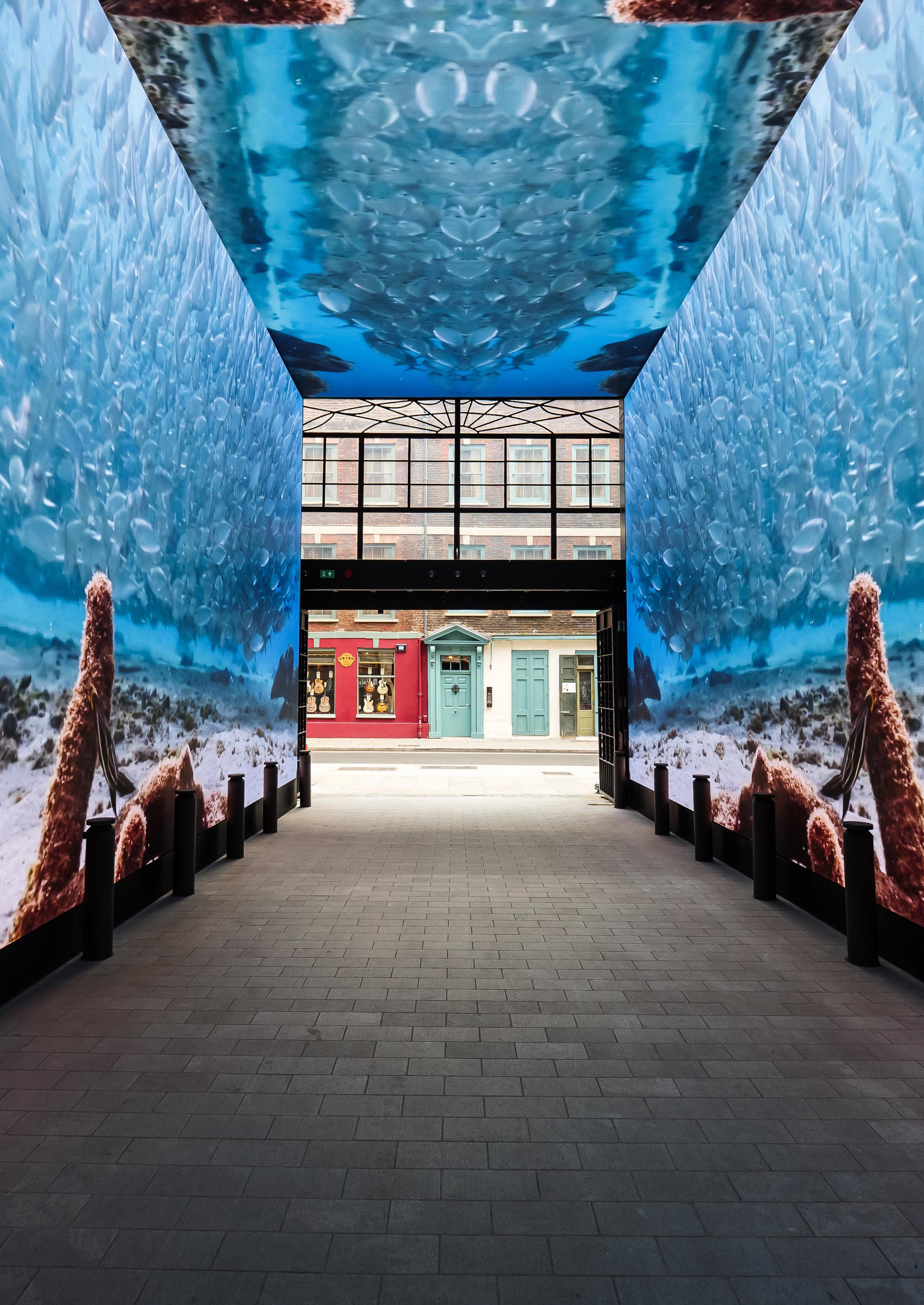
“IT’S THE AUDIO THAT IS GOING TO LIFT THE HAIRS ON THE BACK OF YOUR NECK.”
So what sort of opportunities does the space open up to musicians and performers?
“The short answer is that you can do anything you want,” says Whittaker. “We have about 320 audio channels across the whole district and there are 96 audio channels in the main Now building. That means you can do everything from mono up to Dolby Atmos, and then if you were to get into installation design, we have L-ISA, so you can really start designing an installation.
“What we wanted was a solution that makes it easy to do any of these things.
And there is also that ability to create in an immersive space. We don’t just want flat audio. We can essentially work to a blank audio canvas.”

As mentioned previously, an optimum audio solution was always a priority, but did Whittaker and his team encounter any issues with regards to the positioning of loudspeakers interfering with visuals?
“In a word, no,” he says. “That’s because there are so few places you can put loudspeakers in there, so they either go in or they don’t. The ability that L-Acoustics gives us to do virtual positioning really helps us.”
With a network of Outernet spaces in the pipeline, does he anticipate that he’ll be working with L-Acoustics across the full rollout?
“That is my hope,” he concludes. “I want to grow this out rather than having lots of disjointed islands. I think each space is going to be different but I very much hope we will be working with the same partners.”
L-ACOUSTICS.COM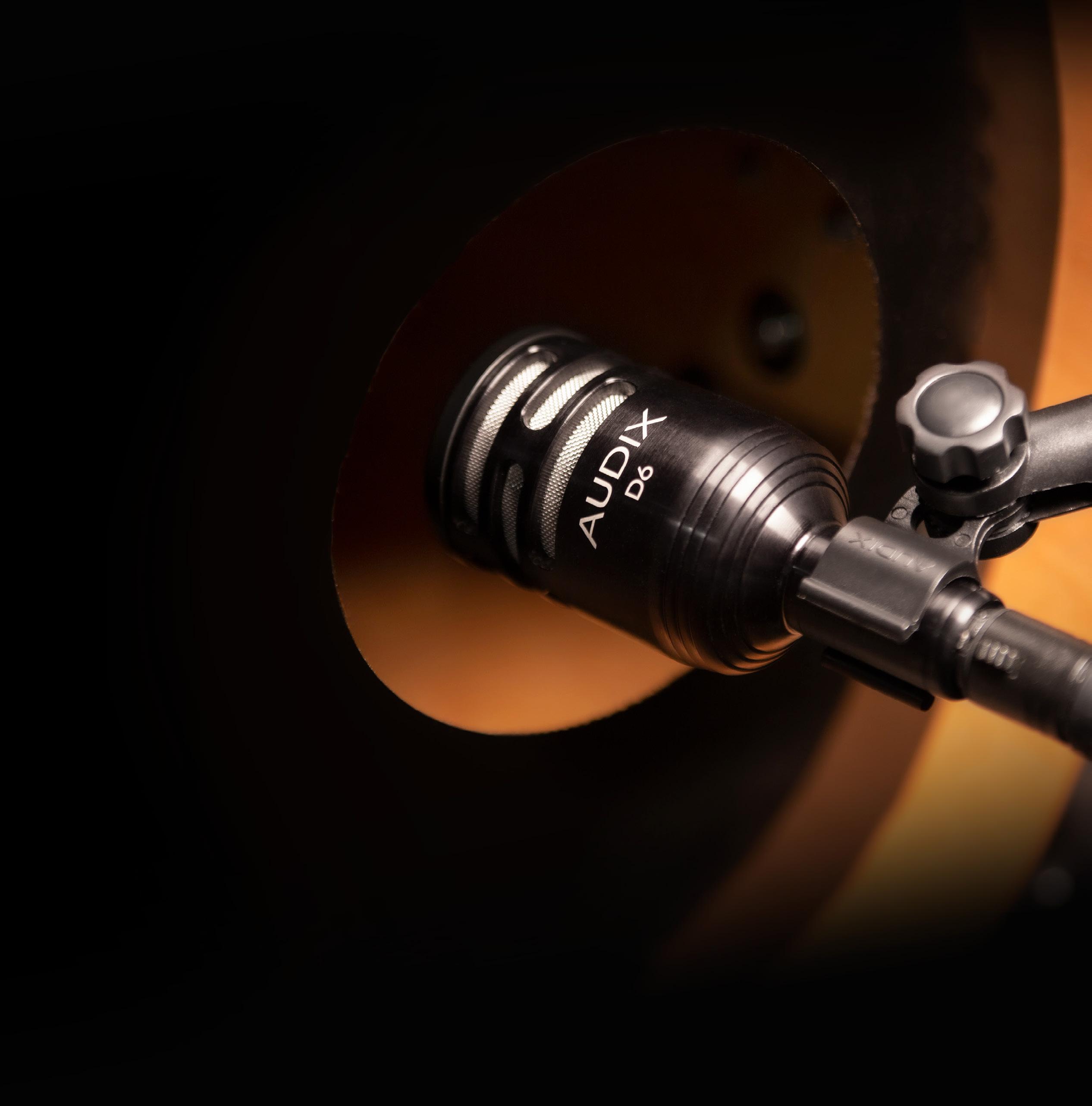


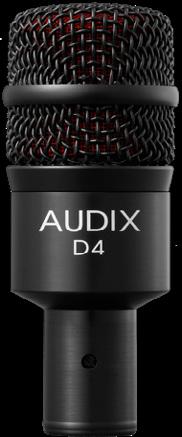





Up-and coming pop singer-songwriter Juls sits down for a chat with Headliner to discuss songwriting, her personal career highlights to date, and the release of her latest single, Heartbreaker…
Can you give us the lowdown on your most recent single, and how it came together from a writing standpoint?
Heartbreaker is this badass, empowered, but kind of deeper, darker song. The song I put out before was a bit more lighthearted and lovey-dovey, but with this one I feel like I really got to showcase a lot of the Lana [Del Rey] influence in my writing. So that was really exciting for me, and really cool, because that’s what I love to write the most. I just wasn’t sure how people would vibe with that.
It’s scary and exhilarating, and you get this wide array of emotions every time you put out music, especially when you’re trying to define your sound as a new artist. I was really blown away by how many people were sending me love about the song in my DMs, because for me that was validation on some level that it’s okay to showcase different parts of my voice and my sound, and people dig it.
The song was written because I started observing this really interesting cycle that happens when somebody
is really heartbroken, they kind of go off on this tangent of breaking other people’s hearts, just so that they don’t get theirs broken again. So it was that cyclical nature of heartbreak that really interested me, and I was thinking about that in my bedroom one day in the middle of summer –how can I turn that into something catchy? What it turned into was, heartbreak makes a heartbreaker – it’s kind of looped on repeat throughout the hook.
How do you usually go about songwriting?
It’s so different every single time it happens. I very rarely, at this point, sit down with the intent of writing. I kind of just go about my day, and all of a sudden it’s like an alien is zapping me, downloading this amazing chorus in my head. With Heartbreaker, it was so special to write because it was very natural. Most parts of the song I wrote in my bedroom, and the lyrics came very organically. I usually start by messing around with melodic structures on my voice notes app, and then I fill in the blanks with the words.
I think that the reason why I love songwriting so much is because it feels so organic and pure and untainted. To me it often feels raw and vulnerable, like inhabited emotion. It’s like pulling down the mask, letting yourself feel whatever you want to feel in the
moment, and not worrying about how that’s perceived. I always go back to my bedroom to write, because that’s where I’m most vulnerable.
Can you tell us about some moments in your career so far that have been particularly special for you?
In the music industry, you work for two years behind the scenes getting a song to the point where it feels right and you’re ready to release it. At the start of my journey I was working in a lot of different studios with a lot of different producers, trying to find my sound and the right person to help me bring it to life. One of these magical moments was meeting the producer that I worked on the EP with – Alex Fumo.
It’s rare to come across somebody who can just take what you hear in your head and interpret that so
beautifully, and make it tangible reality. Alex is precisely good at what I’m not good at, which is production. Although I feel like I’m a very confident songwriter, I always had a very distinct production vision in my head, and I could never really find the right person to bring that to life with me. And so the day that I finally found someone who just understood everything I had been trying to describe to different producers – that was a really special day.
“A LOT OF THE VISUAL CONTENT THAT I HAVE PLANNED IS GOING TO BE VERY FUTURISTICALLY DRIVEN.”
What advice would you give to emerging artists who are looking to break into and navigate the music industry?
I would just say, try to sit back and relax. I know that sounds so counterintuitive, but with me, I felt like I was trying so hard to make things come together. The truth of the matter is, all you can do is get as good at what you do as possible. Sit in your room, practice your guitar, write your songs, list how you want everything to play out and how you want it to sound. We have this inclination as human beings to want to push harder to make things go a certain way, but
sometimes the best you can do is put yourself out there and work as hard as you possibly can.
I love dreaming and I love daydreaming. The next song I’m working on I think has some really cool ideas exploring what’s coming next. I have this fascination with the trajectory and evolution of our society – the meta, what clothing might look like in 30 years and stuff like that. So I’m really excited to see how that gets imbued in my musical journey moving forward, because a lot of the

visual content that I have planned –once I’m able to bring it to life in its fullest capacity – is going to be very futuristically driven. My music however is very romantic and old school, so it will be cool to see how that dichotomy works. There’s just so much to come, so stay tuned!
POWERED BY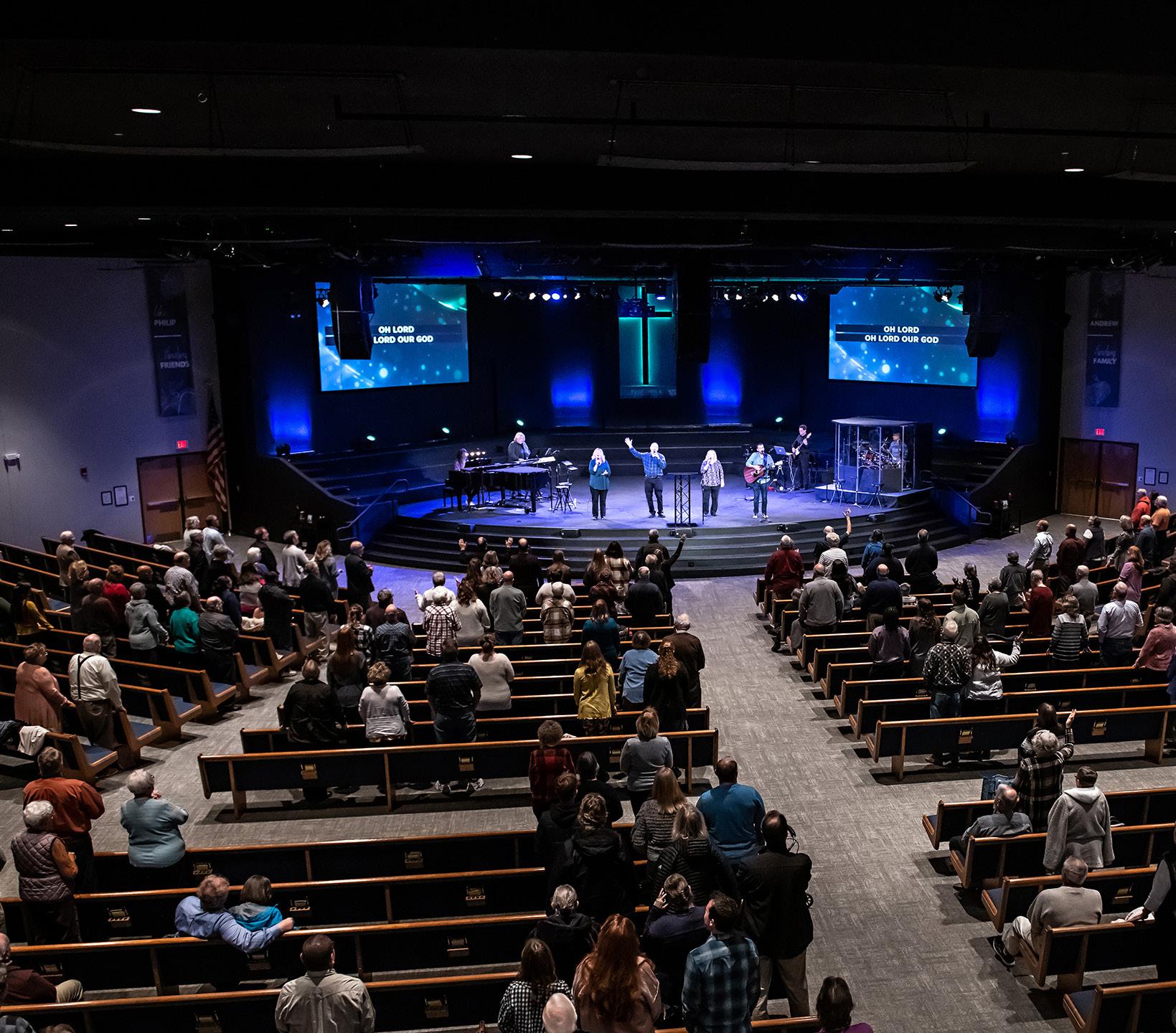
Based in Des Moines, Iowa, Conference Technologies Inc (CTI) recently completed a sound system integration at the nearby Grace Church, in which the previous PA was replaced with the constant curvature technology of Martin Audio’s TORUS array.

The installation is the latest in an ongoing series of AVL upgrades at the church undertaken by CTI over the past 10 years and is designed to meet the high demands of a Southern Baptist church, whose
worship ministry is based around bands, choirs and orchestras.
Led and overseen by worship pastor, Michael Hoskinson, the old PA, which had been in place since the church opened, was said to be providing inconsistent coverage across the 1,200-seat fan-shaped auditorium and was ready to be retired. It was also ‘visually obtrusive’.
“What we were looking for instead was a line array that would provide
even coverage everywhere,” says the pastor. “And so we were looking for a system that would enable the subs to be flown, and at the same time provide better coverage.”
CTI’s VP systems integration, Tim Wright, spearheaded the integration.
“The frequency response from front to back and side to side was not good, and it had never been tuned to the room. As technology has advanced, and our needs have become more critical with regard to frequency response, so our expectations have changed.”
Wright devised a wish list and discussed his requirements with Martin Audio North America.
“We had a couple of runs with their design engineers and felt the coverage maps could still be improved. Then expectations leaned towards TORUS, and I knew that solution was spot on. I had heard the system at a trade show and knew exactly what it was capable of,” he explains.
“Sonically I have always been impressed with the vocal quality of Martin Audio and TORUS is a level beyond that. I tested it with a CD and the clarity was fantastic; for the price point Martin Audio hits, this is second to none.”
“From the other integrator options I was given we could have spent double the money for the same result,” Hoskinson adds.
Wright elaborates that he had presented four different options, meeting different price points.
“When I was asked which one I would recommend it was a no brainer,” he says.
The constant curvature array is designed for applications that
typically require an optimum throw between 15-30 metres, and where a full-blown line array or point source solution may not be appropriate. The T1230 offers a vertical pattern of 30° while T1215 offers 15° but both then have a flexible horizontal pattern that can be manually adjusted between 90°, 60° or 75° (asymmetrically).”
While Wright has long been a fan of Martin Audio, he admits that CTI has only recently turned to Martin Audio.
“Although I have installed the brand previously this was the first big chance to do something of this calibre and size,” he says.
The Grace Church installation was not without its challenges, including locating the three hang points, with a confined workspace above a harddeck ceiling. But an L/C/R system was duly implemented, with a combination of two TORUS T1215 with a T1230 underneath, backed by a pair of SXCF118 18in cardioid subs, on each
hang, driven by four iKON iK42 four 2500W Dante-supporting processcontrolled amplifiers. A further pair of Martin Audio’s high-powered XD12 12in point source speakers were deployed as corner fills and seven of the ultra-compact DD6 6.5in speakers placed around the perimeter of the stage for close front fills. “It was having fill speakers around the lip that the old system really lacked,” says Wright.
In addition to providing optimum coverage, the new fit-out also meets the aesthetic requirement, since the ceiling is now painted black, and the speakers blend in seamlessly. Hoskinson is also pleased to have the subs up in the air, noting that while the trim height of the hang is now lower than previously it does not intrude on the two-screen projection set up.
“The whole thing looks really sleek now,” he notes.
When Martin Audio’s Will Harris came to commission it, “as soon as it was
physically turned on it sounded great,” adds Wright. “It sounded exactly like it looked on the engineering document. Any DSP that was needed was built into the amps. [iKON] is a complete process-controlled amp for a good reason because it is designed to work together [with TORUS].”
Hoskinson shares his enthusiasm, especially with congregants offering overwhelmingly positive feedback on the new system. And with the fast turnaround of activity within the church he knows that in the coming months they will be throwing a lot at TORUS.
speakers can expect to be getting pumped harder than they would normally expect,” he concludes.
“These
“ALTHOUGH I HAVE INSTALLED THE BRAND PREVIOUSLY, THIS WAS THE FIRST BIG CHANCE TO DO SOMETHING OF THIS CALIBRE AND SIZE.”


Axel Bosse, or just Bosse, as he and his backing band are more commonly known in his native Germany, has enjoyed more than a decade of success, storming the charts with hit albums and guaranteeing full houses across the country. The remarkable consistency of his career was evident again on his recent sellout ‘Sunnyside Live’ tour, which was met with huge enthusiasm in concert halls and clubs by thousands of fans, and was facilitated by an extensive CODA Audio sound system.
Kassel-based event service provider AMBION and its team, led by system tech Michael ‘Miwe’ Wengerter, was responsible for the entire tour production. The size and nature of
the venues varied during the tour – from medium-sized clubs to very large halls – so flexibility was an important criteria in determining the best components to meet the challenges.
AMBION carried a system based on CODA’s flagship AiRAY system with two 16 units as the main hang, supplemented by an outhang of two 8 ViRAY and six N-APS as frontfill. A total of 16 SCP-F subs completed the picture. Driven by six CODA Audio LINUS14D amplifiers per side and six LINUS10 amplifiers for the subs and near field, the system worked excellently according to Wengerter:
“As with every tour, it’s a matter of getting in and out quickly and delivering the best possible sound
for the audience. We succeeded in doing that and everyone, from the performers and crew to the concertgoers, was happy with the sound.”
As well as the audio quality, other factors are increasingly important on a modern tour. Efficiency, the size of loudspeaker units, available truck space and energy consumption all play a huge part in the production company’s calculations.
“CODA Audio is way, way ahead. They get incredible sound out of small speakers - no other company can keep up,” continues Wentgerter. “We were so happy on this tour to be using equipment that is so light and compact. It takes up far less truck space, which given soaring fuel costs
these days is a crucial money-saving advantage. Also, because AiRAY is actively operated in two-way mode it requires fewer amplifiers, meaning that the effective power requirement for the rig is also very limited.”
AMBION began using CODA Audio systems more than 10 years ago, and since its first investment in the brand has regularly added the latest ranges to its inventory, often being involved in beta testing of new products in ‘real-life’ situations and providing useful data back to the manufacturer.
CODA Audio Deutschland’s managing director Ton Groen comments: “AMBION’s vast experience and expertise in the
sector spans 30 years, so we’re delighted and very proud to see them place CODA at the heart of so many high profile events. The Bosse tour was another great success and took full advantage of the compact, powerful, and flexible nature of our systems.”







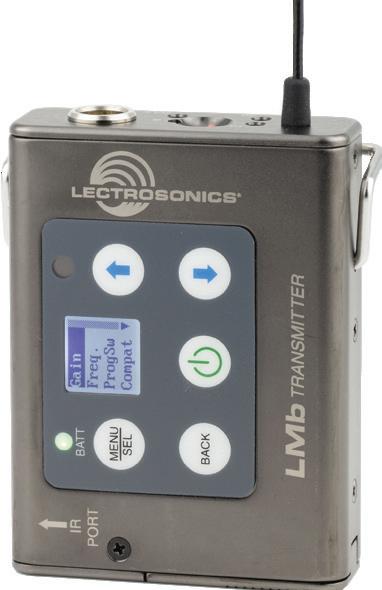

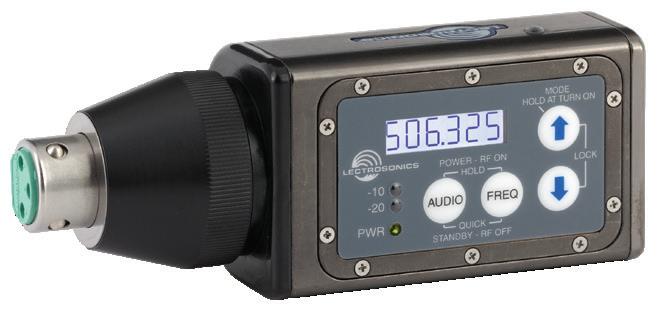

Ross and Rocky Lynch, aka The Driver Era, have just emerged from a spa treatment at an upmarket hotel in central London. You can’t blame them for grabbing a little R&R – at the time of writing the brothers are part way through a 60+ date world tour. They played London’s O2 Shepherds Bush Empire the night before, and are ready to do it all over again tonight…
“It’s nice to get decongested for shows,” says a mellow Ross, the younger of the two by barely a year. “We definitely try to make the most of the experience of being able to travel the world and play music, because we know how special it is.”

The duo (who are also joined on tour by their older guitarist brother Riker, who incidentally is the one that
inspired them to form the band in the first place) aren’t new to the industry by any means. Since their debut single Preacher Man in 2018, they have amassed over 300 million streams and boast over 30 million combined followers across social media.
From their beginnings as members of the band R5, the duo are only in their late 20s, but are already veterans when it comes to touring. Known for creating a live show that doubles as a party, The Driver Era has sold out shows across the globe, performing everywhere from Asia to the US to Europe and South America.
Rocky lets Ross take the lead during the interview, the former helping finish his younger brother’s thoughts when he trails off, and he swears more –likely down to Ross’ media training due to his other life as an actor. More on that later. They’re here today to talk about The Girlfriend tour and their third studio album, Summer Mixtape, which they wrote and produced entirely themselves, as well as using their own mixes.
“All of our albums have actually been written and produced by us, which is fucking crazy,” says Rocky, the fact suddenly dawning on him. “Holy shit!”
“That is honestly kind of crazy,” interjects Ross. “We used to do it in a garage studio, but we just recently moved it into a bedroom and it’s much better because it used to have kind of a dungeon vibe.”
“We don’t mess around,” nods Rocky.
“There’s this really magical pocket of rawness, expression and intimacy that should be captured in the studio. When you send it off to someone else and they make it bigger, it doesn’t have that same essence. There’s this notion that people want perfection but in reality, they want emotion. That’s at the root of our music.”
If 2021’s Girlfriend is the album that was penned and produced during a time where Ross and Rocky were solely with their loved ones, Summer Mixtape is the record that explores themes of adventure, nightlife and intimacy. “We always like to express ourselves in a raw, honest way, but this release goes a little bit harder,” says Rocky. “With Summer Mixtape, these are songs that are a nod to that state you want to be in – having fun and enjoying life with the people you care about.”
“We’re always focused on exploration, expansion and discovery,” nods Ross. “We can’t not make music. We like to play around in the studio, it’s a playground for us. Honestly, sometimes we wait for the song to tell us what it wants to be about. We didn’t really set out to make Summer Mixtape,” he admits. “We just kept making songs in the studio and eventually had 11 or so of them. The tour was coming up and we were like, ‘Well, we might as well put these out now!’ For this particular release, it was a little bit more…or kind of, less,” he changes tact, “I don’t even know how to say it,” he says, looking to his brother.
“It’s just a little more of the raw moment,” says Rocky, coming to his rescue. “You end up going with the most raw and energetic thing that was made. We tried our best to stay in that moment and stay in that rawness and click record.”
Ross’ favourite track off the album isn’t bouncy lead track, Malibu, but Like A King, which begins, “If I’m just all that I think / Then I’ll just think like a king”. “I hold that one pretty close to me,”
says Ross.“It’s a philosophy that I really believe in and I’m happy that I was able to finally put that into a song to some extent. I think there’ll be more songs where I can…” he trails off dreamily. “Sorry, I’m all spa-ed out,” he says, picking up his train of thought, “...more songs where I can clarify some of these philosophies that I’m really into right now. This is a good introduction to ‘you become what you think’ and the law of attraction and some of these universal, more spiritual concepts that are really powerful.”
Rocky scrolls through their songs on his phone quickly: “When we were finishing it, I remember really enjoying working on Back To You,” he says. “I remember it would always get to this fucking synth ending part; I always felt like it had a nice peak right there. I actually haven’t listened to that in a while…”
Despite their impressive online following, ironically the Lynch brothers aren’t remotely interested in celebrity, what’s trending on TikTok, or churning out formulaic singles. “We’re not interested in fame, there’s nothing compelling about that,” nods Ross. “I’ve had my fair share of fame for some years now; there’s nothing to it that’s actually that great. It’s fun to have cool opportunities, but the best part of what we do is being able to share experiences with people that have related to the creations that we make or feel emotionally connected. I’m more interested in the spiritual aspect of connections with people rather than the exploitative nature of celebrity. I’m much more interested in, if we are to have a very prominent success story, that it’d be as a result of good, honest, art and expression that people relate to. It’s way more important than having a pop-off song on TikTok. That’s not very appealing to me, personally. I know Rocky might have a different opinion, but I’m pretty sure he thinks similar to me.”

“WE’RE NOT INTERESTED IN FAME, THERE’S NOTHING COMPELLING ABOUT THAT.”Photographer: Samuel Fisher
Rocky doesn’t answer, likely sensing at the mention of Ross’ experiences with fame that this is the part of the interview he inevitably zones out for. In addition to being one half of The Driver Era, Ross is also an acclaimed actor, starring as Harvey Kinkle in Netflix’s Chilling Adventures of Sabrina (CAOS) in addition to the 2017 biopic My Friend Dahmer after spending half a decade portraying the fan-favourite Austin Moon in the popular Disney Channel Original Series, Austin & Ally. When they first started the band, Ross had to leave for long stretches to film CAOS in Vancouver, leaving Ross in the studio to work on their music.
“I shipped off to Canada to film that show and I remember asking Rocky, ‘Yo dude, are you cool with this? I’m gonna go up to Canada for 10 months’. It wasn’t a short show by any means. It is hard to multitask and to have passion for multiple projects at once. I wasn’t necessarily focused on The Driver Era at that time – I was trying to,” he insists, “but there were so many other aspects of learning and growth happening in my life. But everything works out for a reason. During that time, Rocky made some really prominent Driver Era songs that are still some of my favourites to this day, like Low and Flashdrive.”
CAOS received positive reviews and rapidly attracted a passionate fanbase. After four instalments, it was abruptly
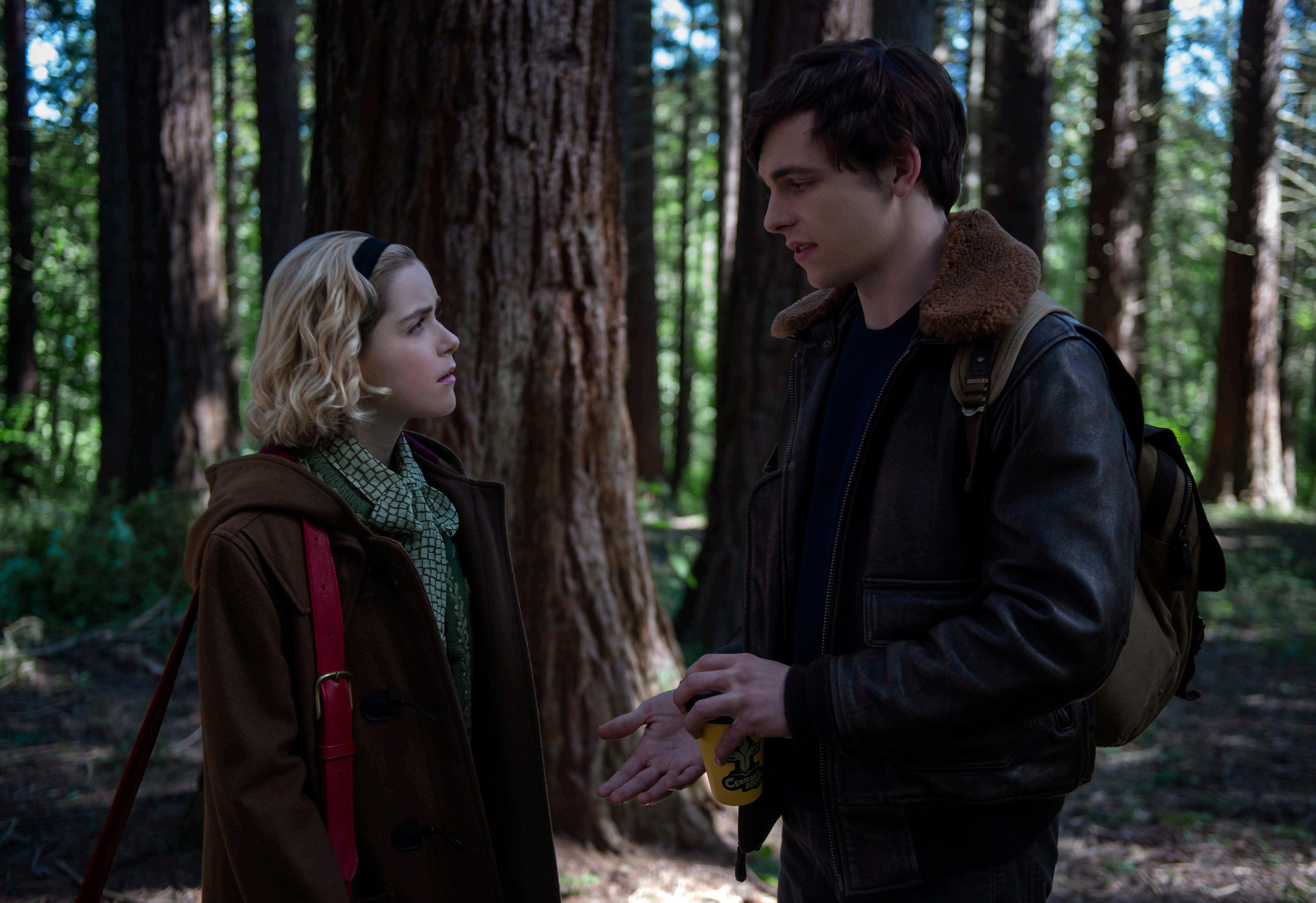
cancelled before work on part five could begin – citing the covid pandemic as the reason. Shortly after news of the cancellation broke, showrunner Roberto AguirreSacasa took to Twitter to stress that, “Part Five, Witch War, would’ve been AMAZING”, while Sabrina actor Kiernan Shipka revealed that the cast did not know when filming season four that they would not be back. Fans were far from keen on the show’s ending and the fate of the characters. Ross, however, had a feeling the show would be cancelled.
“The last few months I was out there, I actually was telling a few of my castmates that I had an intuition. I was kind of trying to warn them. I was like, ‘I don’t think we’re coming back, guys. I don’t know why, I just feel it’. And then covid hit and they said that was one of the reasons why the show didn’t make it, but there are plenty of other shows that made it through covid,” he points out. “I’m not really sure what the final conclusion was to cancel it. I do know that the creator of the show, Roberto, really wanted to round out the show with eight episodes, and we just couldn’t make it happen. It was a great run. I run into people all the time that really love that show, and it’s always really nice to hear. I thought it was different.”
Ironically at the time of interview, Netflix’s most watched TV show is Dahmer – Monster: The Jeffrey Dahmer Story. Ross also played the serial killer in 2017’s My Friend Dahmer, which focuses on Dahmer’s teenage years, leading up to his first murder. Ross hasn’t watched Dahmer. “I don’t know if I will, to be quite honest with you. I heard Evan Peters is fantastic. You know what’s funny – I actually don’t really like murder documentaries or anything like that. It’s not my style of entertainment, even though I did play Dahmer, but it wasn’t about the gruesome bits. It was a psychological discovery of how this man became
what he did, it wasn’t necessarily the cannibalism aspect.”
On whether he feels an affinity towards music or acting, he’s just happy that he gets the chance to do both at all. “You know, it’s funny, I don’t even know how I got here,” he laughs. “I really love both of them, and at different moments in my life I love the other one more –sometimes it’s acting, most of the time it’s music. I’m just floating around and just doing what I do…Rocky stop it,” he suddenly says – Rocky is amusing himself by making animal shapes with his hands. “You’re distracting me, acting like your hands are a dinosaur.”
“That was a spider, bro!” Rocky insists, collapsing into laughter.
“I love what I get to do,” says Ross, willing himself to finish on a profound note. “I’m so grateful that I get to live this life. It’s so much fun. I’m having a wonderful time and I feel like we’ve grown more this year than any other time in our lives. I’m looking forward to seeing how the work we’ve done unfolds further into our future and, of course, our music.”
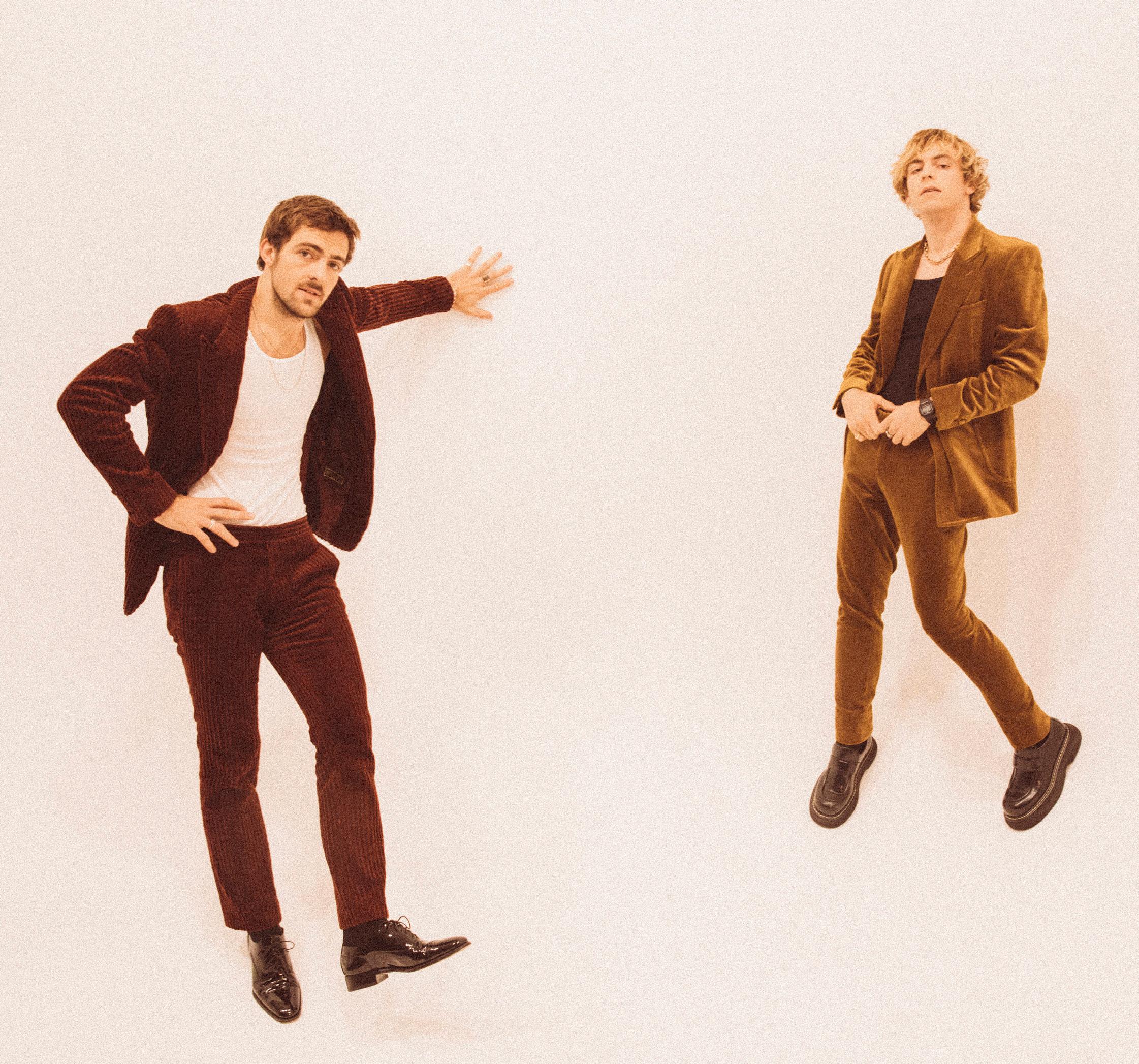

Bay Area native Jaimeson Durr is a rock music-inclined veteran of the California engineering and mixing scene. He’s worked with artists including Wyclef Jean and Bowling For Soup, while ensuring he has time for his passion: working with up-and-coming bands and artists. He’s the founder of Wally’s HydeOut studio, a building that has such a history that his room once saw ‘60s acts like Creedence Clearwater Revival recording there. He talks about his career so far, and why he feels he wouldn’t have a career if it wasn’t for Waves plugins.
Not only is Durr a long-term resident of The Golden City, San Francisco, but he now works from the incredible space that is Wally’s HydeOut studio, with an incredible musical history.

“It’s been there since 1969 and has survived all these years,” he says. “So it’s a classic studio where a lot of notable bands have recorded, especially in my room. They did Santana’s Abraxas there, they did Jefferson Airplane and a lot of Creedence Clearwater Revival records there – a lot of ‘60s bands that were coming up and then
hit the big time. And it still sounds great today. People come in and immediately feel the vibe in the room; it’s a building with a lot of good ghosts!”
Durr’s discography is very extensive, but when asked about some of his fondest memories in his long career, he doesn’t hesitate to answer:
“I was very fortunate to get to work with Sammy Hagar. I worked on a record with him that did very well. The last one that we did together was called Space Between, which hit
number one on the Billboard charts. So that was kind of unexpected. And it was a nice boost to my career, for sure. But also it was really fun to work on a project that had a bit of a budget, where you’re not having to record really fast and get it done. We got to spend our time and develop the sounds and the songs. It was really great to be a part of that.”
The conversation then turns to Durr’s long and wide ranging use of Waves plugins, a true constant throughout his career:
“I’ve been using Waves plugins for probably 20 years now,” he says. “I started with some of their very first plugins, like the Renaissance bundle. The Renaissance Equaliser and the Renaissance Compressor – those were my go-tos.
“If you were to open some of my old sessions, you would probably find those plugins and the cool thing about them is that I could open those sessions from 20 years ago, and the plugins would still work with the
latest versions that I have. So they’ve always been a part of my plugin arsenal — I can’t recall any session that I’ve ever done that didn’t have those plugins on.”
As you can imagine, though, Durr has plenty more go-tos from Waves than just those two. When it comes to channel strips, he finds that he will “usually gravitate towards the SSL stuff – that always seems to work really well. I’ve been using the original SSL for years and years. I have the EV2 and I’m using that in the CLA Mix Hub. I like the H-Reverb; that’s a great-sounding one that I use all the time.
“Also the Abbey Road Plates. H-Delay is another favourite, and PuigChild is always on the vocal chain. Even some of the signature ones like the CLA Bass, that’s on all my bass guitars. It’s so easy to get great sounds with that thing. I can’t say enough good things about Waves, I can’t live without it. I don’t know if I’d have a career without Waves!”
In terms of Waves plugins that he feels are a little more underrated and that he’d like to see other producers use as much as he does, Durr singles out the MV2.
“I always use it on my final vocal limiter. It just pushes that vocal forward with the upward compressor and downward compressor, so you get all the articulation in the vocal. It then pushes it down like a normal limiter. That one is just awesome on vocals.”
A wonderful mainstay with Durr is his work with bands – he started out as a guitarist, and clearly is still very fond of the instrument and the classic rock band sound. So it’s great to hear that’s how the rest of his year is taking shape.
“I’m booked out until the end of the year working with an indie band and then more of a classic rock band – they’re both big Sammy Hagar fans, which is why they sought me out,” he smiles.

“I CAN’T RECALL ANY SESSION THAT I’VE EVER DONE THAT DIDN’T HAVE WAVES PLUGINS ON.”
It’s not just that the 5D has integrated audio networking. Or flexible output power sharing. Or that you can easily hide it. You’re saying “yes” to more. A d&b system that provides the scalability, flexibility, and reliability needed for installations. Still, the 5D is a very impressive amplifier. Discover more: dbaudio.com/5d

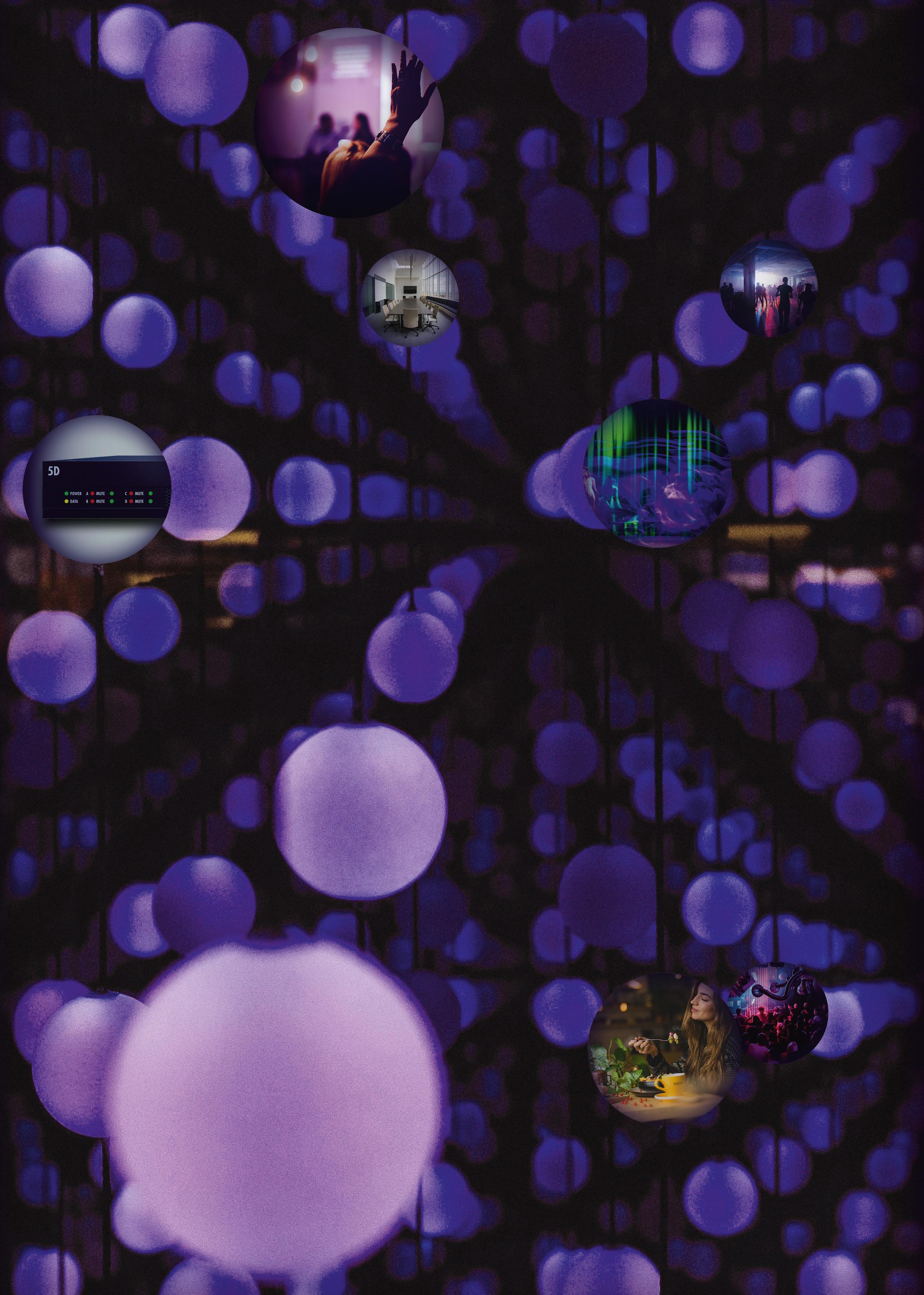

L.A-based recording and mixing engineer Claire Morison heard Knives Out by Radiohead as a teenager, and it changed her life forever. The self confessed indie girl from Montana explains why she risked it all to open her own studio in Hollywood.
Morison is chugging a coffee as she joins Headliner from her L.A studio, called Wild Horizon Sound. “I had a late night session last night. Artists don’t typically like to start before noon. So I’m going kinda late sometimes, so yeah, I’m all about the caffeine,” she smiles brightly, somehow not looking or sounding remotely tired despite working into the early hours.
Growing up, it was her mother who encouraged her children to play an instrument each, with a young Morison choosing the violin, before eventually begging her parents for an electric guitar aged 13. Music was certainly already a passion of hers at a young age, but she distinctly recalls the moment she knew she wanted to work on the music someday:
“This is such a cheesy story,” she cringes, “but I do clearly remember discovering Radiohead at Borders bookstore in my small town when I was about 15. I heard Knives Out from their record Amnesiac and I just had this feeling like, ‘Oh man, I gotta be a part of this’. It made me feel differently in a way that I hadn’t before. Around then was when I realised I wanted
to be involved in the production and creation of records. I’ve never been a performer. I’ve never craved playing in front of an audience. In fact, I am terrified of it,” she admits. “Being a producer or engineer seemed like the next closest thing.”
She grew up in a small town in Montana, moving to L.A to study recording arts at Loyola Marymount University as soon as she was old enough. 12 years later, she’s still in Los Angeles. “As soon as I turned 18, I was ready to get out of there,” she says. “I had always felt that way. I mean, where I’m from – Whitefish, Montana – is so beautiful,” she says quickly. “It’s basically next to a national park, but I didn’t have a lot of access to music or art and culture.”
Honing her skills at university, Morison took a job at the campus radio station as their live engineer where she was able to dig into the tech at the facility’s impressive recording studio.
“It was full of really amazing gear. It actually turned me into a gear snob,” she laughs, shaking her head slightly. “I had more independent access to the studio, so I got more involved with the independent rock scene in L.A, and I had a blast. I made a couple of records before I even graduated.”
Fast forward to today and Morison has worked as a freelance recording and mixing engineer for the last decade at various independent studios. In 2020, during the worldwide lockdown, she decided to take a risk and open her own studio, Wild Horizon Sound.
“Weirdly enough, I had already begun looking into renting out a room for myself and starting to branch out into my own business,” she explains. “Then the shutdown happened, and this studio in Hollywood became available. It was this crazy, serendipitous situation that happened, because everything lined up at the right time. It was a risk,
because I was working at those other places for years. You hope that people will follow you wherever, so it’s kind of a test to see if people are going to make the drive to Hollywood.”
Morison says she considers herself to be the “midwife” of the musician and their creative process – essentially helping deliver others’ sonic ideas. In other words, she’s a pair of safe hands.
“I really do feel strongly about that statement in the sense of how I’ve come to see my job,” she says.
“But also, I never want to take too much credit; I’m interpreting and understanding ideas. Someone’s coming to me with a song, and it is my job to deliver their art back to them in a more fully realised form. It’s definitely a process in deciding, ‘How are we going to do this? What is your vision for this? What’s the end goal?’ There’s a lot of factors in that process, and it’s
something that requires a lot of trust, openness and communication. It’s an important job for me, to help someone deliver their art.”
Morison specialises in full-band tracking and live instrumentation, and it goes without saying that for a self confessed “gear snob”, her studio only boasts the very best in terms of technology. On every session, Morison puts her Focusrite Clarett+ OctoPre and Red 16Line interface to work.
“Focusrite gear is so amazing – most musicians and producers will literally start with Focusrite with the Scarlett, and that gets people starting to produce or make demos. It’s a quality place to start and is accessible for pretty much all musicians starting out. I’ve always been a fan of that. I’ve used Focusrite gear in most of the studios that I’ve worked in.
“I WORK WITH THE CLARETT+ OCTOPRE TO CAPTURE THE FOUNDATION OF SOUND AT A HIGH LEVEL OF GAIN WHILE – FIDELITYWISE – KEEPING THINGS INTACT, SO NOTHING IS DISTORTING OR GETTING CRUSHED.”
“The Clarett+ OctoPre is nice because I’ve got an extra eight channels of good quality, high fidelity, clear, clean audio,” she enthuses. “It’s nice to have a standard that I can rely on. A lot of the time, I’ve got 12 mics on the drums, then maybe two on guitar, another guitar and bass amp, bass DI – I’ll get a lot of tracks going. I have a lot of different gear, and I have found that the Clarett+ OctoPre is really clear. It’s a good staple, for sure.”
The Clarett+ OctoPre mic pre is particularly good for capturing drum recordings. Morison explains how it allows her to be confident that the energy of a live session is captured correctly.
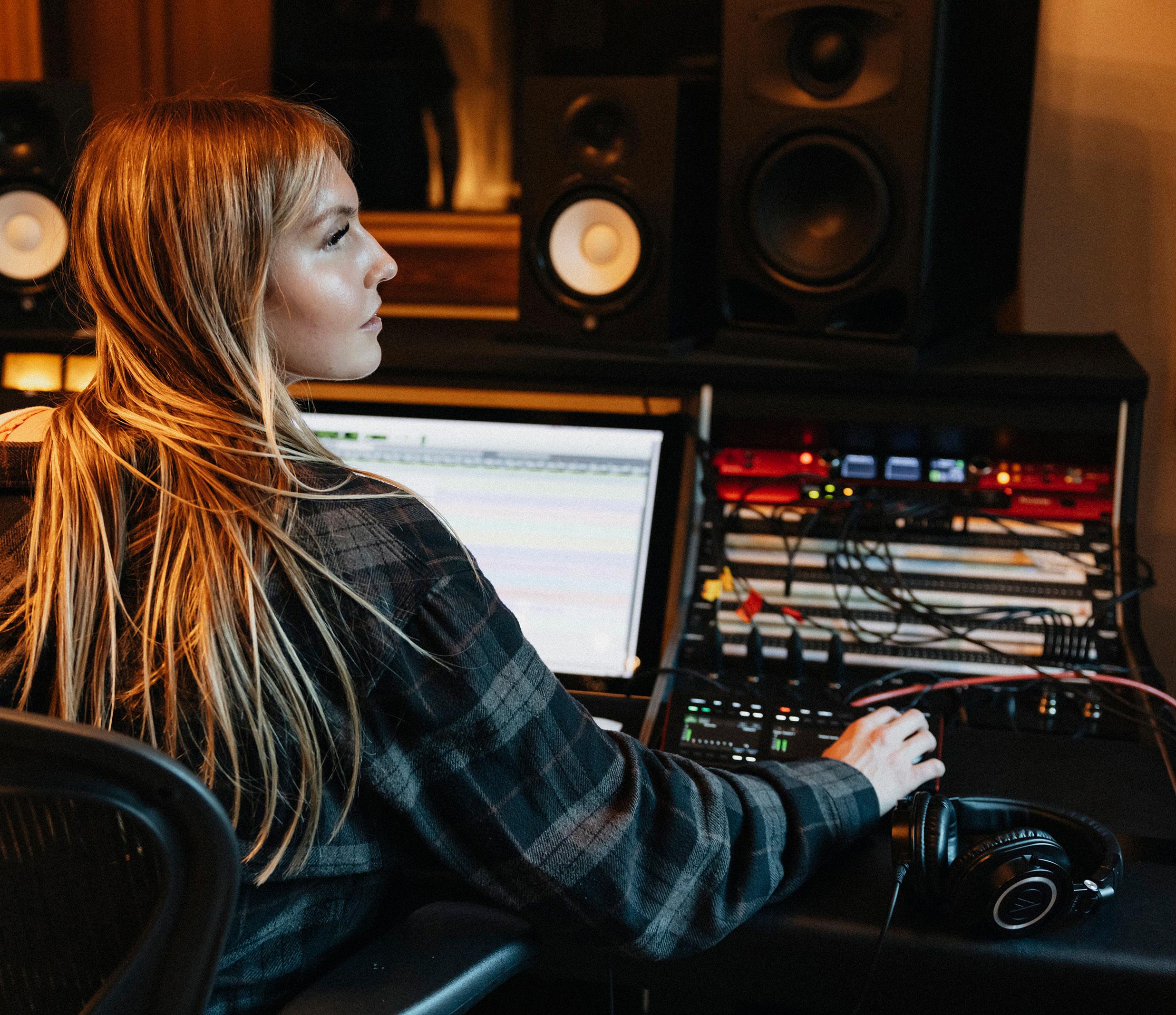
“A lot of the time when I’m recording drums, I work with the Clarett+ OctoPre. I use it to capture the foundation of sound at a high level of gain while – fidelity-wise – keeping things intact, so nothing is distorting or getting crushed. It’s a very clean and clear-sounding pre, and that’s what I’m trying to get out of those tracks: I’m choosing the drummer, the drum, the mic and the mic placement, and I’m getting my sound through that. I am directing that through the Clarett+ OctoPre and Red 16Line interface, so I’m trying to capture the chain that I’ve already created at a high fidelity level.”
The Clarett+ OctoPre’s included Hitmaker Expansion bundle of
recording software has become a go-to for Morison when shaping drum sounds in the studio. Her particular favourites are found within the Red 2 and 3 plugin suite, which features a pair of meticulously captured digital models of the iconic EQ and compressors which have made the Focusrite name a staple in world-class facilities across the globe, and the Brainworx bx_console Focusrite SC plugin.
“I did a quick drum mix recently and that was one of my first times using the Brainworx bx_console Focusrite SC plugin,” she shares. “I wanted to explore using that and keeping it in the Focusrite world. Honestly, I loved that plugin. It’s great and I’ve been using it ever since. It comes from a very notable piece of gear – those Focusrite consoles – and the quality is great. It was a fairly easy interface and that was super fun to play with. There were times that I started with a preset and then I messed around with it until I found the sound that I wanted, which is a way that I like to familiarise myself with new plugins sometimes. Sometimes those presets can sound terrible, but I was pleasantly surprised! I had a really great experience using those.

I also used the Red 2 EQ and Red 3 Compressor in the Red 2 and 3 plugin suite; the sound quality was great and they were easy to use, so I was totally happy with that.”
The first EP Morison fully produced is out next year with the artist Surprise Baby, and another soon-to-bereleased project is Lauren Ruth Ward’s next record, which she tracked and mixed most of the songs for. Some days she could be working on an overdub session for five hours, the next mixing a song on her own, and the next, a full-band tracking and live instrumentation session that keeps her up until the early hours. That variety, she says, is what keeps it interesting.
“It’s nice to have variety; it’s just part of the life,” she nods, taking a sip of coffee. “There’s maybe a month or two in the summer where people are touring or they’re taking a break, and it can get a little dead at the studio. Then of course we have our busy seasons and you get into the swing of it and it’s go, go go! I definitely enjoy that. I am in a very amazing position where I really enjoy my work, and I am always grateful for that. I do work long hours and I’m very busy, but I love what I do,” she smiles.


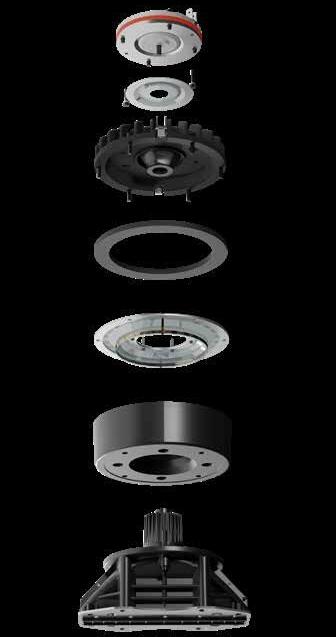
Composer, artist, songwriter and producer Ilan Eshkeri reveals how he recently teamed up with songwriter Andy Burrows once again for four special shows celebrating the 10th anniversary of much-loved Christmas film, The Snowman and The Snowdog.
When production company Lupus Sounds contacted Eshkeri a decade ago to recruit his expertise, they knew he already had a rich history of writing songs alongside score, aside from working with many bands and artists. They needed a composer who could help them realise the music for The Snowman and The Snowdog, a 2012 animated short film and the sequel to the original The Snowman, which captured the hearts of Brits nationwide with its magic 30 years previous.
The resulting song, Light the Night, was created in collaboration with Razorlight drummer Andy Burrows and serves as the centrepiece of the film, just as Howard Blake’s Walking in the Air did for The Snowman in 1982.
“I have to say, at first I was a little hesitant because I grew up watching The Snowman, like most people in
Britain have done,” Eshkeri tells Headliner. “It’s a huge undertaking when something is that popular, and it’s a part of people’s lives. There’s a real responsibility not to mess it up, because otherwise you’re sort of ruining people’s Christmases! It could easily have been a bit of a poison chalice, but I thought really hard about it and agreed to do the job.”
The next step was to discuss which artists Eshkeri was going to collaborate with. Razorlight drummer and songwriter Andy Burrows, who was a friend of Eshkeri’s at the time, seemed to be the obvious choice.
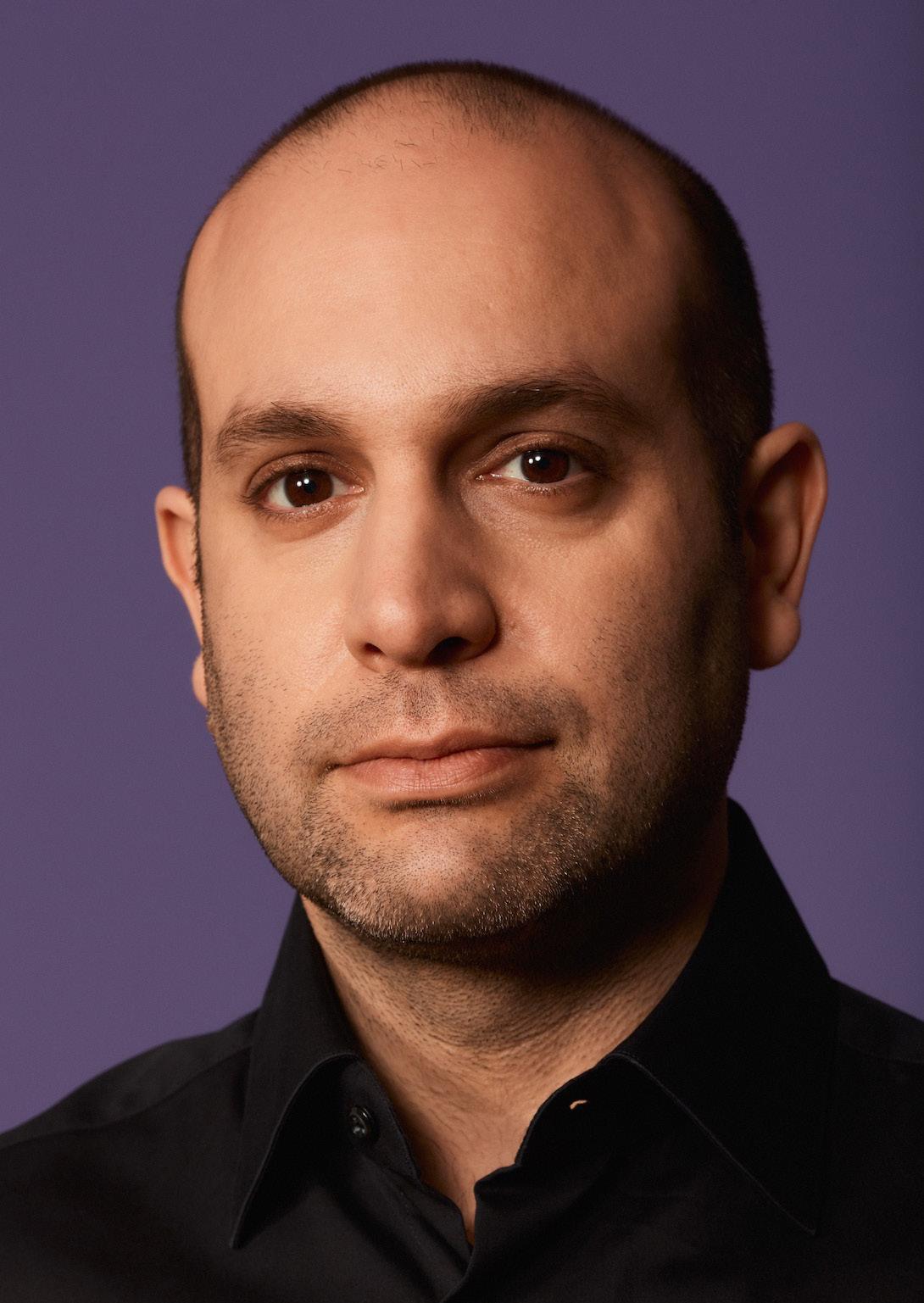
“He’d recently left the band and was releasing some well received solo albums,” Eshkeri recalls. “At the same time it wasn’t like we were bringing in a huge band that would overshadow things. Andy had one daughter at the time – two now –and so he really connected with the kids aspect of it. He also had this little cloud dog called Rufus who was very similar to the Snow Dog, so it all just seemed perfect.
“When we started writing the song and the score together, we wanted it to be really cohesive. It was a big challenge, but looking back on it 10 years later, I feel like we did an alright job. As it was 30 years since the original, we made it more contemporary, and brought a broader pop feel to it.”
In The Snowman and The Snowdog, a boy finds an old picture of the snowman under the floorboards, having moved into the same house where the boy in the original 1982 film started his magical Christmastime adventure. That said, it made sense for Eshkeri and Burrows to make the new song feel more contemporary.
So were there any specific requirements when Eshkeri was approached again to work on the special 10th anniversary concert of The Snowman and The Snowdog?

“We did a series of concerts nine years ago and they were really well received,” he tells Headliner. “So we wanted to do that again. In some ways it’s similar, and in other ways we’re bringing some more special Christmas magic to it. The show starts with a classical performance from the orchestra, and then we perform The Snowman and The Snowdog with an orchestra and the band and the huge screen – it’s really quite spectacular and beautiful.
“There’s an interval and then we come back with the band accompanied by the orchestra, and just play Christmas pop songs. It’s a bit like a singalong – all stuff that you hear on the radio every year. And then we’re going to bring in a couple of really special guests who were invited to come and share the stage with us on a couple of different songs. It’s just like a Christmas pop concert really!”
Although Eshkeri describes it simply as a Christmas pop concert, the show is undoubtedly the perfect way to get into the festive spirit. And while he initially felt it was a risk to take on something so famous and well loved by many, he now feels that it has become just as much a part of the British Christmas tradition as the original film.
“I’m really grateful for that,” he continues. “It’s not often in anyone’s career that they get to create
something that touches so many people and connects to a special time for them every year. It’s a really special thing to have had the opportunity to do that, so I’m really grateful for that and I know Andy is as well.”
Right now, Eshkeri seems to be doing more of his own independent work, and is very happy to be doing so. He is currently working on a new ballet and is having conversations about various TV, film and video game projects, which he says he very much still enjoys doing.
“When you do that work however, you’re part of somebody else’s vision,” he reflects. “That’s great because I love those collaborations, and I’m always seeking out healthy, positive working relationships, but also I can be slightly more picky because I’m getting so many more opportunities to create my own shows, like Space Station Earth.”

“IT’S NOT OFTEN IN ANYONE’S CAREER THAT THEY GET TO CREATE SOMETHING THAT TOUCHES SO MANY PEOPLE AND CONNECTS TO A SPECIAL TIME FOR THEM EVERY YEAR.”
For the Space Station Earth album, Eshkeri got the opportunity to do an immersive tour with the European Space Agency and headed up a fantastic performance at the Royal Albert Hall with famous astronaut Tim Peake.
“I’m also getting more chances to do live shows with stuff that I’ve already created, like The Snowman and The Snow Dog, and also working in the ballet world and the classical or contemporary performance world,” he adds with palpable excitement. “What I’m not doing too much of at the moment is songwriting and
working with bands, which I miss, but I’m sure that will come back; it’s funny how things find you.
“I feel so lucky that my music has taken me on an amazing journey in my life. It really is funny how things happen sometimes. Tim Peake first heard my work because of the movie Layer Cake that I worked on, and then he followed my career and eventually contacted me and that created this whole amazing experience for me. Even with The Snowman and The Snowdog – the producers and directors knew my work so they wanted to meet me
and things went from there. I feel so lucky that I get to make music and put it out there in the world, and it connects with people, and then they ring me up and we make more stuff together and then put that out in the world. So who knows what projects will come back, and what kind of thing I’ll be working on next!”



Based on the 2018 novel of the same name by Carola Lovering, Hulu TV drama series Tell Me Lies hit the small screen this September. Centring around the tumultuous but intoxicating relationship between Lucy Albright and Stephen DeMarco over the course of eight years, the series reveals how seemingly mundane choices lead to irrevocable consequences. Such was the success of the series, it was renewed for a second season just two months later.

With the popularity of streaming services today, production value expectations for TV series is on a par with feature films, often on a tight timeline, which means close attention must be paid to production values for both picture and sound. Tell Me Lies is no exception, with production sound recorded and mixed by Michael Wynne, CAS, using his extensive arsenal of Lectrosonics wireless. This includes his trusty SMQV dual battery belt-pack and IFBT4 transmitters as well as SRc dualchannel slot mount, UCR411a compact
and Venue modular receivers, and units from the D² Series, including the DPR plug-on transmitter and DCR822 dual-channel compact and DSQD four-channel receivers.
For his booms on the series, Wynne opted for a full D2 digital stream with two DPR digital plug on transmitter units and two DSQD four-channel digital receivers, citing the clarity of sound as what he likes most.
For interiors Wynne typically deployed the Schoeps Colette CMC141 (MK41 supercardioid condenser capsule with a CMC 1 U amplifier and CUT60 low-cut filter). On each boom, the DPR transmitter plugs into the CineLa suspension mount, making for what he calls “an extremely low-profile, lightweight solution that the boom operators love.”
Speaking of booms, Wynne always works with two whenever possible. The boom mic, he explains, is one of the most important on the set because it provides the most natural, picture-matching experience for the
viewer. That said, bodypack wireless with lav mics are also vital because many scenes are shot with multiple cameras where it is difficult – or even impossible – to position the booms where they need to be, while keeping them out of the frame.
With so much sound capture relying on wireless, Wynne is grateful to Lectrosonics for making even their new digital products backwardscompatible with the digital hybrid products. He currently has 16 legacy digital hybrid transmitters in various blocks, however his new D2 receivers work with all of them.
The DCR822 resides in Wynne’s smaller sound cart with his Aaton CantarMini 16-track portable digital mixer-recorder, while his DSQD receivers can be found in his larger main cart. The DSQDs connect to the Cantar mixer-recorder via Dante for a full digital path with no conversions necessary. The difference in clarity with this configuration, he says, is like listening to a high-resolution playback versus an MP3.
The performances in Tell Me Lies are very dynamic – the actors can go from a whisper to a scream, and the clarity and low noise of the Lectrosonics digital transmission path was paramount to capturing dialogue that was going to translate well in post. Formosa Group’s dialogue editor, Jason W. Freeman for Tell Me Lies was so impressed that he reached out to Wynne to praise the quality of the boom sound in post.
Reliability is also a favoured quality of Wynne’s Lectrosonics kit. Although he keeps HMa plug-on transmitters on hand for backup to his DPR units, he hasn’t had to use them. “The reliability is very important. It has to work,” he asserts. “They really proved themselves on Tell Me Lies We want to deliver the best possible raw isolated tracks.” He adds the transmitters’ battery life is “terrific” with the lithium Energizer AA cells he uses – in fact there were times he went the whole day without having to change them.
A film set is a hostile, less-thanoptimal RF environment, and a robust wireless system that can survive and deliver is a must. In a major market like Atlanta, on a large-scale film set like this one, the RF environment is often very congested, with Teradek camera transmitters operating in 5G, Preston focus systems operating on 2.4 GHz, all the personal mobile phones and Bluetooth devices, plus all the UHF TV channels occupied by broadcasters in Atlanta. Wynne is happy to report that the Lectrosonics gear met the challenge.
The show also had a shoot on the water on Georgia’s Lake Oconee. The RF environment was quiet, and they were able to connect boat-to-boat at long distances Wynne estimated were up to 300 metres. In this scenario, Wynne deployed Lectrosonics’ waterproof digital hybrid transmitters with DPA 4060 lavs hidden in the life jackets with the help of the wardrobe department seamsters.
Wynne has set up his main and small sound cart in a way that allows him to quickly change from one to the other, which is critical in fast-paced narrative work. In his main cart are Lectrosonics’ Venue six-channel modular receiver and two Lectrosonics DSQD four-channel digital receivers, for a total of 14 wireless channels, a Lectrosonics IFBT4 IFB transmitter and an Aaton Cantar X mixer-recorder. In his small cart is a Lectrosonics DCR822 dual-channel digital receiver and three Lectrosonics SRc dualchannel digital hybrid receivers, a Lectrosonics SMQV transmitter operating in IFB mode, and an Aaton CantarMini mixer-recorder.
“The Lectrosonics wireless equipment we use is a cornerstone to our success on a film set,” he concludes.
“THE LECTROSONICS WIRELESS EQUIPMENT WE USE IS A CORNERSTONE TO OUR SUCCESS ON A FILM SET.”

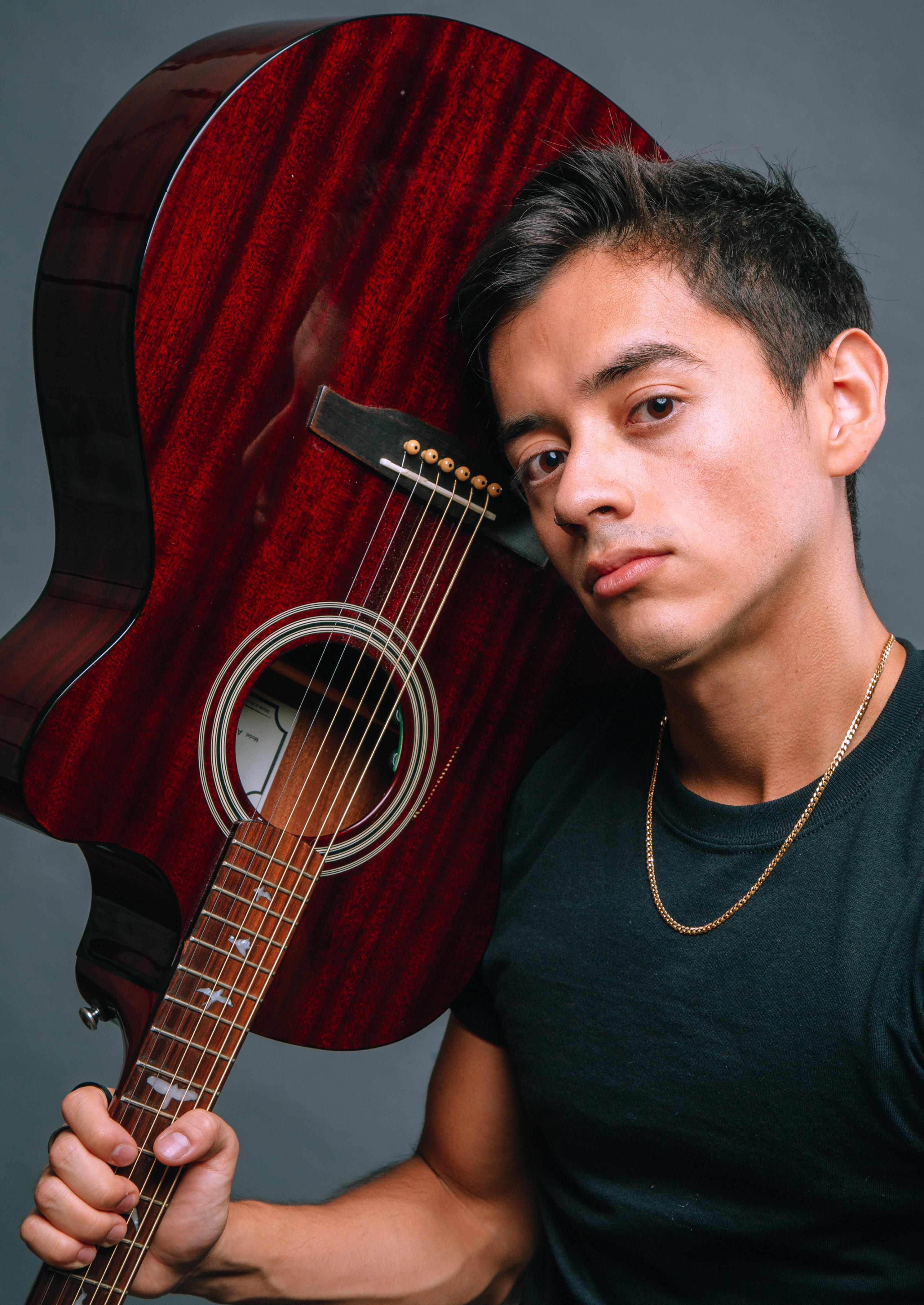
Producer, songwriter and engineer Kevin Aguirre – who is based between his hometown of Bogota in Columbia and Miami, FL – chats to Headliner about his creative process, favourite plugins, and his musical journey so far…

What routes did you take when you first started pursuing a career in music?
I’m 25 years old now, but I first started when I was a teenager. I used to love metal and rock music and playing guitar in gigs with my band. I had long hair and all that cool stuff! Columbia has a lot of great artists and engineers and composers, but it’s a tough place to start a career in music, so I found myself at Berklee College of Music in Boston where I was a dual major in music production, engineering and contemporary writing and production.
That was a great experience because I got to continue playing my instrument but also started writing songs. I got into the studio and learned all the technical aspects on the engineering side, with great teachers like Prince Charles Alexander and Jonathan Wyner. Then
during the pandemic I graduated virtually, and I decided to go to Miami. It turned out to be an amazing place to live and to work and to collaborate with people. This was also like another education for me – letting go of prejudice and the academic mindset, and just having fun.
During that year I applied for a scholarship at the Abbey Road Institute Miami, and I was super fortunate to receive the first scholarship given by Pensado’s Place, which was an amazing experience. This past September I graduated from the programme, through which I got to meet Julio Reyes Copello – one of the most important producers in the Latin industry – and Robin Reumers, who is now a friend, a mentor, and everything in between. His company, Leapwing Audio, to me is one of the
most innovative creators of plugins right now.
I’m super fortunate to keep working with Robin – I talk to him every day and we’re always working on projects together. During the programme, I also had the chance to work with some artists from Universal – teaming up with some great writers to really push the boundaries in terms of the quality and creativity of my work. Thanks to those sessions, I have been releasing a bunch of music this past year as a producer, writer, and engineer.
It opened a lot of doors for me, and the cool thing about these artists I’ve worked with is that they’re just getting big – or have just signed with a great label – so it’s a really good time for me to experiment with them and to help them create their sound.
Can you tell us more about the type of artists you’ve worked with?
When I’m writing and producing, I listen to the artist and try to act as a bit of a musical compass. Everyone says they want to be different or they want to change the industry –which is what everyone should aim for because change is good – but with every single genre I work in I try to aim for something that that can be palatable for as many people as possible, whether that’s pop, or latin music like reggaeton.
One act I’m particularly excited to be working with is Ela Taubert – one of the artists I met at the Abbey Road Institute Miami. She’s Colombian and writes in Spanish, but she grew up with a lot of Anglo inspirations from the American and British markets. With her, we’re trying to bring a lot of those sounds to the Latin market. We’re doing some ballads that sound more like Holly Humberstone or Dua Lipa or Adele, but in Spanish – it’s still pop, nothing super complex in terms of chords, but it’s working really well. What I would like to aim for personally, more than a specific genre, is just finding that sweet
spot – making commercial pop music but bringing in elements from other genres and regions. I think that’s where the market is going anyway, like what we’re seeing with artists like Bad Bunny who’s doing a lot of collaborations with American artists.
Could you talk us through your creative process and some of your favourite studio tools?
When I can get my hands on a great preamp or compressor, that’s amazing, but right now I’m mostly working in the box. My creative process starts in Ableton where I have my MIDI, my instrument automation, effects and filters. When I start mixing, I head to Pro Tools because it gives me fresh ears. There I have a template which has some compression, harmonic distortion and EQ – which might be based off of something I already did or liked – but once I reorganise the stems and colour code them, everything is going to sound a bit different.
I’ve been using Leapwing plugins for about a year and a half now, and I consider them to be the Ferraris of all the tools I use. I feel like the things you can achieve with them can really help take your mixes to a different level. The cool thing is that Robin was able to teach me some of the tricks of how to actually use the plugins which was amazing. With the low-end on my bass, for example, I’m always using RouteOne for its subharmonics. Robin explained to me how he programmed it, and it’s crazy how much amazing coding and ideas are behind something like that –it’s definitely one of my go-tos. Also, with some of the masters in my mixes, like drums, vocals and time effects, you’ll always see CentreOne, because it gives me that space to bring the vocals right up in your face in the middle of a mix.
When I’m recording vocalists, sometimes I have a compressor and the Al Schmitt Signature plugin from Leapwing, and just use the built-in reverb in there. In doing that, vocalists can hear themselves as if they were in the record already, and that helps a lot with their performance.

Tell us why you decided to start creating production and mixing tutorials on your social media channels? And how has that been going?
As well as working in a studio setting, I’ve always loved the other side of things – being on stage and performing. So, I’d been talking to some friends and working out a way to showcase a little bit of my work to

make it more visible. I think the most honest thing is to just show what I do in terms of my process and a lot of people seem to be interested in that – I’m getting creative with my tools and really diving deep into production and engineering, but also with a performance element. I started about a month and a half ago, just showing how I produced some of the tracks I released with
the guys at the Abbey Road Institute, and now I’m starting to do more remixes. More videos will be coming up soon, so stay tuned!


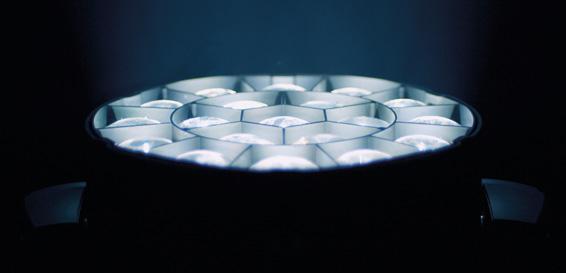

Noé Solange’s new single, Bloom, is a curious mix of inspirations from hustling as an electronic musician and freelance photographer in the nonstop city of London, but also from her time finding peace in the Indonesian countryside earlier this year. Perhaps this is why it creates such a stunning sound palette like no other. Solange opens up about creating the song, how she moves between seeking balance in life but then going into tunnel-vision mode when creating, and tells us about her home studio in East London.
Solange’s music is a stunning example of music coming out of London that also reflects the rich background of the artist creating it. And few artists can make this claim as strongly as Solange; besides her multidisciplinary skillset as a freelance photographer, she is one of the most truly international people you’re likely to come across.
“Where do I begin? I’m Dutch, Indonesian, Surinamese, Czech, and I’ve lived in nine different countries,” she says, with a speed that suggests
she has reeled this off to people plenty of times. “I’ve always done music – it feels like the one thing I could bring with me everywhere I went. I played violin, piano, and would sing in bands and choirs, and around the age of 15 I started wanting to learn production.”
Solange’s move to London, and her realisation that she wanted to pursue the dream of music, were fairly simultaneous. “I became a vocalist and lyricist for other artists during my studies in the UK, and I purposefully moved to London to pursue my own music. Nocturnal Lady was the first song I released, which I co-produced with my friend Jose.”
It’s deeply impressive to learn Nocturnal Lady is one of Solange’s first self-produced releases. While some self-produced debut tracks have the rough and ready charm of bedroom pop, this is a very slicksounding track – clean production with just the right amount of edge to it. Arpegiattors, hypnotic sub-bass, pads and understated drums provide the perfect bedding for the song’s
excellently layered vocals and lyrics. It has already clocked in 1.5 million streams on Spotify alone.
Headliner then points out to Solange how fascinating it is that her 2020 EP is titled Bound, while her new single is titled Bloom, suggesting a journey from feeling constricted to blossoming.
“I never thought about it that way, I’m definitely going to use that,” she says with a laugh. “Bloom is such an uplifting track, which is so different to that whole EP, which was very melancholic. Bound was about loss and restrictions and I really wanted to delve into more melancholic electronica. Bloom is very much about the past few years, and I wanted to create this piece as a reminder to myself and others to take a step back and look at your accomplishments and how far you’ve come.”
Bloom achieves that selfempowerment spectacularly with a myriad of electronic sounds, plus Solange’s stunning main vocal and choir of backing vocals. It’s simultaneously uplifting, while still carrying the hints of past melancholia, in a gorgeous kind of way. And the fact it was produced between her time in London and visiting Indonesia can only have influenced its unique sound.
“I wrote this song when I felt quite lost. I was quite burnt out last year. I was suffering from chronic health issues. A lot of last year was just me trying to recover. I wanted to use the word ‘bloom’ to convey how we are just like plants and flowers. We have our own individual journeys of growth, and we take our own time to blossom into our unique selves. It’s also a tribute to strong women out there and their own journeys, which is why I use the word ‘she’ throughout the song. I wanted to convey community.”
“BLOOM IS SUCH AN UPLIFTING TRACK, WHICH IS SO DIFFERENT TO THAT WHOLE EP, WHICH WAS VERY MELANCHOLIC.”
Headliner then asks Solange about how this creative process begins in her London home studio. “There’s a lot of vocal harmonies in my music, so for those I love using SoundToys’ Echoboy. I think I use that in almost every song! And then the Valhalla VintageVerb is my main reverb – that brings such warmth to a vocal, which I love. And then Arturia has great synths. Unfortunately, I don’t have an analogue synth at the moment, so I use the Arturia plugins for my synths. The drums will be played live by my friend, Jose, who is also a sound engineer.
“For my sound card I’m using a Focusrite Scarlett. When I moved to London, I actually worked on a photoshoot for Focusrite. Just being in those surroundings and seeing all the gear there, I was like, ‘I want this interface!’ It’s cost-effective; I bring it literally everywhere. It’s really easy to use and it was so popular at the time when I got it. That was when I thought, ‘It’s time for me to really get into producing’, so I bought one of those.”
In terms of the future, there’s a nice air of mystery as to where Solange goes
next. “I haven’t set a date for the next EP yet,” she says. “I’m just trying to finish everything off at the moment. And who knows, maybe I’ll add a few more songs and it becomes an album! But at the moment I have five new songs coming out.”






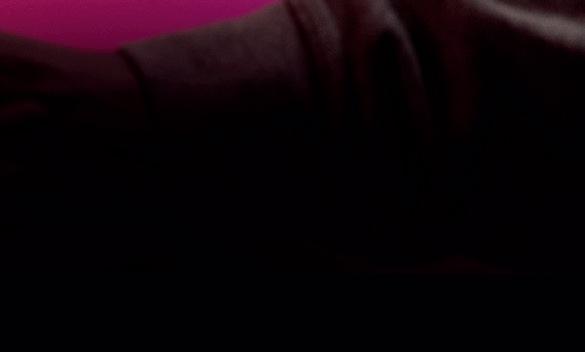
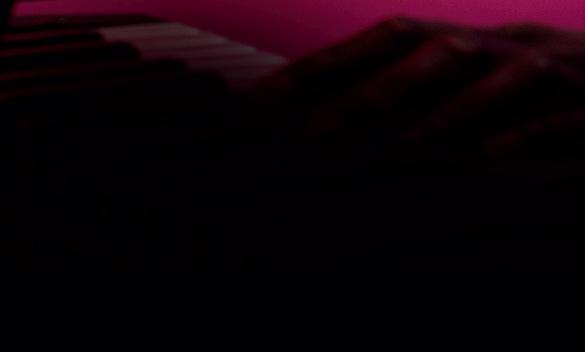

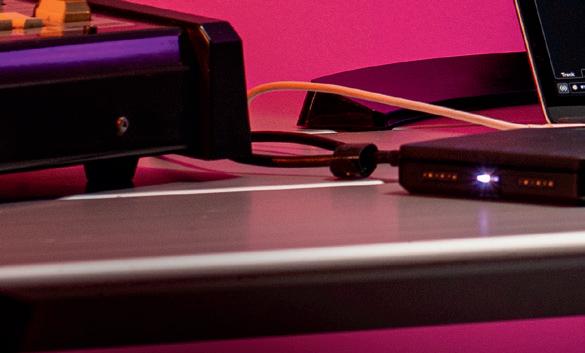




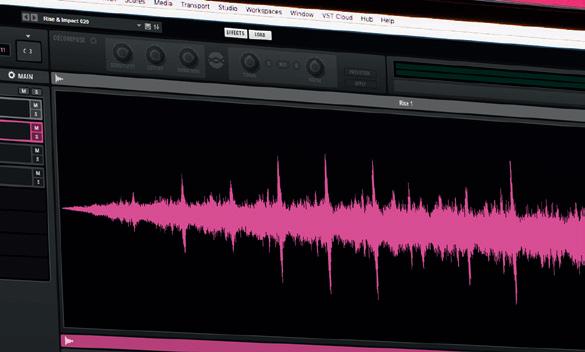





A revolutionary way to design your own drums – Backbone is your new, innovative drum designer for single kicks, snares, hi-hats, percussion, rises, hits and more. Layer up to eight samples and shape them with classic subtractive synthesis, decompose samples into tonal and noise elements and re-synthesize samples to manipulate them in unheard ways.


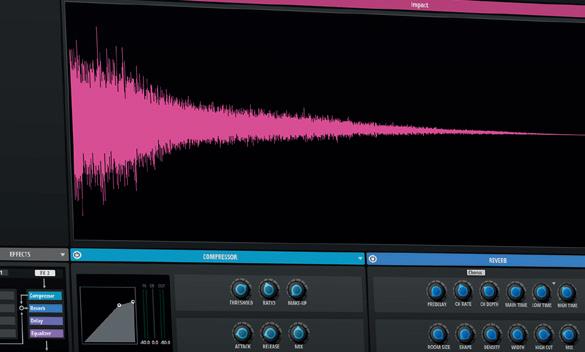


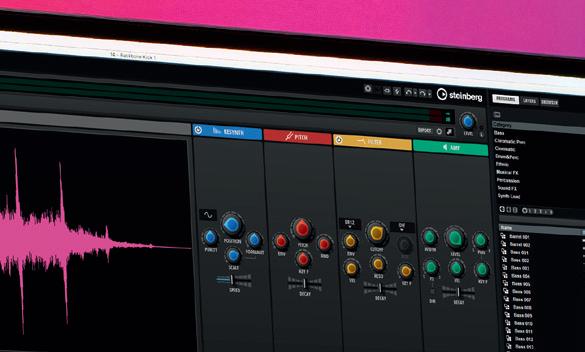
steinberg.net/backbone



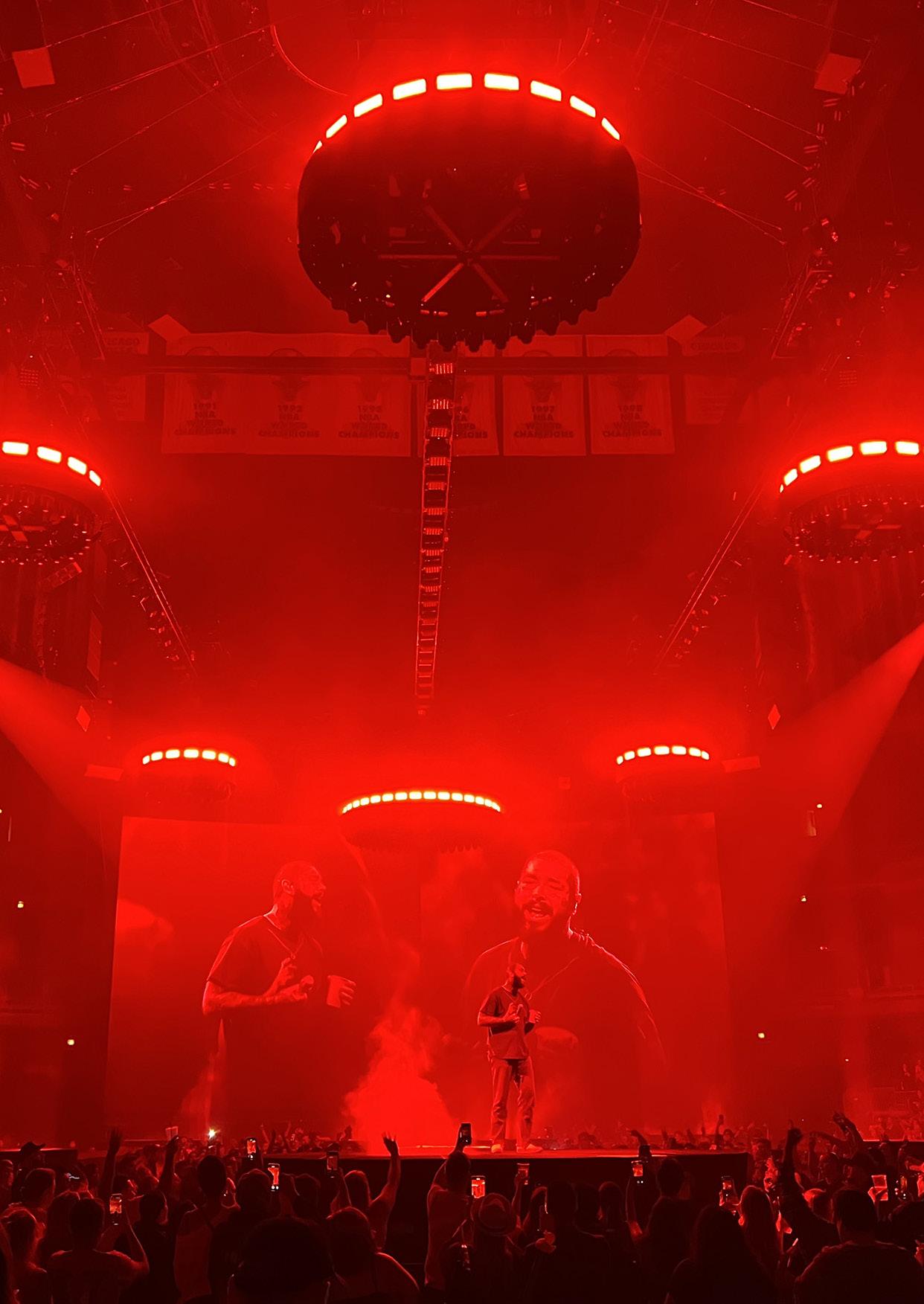
GLP lighting solutions have been no strangers to Post Malone’s stage scenography over the years, and his latest Twelve Carat tour – with Dan Norman (of Evolve Lights) now in charge of the visuals – is no exception.
Introduced to the creative team in 2019 to help programme new songs that were added to the Runway tour, he has subsequently worked consistently with the Posty Touring team, along with production manager Dennis Danneels. Along the way Norman designed the artist’s Billboard Awards remote performance in a sand quarry and a New Year’s Eve Bud Lite livestream event during the pandemic prior to a 2021 festival run.
These successes earned him the right to light Post Malone’s latest concert tour, in support of his fourth studio album Twelve Carat Toothache . Once again, the LD has drawn on a slew of Impression FR10 Bars and JDC1 hybrid strobes, provided by PRG. This formed a large part of a complex set populated with 750 fixtures, illuminating three long runways and multiple small interconnected circular B stages, which allow him
to move within the crowd and feel their energy.
“I spent time working out the math with Tait and Dennis [Danneels] to make the stages as wide as possible in the arena while keeping things as close to square and 45 degrees as possible,” states Norman. “Creating the vertical architecture of this stage was important, with the extension of the seven circles into tall columns of light serving as the main look of the
show, and overall I’m really happy we were able to find a way for Post to connect with his fans.”
Most of the fixtures reside on concentric rings above and under the seven circle stages, enabling the columns to glow brightly. The remainder of the fixtures were placed in such a way as to connect the circles visually to the one larger stage – including strobes to hype up the crowd and lasers. “Many of the looks were designed to be optimised by what also looks good on cellphone cameras, as everyone posts the show online to some social media platform,” the designer explains.
Having used the GLP Impression X4 Bar 20 in previous designs “to create epic sheets of light”, he was excited by the prospect of using the even more powerful GLP FR10 Bar batten to uplight through the grated circle decks to create those seven vertical columns of light. “I needed a unit of intense brightness to combat the almost 40% loss of light due to that grated decking –and the FR10 Bar really delivered,” Norman continues. “When we turned them on for the first time, we all just went ‘wow!’”
Tait created a custom hanging bracket for the 23 FR10 Bars that created the horizontal line of light upstage. As for the JDC1, according to the production manager,
after the first show Post Malone remarked that he immediately recognised and appreciated the JDC1, which had featured on almost every previous show.

“WE LOVE TO SEE POST IN SILHOUETTE, WITH PLENTY OF FOG… AND THE FR10 BARS CREATE THAT EPIC LOOK.”
In fact the JDC1s have been a longtime workhorse for Post Malone shows, and with so many on this tour they provided the necessary punch to light up the entire arena. “I

chose the JDC1 in particular because
I love the white strip in the middle,” says Norman. “There is something delicate about arranging them on the automated circle pods over the seven circle stages, and glowing them at 5%. You get this halo that is so ethereal, giving such a clean and cool look.”
With the number of songs in the show, combined with the automation moves on the pods, he also wanted a fixture that could tilt and be used for multiple purposes. “We shine the JDCs outward, using them either as blinders, glowing architecture or quick high power white snaps, and then deep saturated red and blue. I also tilt them inwards and glow the mechanics, chains, cables and structure of the pods to make them feel like they are alive and breathing.”
Returning to GLP’s Impression FR10 Bar battens, Dan Norman is a big fan of the RGB and white: “Having a white chip in LED products makes creating
less saturated colour way easier – and they look great on camera. We use a wide range of colours on this show, typically using one or two colours plus white for a song, which provides a clean look and is easily distinguished between songs.
“We love to see Post in silhouette, with plenty of fog… and the FR10 Bars create that epic look.”
GLP.DE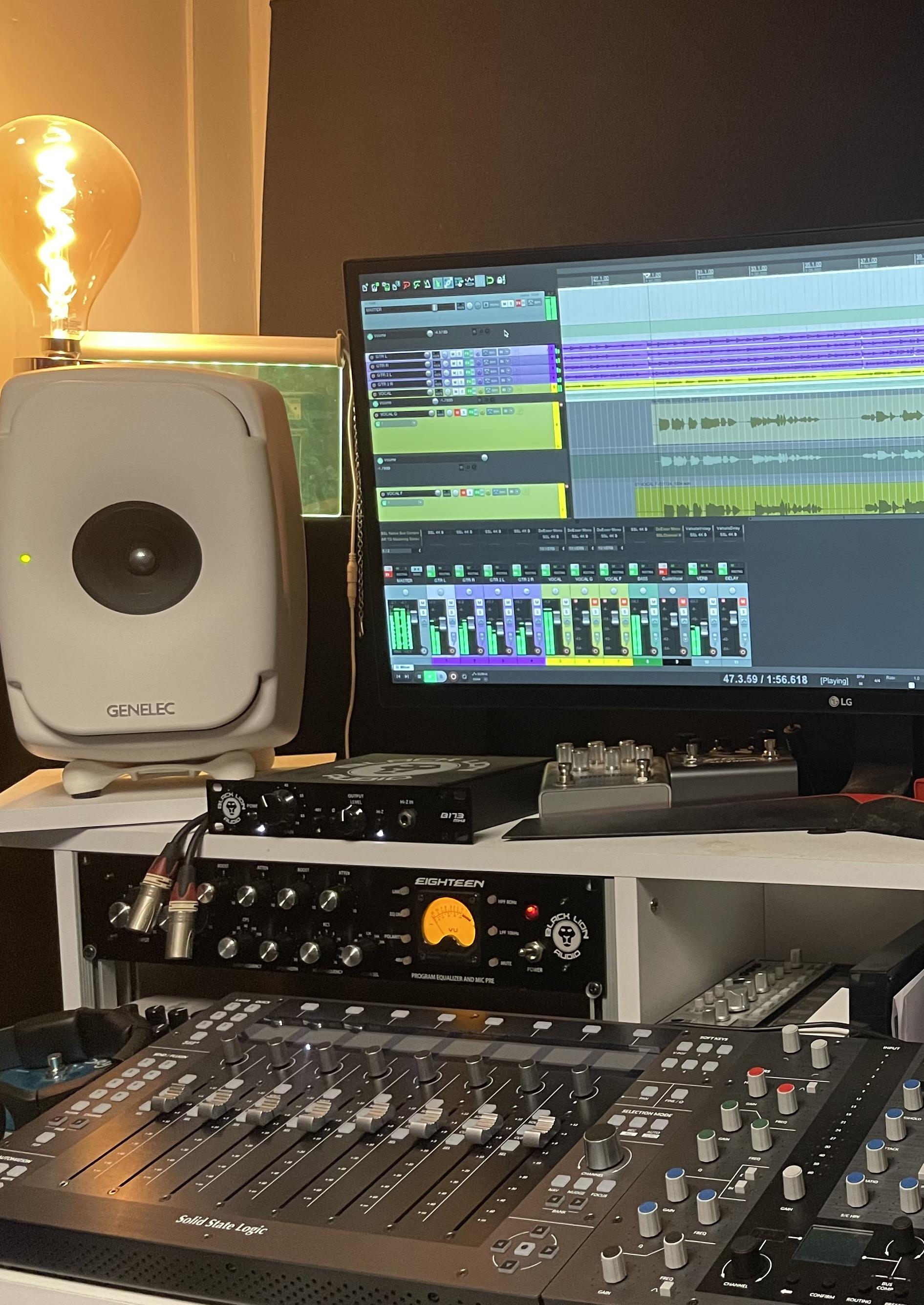
The latest in SSL’s range of plugins has arrived: SL 4K B Channel Strip, which might just be the manufacturer’s best emulation so far. Headliner takes a look…
It was just over a year ago when I acquired some of SSL’s Fusion plugins: Vintage Drive, Stereo Image (both now staples on my master bus), and HF Compressor – and I have to say, they’re all brilliant. Then, when SSL started rolling out monthly plugin releases shortly after, I soon got the bug: Native X-Echo is commonplace for airy guitars and specific vocal FX; Native X-Gate is a go-to; and the classic SSL Mix Bus compressor sits proudly where another manufacturer’s equivalent used to. I know these plugins aren’t cheap to buy, but you do tend to get what you pay for – and the introduction of a subscription service ($14.99 per month for all SSL plugins) offers an attractive alternative to forking out for each individual product.
SL 4K B Channel Strip is the latest member of SSL’s fast-growing plugin family, and it’s an absolute beast. It is, SSL says, a meticulously crafted emulation of the SL 4000 B, SSL’s debut console which dates back to 1976. This console was unique in several ways, and after only half an hour working with this plugin, I realised that the plugin was too. And here is why…
The mic pre section, for me, is without question the coolest part about the SL 4K B plugin. After doing further homework on the original SL 4000 B console, I learnt that its mic pres were transformer-loaded with Jensen JE-115K-Es and that it boasted dbx Black Can 202 VCA faders on each of its individual channel outputs; this is what gave the console such character, and it appears SSL has dived in deep here to ensure that the modelling of these circuits has been nailed on as close as possible to the original.
Yes, there is a beautiful smoothness in the high end on the EQ section, as you’d expect, but the beauty is in the core, which is literally jam-packed with colour.
There is an ‘in trim’ dial (which determines how much signal is being fired into the circuit), a 4K B mic pre dial, and a pre button; when you engage the pre button, you can begin dialling in the 4K B mic pre.
and Pan controls (the latter two only work in stereo, of course). This generates further harmonics the more you raise the level, and thanks to the inclusion of a digital output trim at the bottom, you can drive the fader as much as you like, then just roll it back off at the end.
I may not have heard the real board in action, but the possibilities that this plugin offers are vast; and sonically, it is exquisite. It’s also key to note that this is not a clean channel strip - much like the original, evidently. Something else I learned about the SL 4000 B is that its compressor was based on the topology of SSL’s Bus Compressor, so of course this also goes for the plugin. It ultimately means ratios are set to fixed values of 2:1, 4:1, and 10:1; and the same goes for the release: .2, .4, .8, and 1.6s. It doesn’t feel limiting though - if anything, you find yourself making decisions faster.
But there’s more - on both the ratio and release, there is a ds option. Set both dials to ds and you have a really
This is a really explosive sounding pre, full of character, which means you can get your sonics nice and punchy very easily, but you can also thicken it up, give it more guts, or if you’re feeling brave, turn it right up for some quite ferocious distortions.
Below the pre is the dbx Black Can fader complete with Cut, Solo, Width great de-esser; set just the release to ds and you’ve got a much faster release time on your compressor.
The compressor itself is great, and smooth – it works beautifully on vocals, bass, guitars, drums – but sticking with vocals for a second, I am such a fan of the de-esser that I think I’d be tempted to use it just as a de-esser (it’s one or the other, of course) then perhaps bring in an 1176 or LA2A, or both, as my main vocal compressor(s). Equally, if I’m not using the de-esser for whatever
I tried dropping an instance of 4K B onto an existing [processed] vocal stem, engaging the pre, and just dialling it in a little, and that alone brought entirely new life into the voice - a similar effect that my Thermionic Culture Little Red Bustard summing mixer provides when I treat a vocal, except without the hassle of waiting for it to warm up..! It ‘feels’ analogue, put it that way.
reason, this compressor is a very solid option full stop, particularly with the wet/dry option, and with the Jensen mic pre roaring. You really can get great results. The gate is also excellent: simple to use, and very responsive.
Then in the lower right hand side there is a digital readout which allows you to switch up the order of the processing chain: EQ > Filters > Dynamics, or whichever way you fancy.
“IT FEELS LIKE THERE ARE NO RULES WITH THIS CHANNEL STRIP…”
Simply put, the presets on the 4K B are incredible - and some are quite different to what you might expect, particularly producer Benni Dumville’s signature offerings: his ‘Vocal Vibes’ pushes a good chunk of air in at 16kHz with a perhaps less common [on vocals] low boost at 89Hz, and is full of drive - and it just sounds excellent (as long as you bring the output trim down) And his ‘Generic Descriptive Term’, whatever that means, sounds absolutely epic on a drum bus (and probably everything

else). These presets feel like tools in themselves, and inspire creativity.
There are some great manufacturer presets in there, too: Orchestral > Strings > High got me fabulously smooth sounding strings very quickly; Guitar > LA Clean Guitar Amp is lovely and warm sounding; and I found Keys > LA Electric Keyboard brought life to my Rhodes, and all kinds of cool effects when I dropped it on my Hammond.
You really need to hear them to believe them, and self-producing artists can certainly learn a lot from some of these presets, as they offer an instant insight into what this old console was all about. You learn as you go, and it feels like there are no rules, as such, with this channel strip.
more ‘real’ to me, and this is the beauty of this SSL hybrid
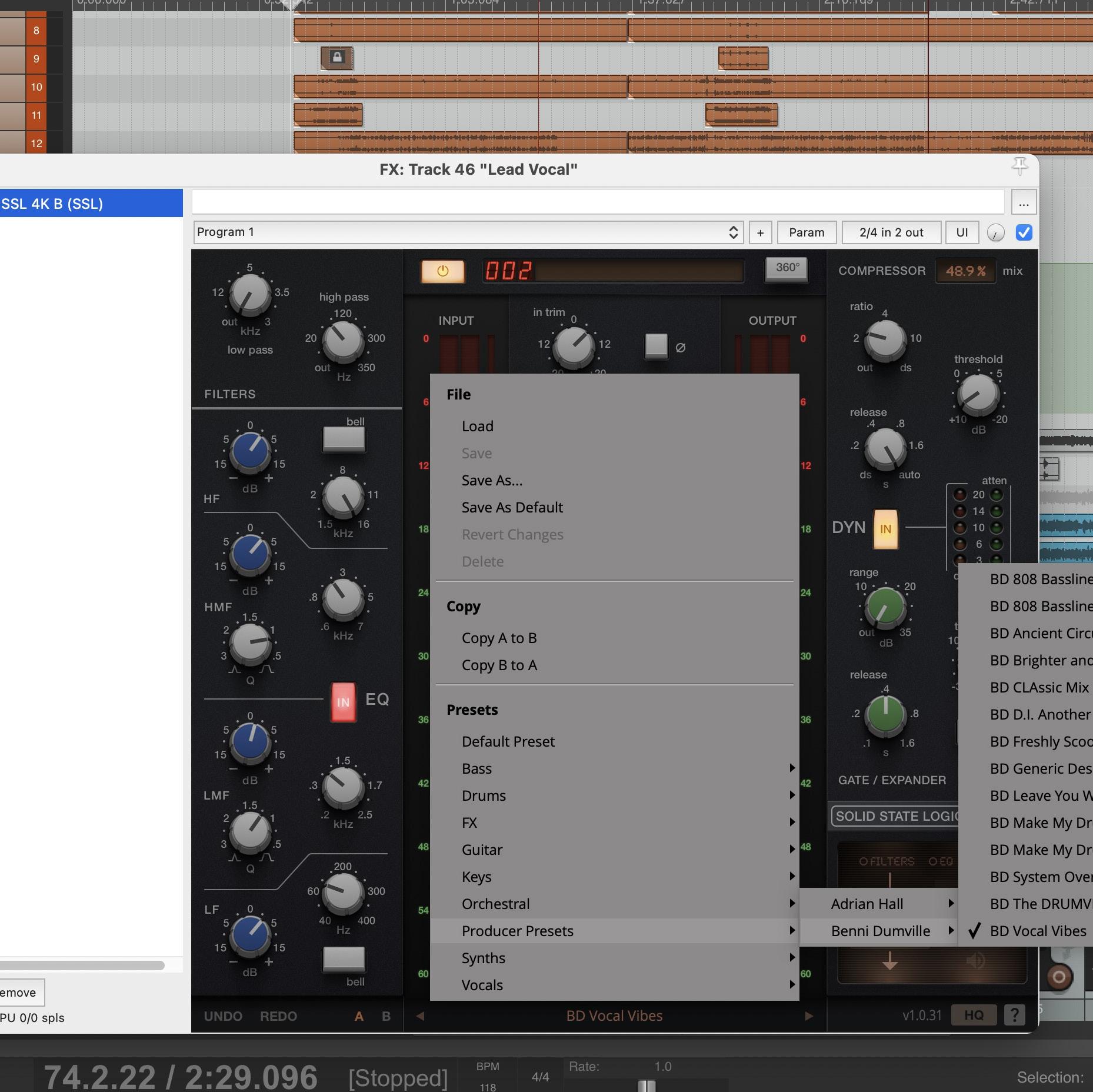
Using amp modellers or IRs? Then check out the revolutionary new Celestion F12-X200. It’s the first and only guitar speaker to combine the Full Range performance your modelling amp requires with the Live Response you need to feel connected to the music. Find out more at celestion.com
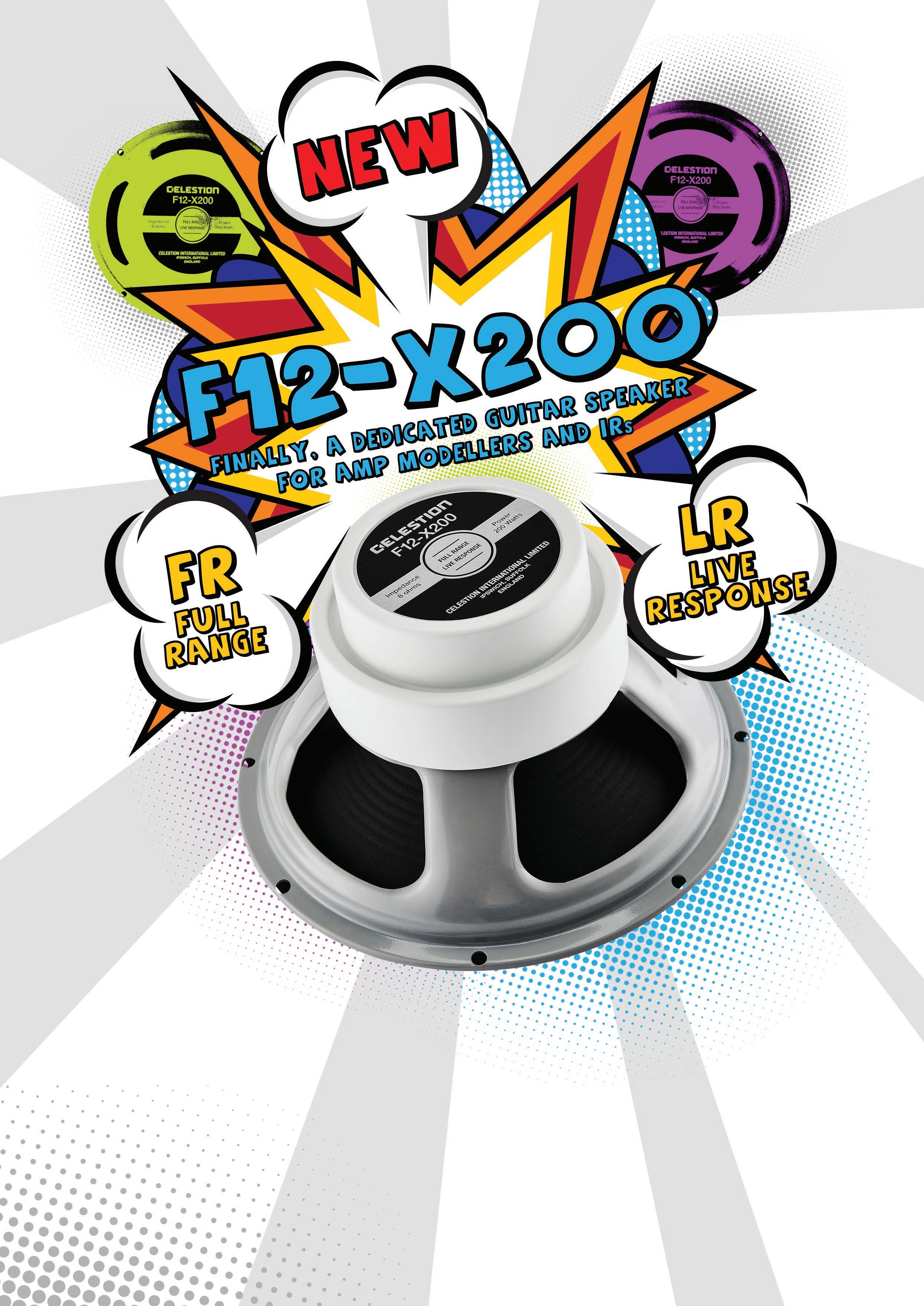

Tell us about the concept for this project and how you came to be involved.
Ulrike: Jane Ira Bloom, Jim Anderson and I developed the idea to create an immersive audio project based on the science photography of Berenice Abbott, a New York photographer active from the 1920s to the 1990s. Jane and I received a grant from the New York Foundation of The Arts in cooperation with NYC’s Women’s Fund for Media, Entertainment and Theatre in late 2019.
The concept of the album was to record the space in between the notes with unusual instrumentation, like vibraphone, koto, pipa, percussion, bass in conversation with the soprano saxophone. The plan was to get everybody in the same space and ‘picture the invisible’ together. We wanted to present this in Ultra High Definition and Immersive Sound to illustrate the space even better.
Then the pandemic hit, and we had to revisit our concept. Jane chose duo partners and reshaped the arrangements; I came up with a concept to record duos in home spaces and via the internet. One of my Pyramix recording systems was set up at Jane’s tiny office and microphones
set for immersive recording. I travelled with the other system to the other partners Allison Miller, Mark Helias and Miya Masaoka, and turned their rehearsal spaces and living rooms into recording sites. I controlled both Pyramix systems from my main recording system.
How different is the process of working on stereo and immersive projects?
Ulrike: Mixing for stereo and immersive formats each have their own difficulties. This recording had additional challenges in that the album was recorded exclusively in spaces that were very different from each other – none were meant to be a recording space. Generally, in stereo, the mixing challenge is to get all the musical information into two channels while keeping the clarity of the musical content and providing a depth and space in a recording.
For immersive mixes, the challenge lies within the placement of the instruments and musical content in the 3D space. Sometimes the lack of musical or psychoacoustic knowledge can result in wrong mixing decisions that will distort the musical content and, in the worst cases, appear unintentionally comical.
Jim and I had in-depth conversations about the microphone setup that would allow us to do both a 3D impression of all instruments and exclusion of the room footprints of the recording venues. It all came together with the 3D reverb chamber at Skywalker Sound that we used during the mixing process.
Is the process of immersive mastering different to mastering a stereo recording?
Ulrike: Yes and no. Theoretically it is the same process, but with immersive projects, the delivery formats are very varied. The workflows for each one are sometimes established, but sometimes they need to be developed. Very few mastering houses have monitoring options that can work in multiple immersive formats on a very high level.
How did you each approach this project?
Morten: My mentality for mastering is to not get in the way of the qualities created in the recording. With the mixes coming from Jim and Ulrike I didn’t feel the need to apply any EQ, compressors or limiters. My most important tool is extended range monitoring in a good room. I spend a lot of time focusing on the broad
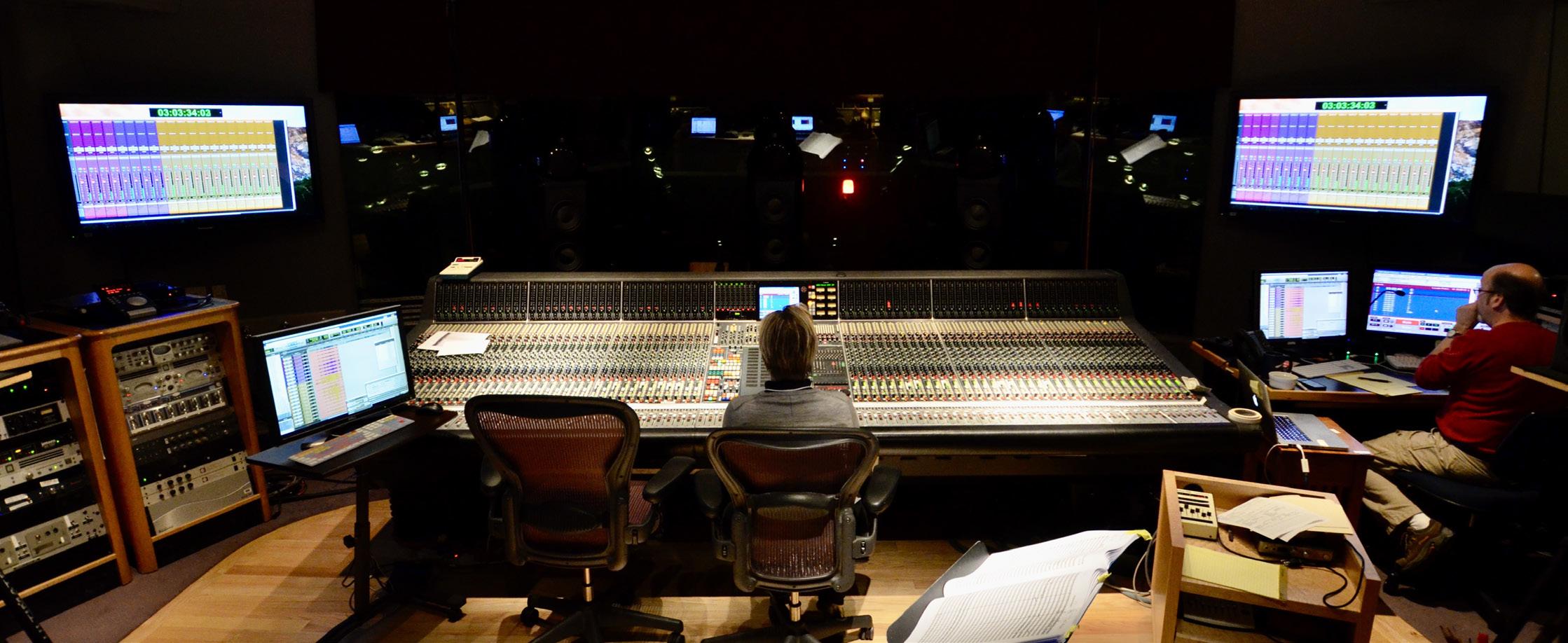

“THE QUALITY OF AUDIO PROCESSING IS SINGULARLY HIGH.”
strokes affecting the consumers’ perception of the album. It mostly comes down to energy curves, making small adjustments to levels, securing a loudness target and tailoring transients to keep within a safe True Peak value. Our Pyramix platform secures lossless transport of the content, using the MTFF format preserving 32-bit float resolution at the project’s original sample rate.
Our major challenge today is to fit a single delivery master into a wide range of consumer formats, ranging from lossy stereo to high end immersive. I’ve developed within the Pyramix a matrix style of mastering that works in stereo, surround and immersive. From these originals we derive deliverables according to the specification of the services. We also explore new formats, especially within the home cinema market, using open source containers like MKV to carry Dolby Atmos TrueHD, DTS and Auro3D. It is important for us to challenge the lossy low-bandwidth services and provide an alternative with higher fidelity alternatives.
Ulrike: The main objective was to deliver a technical setup that would enable the musicians to collaborate and make music as if they were in a studio, all while keeping everyone safe during the pandemic. That eliminated the possibility of assistant engineers, as only I was allowed to enter Jane’s or anybody else’s apartments.
One set of microphones and a Pyramix system with Hapi interface in 384kHz/32bit was set up and soundchecked at Jane’s office. The room treatment was winter jackets on the sofa, towels on the desk to reduce early reflections. The microphones were split analogue and sent to a n-1 ready,
latency free Acousta LE03 interface that was working with the communication software. The other Pyramix system with the Merging Technologies Horus travelled with me to the other duo partners. The same setup to the communication platform and room treatment was used.
Can you elaborate further on your Merging Technologies setups?
Ulrike: My main Pyramix workstation is a prototype of a PC Audiolabs laptop with expansion chassis and the Pyramix Extended Software with MassCore that allows for recording 64 channels in DSD/DXD. This was developed at the end of 2018 for the mobile recording of a Patricia Barber album Clique!. I have a second laptop based on an Apple Power Book that can record up to eight channels DSD/ DXD. We have a Horus, a Hapi MK1 and one Anubis Premium interface. Currently we have 52 channels Premium DA and 44 channels Premium AD.
The heart and soul of our system is the Merging Technologies Clock U. Once you have heard it you can’t go back. We used it the first time on Clique! and knew we had to get one. The stability and sonic properties the clock brings to the recordings are unmatched.
What
Ulrike: Merging systems are state of the art and in many ways ahead of its class. I haven’t been able to achieve sonic results even close to those we achieve with Merging systems with other workstations and components. We haven’t had a single freeze in a recording situation as of now. It allowed us to sneak a system
into Cuba once and run a complete recording on one machine only! The AoIP enables us to shorten copper cable connections significantly, provide a multitude of inputs in many locations with ease and work flexibly.
How did you come across Merging products?
Ulrike: When I left my broadcasting job at Bayerischer Rundfunk in 2015 I was evaluating which system I wanted to work with in the future. All the state-of-the-art High Definition or Ultra High Definition production houses worked with Merging Technologies products. Those were mostly for classical music projects, and I wasn’t sure if I could adapt the software for our hybrid production styles but it turned out to be not a problem. The quality of audio processing is singularly high. The versatility in the monitoring options is also something I wouldn’t want to miss anymore. The learning curve is steeper than with other systems but the payoff is worth it.
“MERGING
is it that you particularly like about these systems?




It may be nearing the end of December, but Ben Westbeech has just been for a morning swim in the sea. Hailing from Hertfordshire via stints in Bristol, London and Amsterdam, he isn’t braving the English Channel though, but the Mediterranean Sea of his now home in Ibiza.
“I moved here for nature, really,” he says. “I’ve lived in cities all my life, so I was a bit sick of living in a place where you’re on top of everyone or there’s lots of people around. I wanted to get to a place where there’s lots of lovely nature, and I love the sea, so I wanted to be close to that. I have a cold swimming club –we’re called the Santa Eulalia otters,” he laughs. “We swim every day. It’s nice – it’s kind of a community.”
Given his house, drum and bass and dance credentials, many will be surprised to learn that Westbeech is a classically trained cellist, pianist and vocalist.
“I didn’t really fit into that classical world,” he admits. “I’ve always felt a bit odd being in there. I never thought about pursuing a career in classical music, although my old singing teacher did say she wanted me to be an opera singer. But I don’t think that lifestyle is for me. I got into dance music around age 11 and started DJing at that time. I kind of had to unlearn almost all of the musicality I had learned and work out how to make music without all of that going on as well.”
He’s got no regrets when it comes to not following the classical path, quickly finding a home in the dance world. His debut album Welcome to the Best Years of Your Life was released in 2007, and now, four albums later and numerous collabs in between (including writing the vocal for Redlight’s breakthrough hit Get Out My Head), his biggest hit yet, 2013’s Jack,
has just been re-released by Defected Records, nine years after climbing to no. 9 on the UK singles chart under his moniker, Breach.
“Basically the rights came up,” he laughs by way of explaining the timing of the re-release. “You sign record deals for a certain period of time. After this period Defected got in touch and they were like, ‘We really want to relicense this and give it a new breath of life; we think it’s time’. We’ve got Derrick Carter to do a remix – he’s a Chicago house legend – and then a couple of other people are remixing it. It’s about getting it back out into the clubs. Tunes sometimes come back for a period and then disappear again, that’s just how music works. We’ll see what happens to it…I have no idea how it’s gonna go. You’ve just got to hope and pray!”
Jack remains one of the standout records from a time often coined deep house’s golden era, although Westbeech shares that it was never intended to be a single, let alone one he foresaw the mainstream industry paying any attention to. Dirtybird boss Claude VonStroke signed his track Let’s Get Hot and requested something “with a sleazier vibe” as a B-side.
“I ended up writing two tunes and Jack was one of them,” he recalls.
“Claude VonStroke was like, ‘It’s great, but I think it’s the B-side’. So I was like, ‘Okay, cool. No problem’, then everyone started playing it and it was spreading like wildfire. Everyone was playing it. You notice the vocal straightaway because there wasn’t really a huge amount that sounded like that at the time. After a while, we saw the reaction it was having and the decision was made to make this an A-side, so then it got released.”
The song did so well it caught Atlantic’s attention, which promptly threw a massive budget behind it – resulting
in an oddball wig-centric music video which racked up over 14 million views. “Then it went even bigger, but it was funny because when a record goes that big then you get people saying, ‘Oh, you’ve sold out’ – because it’s just an underground record,” he reflects.
“Underground music’s always been funny like that. People get really into it and they’ll stay in one scene forever and be diehard with that, and I totally respect that to be honest, but I’m someone who needs more than just one style of music in my life, or one sort of sound. I’ve never been against any sort of commercial music or success. I think music’s just music and everything’s got its own little place in the world musically. But in those days, there was a lot of animosity if you had a big record and you were from the underground. People would be like, ‘You can’t play the underground clubs anymore because you made a big record’. It’s strange how dance music works like that,” he shrugs.
Westbeech thinks that the track’s longevity stems from the very fact that he wrote it not to appeal to the mainstream, and without any obvious singalong parts or melodic hooks. “There’s a naivety if you’re making records like that; it kind of comes from the heart,” he considers. “That’s the essence of what you really want when you’re making music. When you’re writing to be commercial and to be a ‘radio record’, you’re going to conform in some way to things that maybe aren’t you. My advice is always, don’t do that. It’s not particularly what I’m about or what I want to do with my music. But if it happens, it’s great.”
The track’s lyrics consist of the repeated spoken phrase: “I want your body, everybody wants your body, so let’s jack.” These, says Westbeech, came to him in a dream.
“THERE WAS A LOT OF ANIMOSITY IF YOU HAD A BIG RECORD AND YOU WERE FROM THE UNDERGROUND.”
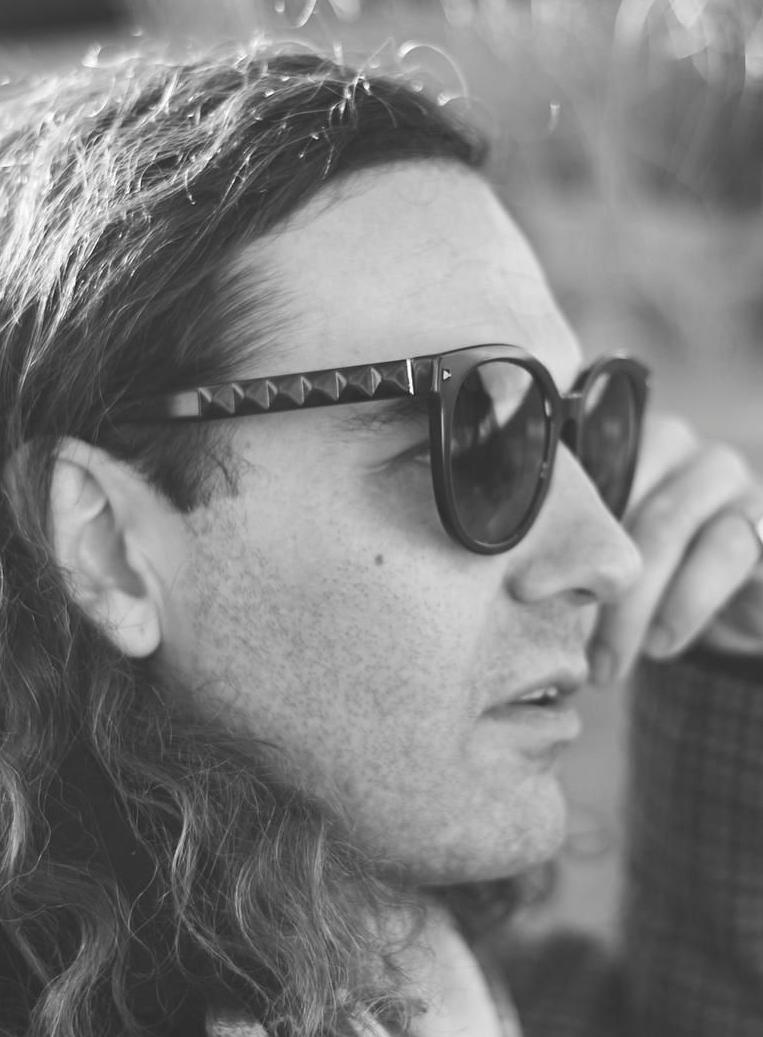
“I woke up and I put a voice note in my phone of the lyrics, then went back to sleep and woke up the next day and listened to it,” he remembers. “I thought, ‘I’ve got to go to the studio and put that down’, so I went and put it down, and then a few days later came back to it and made the record in one day.”
The ginger wig-clad woman in the music video isn’t the one behind the American, feminine-sounding lyrics – it turns out, it’s all Westbeech: “I wanted it to sound like a woman saying it,” he nods. “So I did it in a different range of my voice and made it sound a bit more womanly, and then processed the crap out of it. Then it was lots of pitching down and pitching up and resampling it. I think I resampled it about 20 times or something like that. I didn’t really think too much about it; I was just in the zone with it.”
In terms of the production, it’s a stripped back track, which Westbeech says was intentional: “The idea came together really quickly and I spent about two weeks mixing it. It is stripped back, but it was made to sound like that. Everything has its own special place – the bassline is obviously huge and the kick is huge, so getting those to work together was a tough one. It did take a long time to get the mix right on it to sound as fat as it does.”
In his studio, Westbeech has been using Steinberg’s Cubase as his DAW for at least 20 years. He’s using the most recent iteration, Cubase 12, which includes improved MIDI remote integration, editing tools, enhanced audioto-MIDI and new effects. “It was the first programme I got introduced to and I just never stopped using it,” he explains. “I’ve tried mixing in some other DAWs but I always come back to Cubase because I just get it, you know? I’m quick with it and I like the workflow for mixing. I like the sounds you can get out of it.”
His personal favourite aspects of Cubase are its pitch and time correction features for moving audio around: “It’s phenomenal. I love how you can group a whole bunch of tracks together and move them up and down. The other main thing I love is the sound you can get out of it. It’s a great DAW and the sound engine really works for me. I always go back to Cubase because I know how to get my sound out of it. I must say my best feature about Cubase 12 is them getting rid of the dongle,” he shares. “The amount of things I lost over the years…if you lose it, you couldn’t use it again. So I’d always be calling up Steinberg like, ‘I’ve lost a dongle again’,” he laughs, shaking his head.
In addition to the Jack re-release, Westbeech has a number of remixes lined up for 2023, as well as a folk album which he’s currently putting the finishing touches to.
“I’m always working, making new things and trying to learn every day and push myself. I’m just trying to keep enjoying it,” he says, sharing that there are two things he must have on Christmas day in Ibiza: a sea swim and bread sauce. “The Santa Eulalia otters go down to the beach and we have oysters and prosecco and a Christmas swim. All our friends and family are here, so that’s what we do on Christmas Day, and then obviously a nice big dinner. I love Christmas. I’m really into food and drinking nice wine. I’m a massive fan of bread sauce as well – which I know splits opinion, but I’m a massive lover of it. I make a massive batch of that on Christmas Day. It’s changed my life, bread sauce,” he grins.
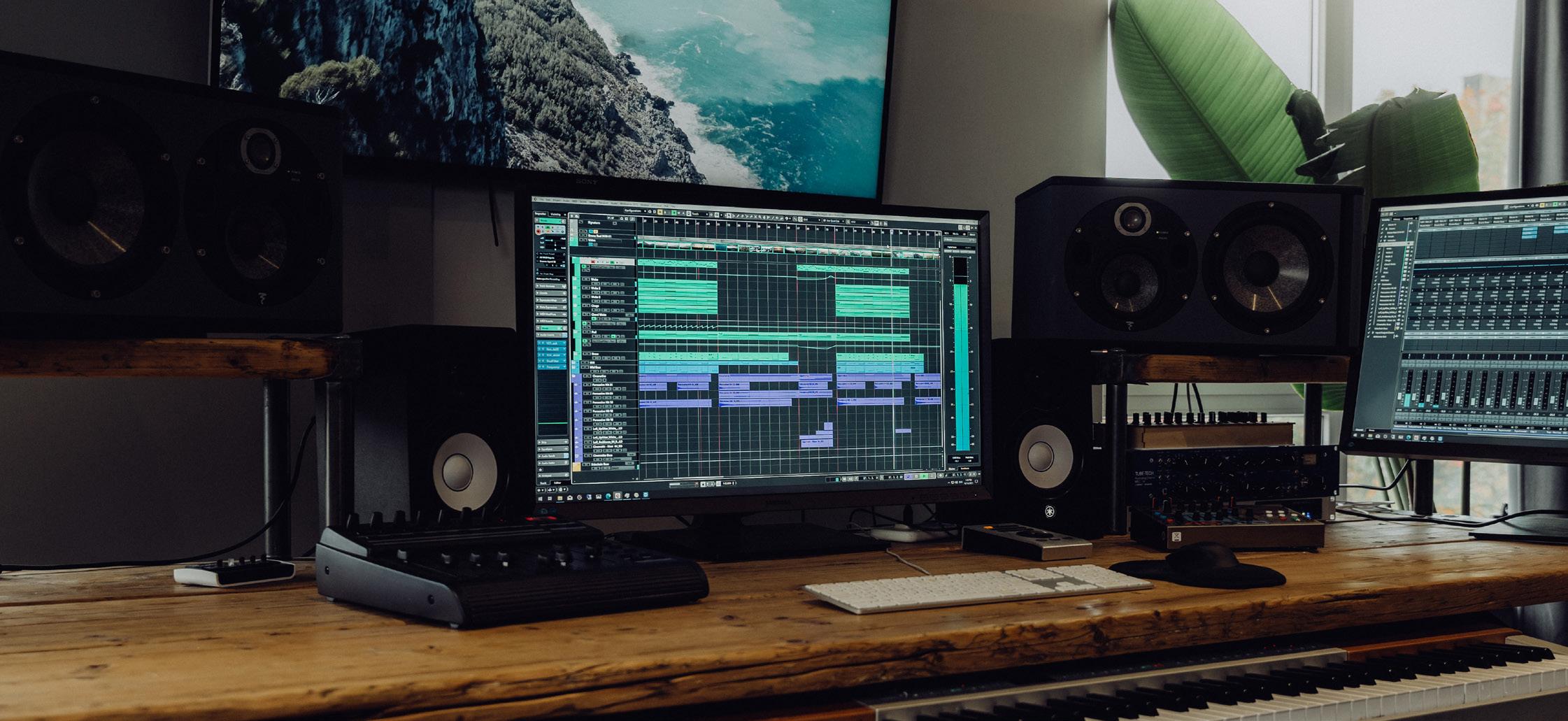

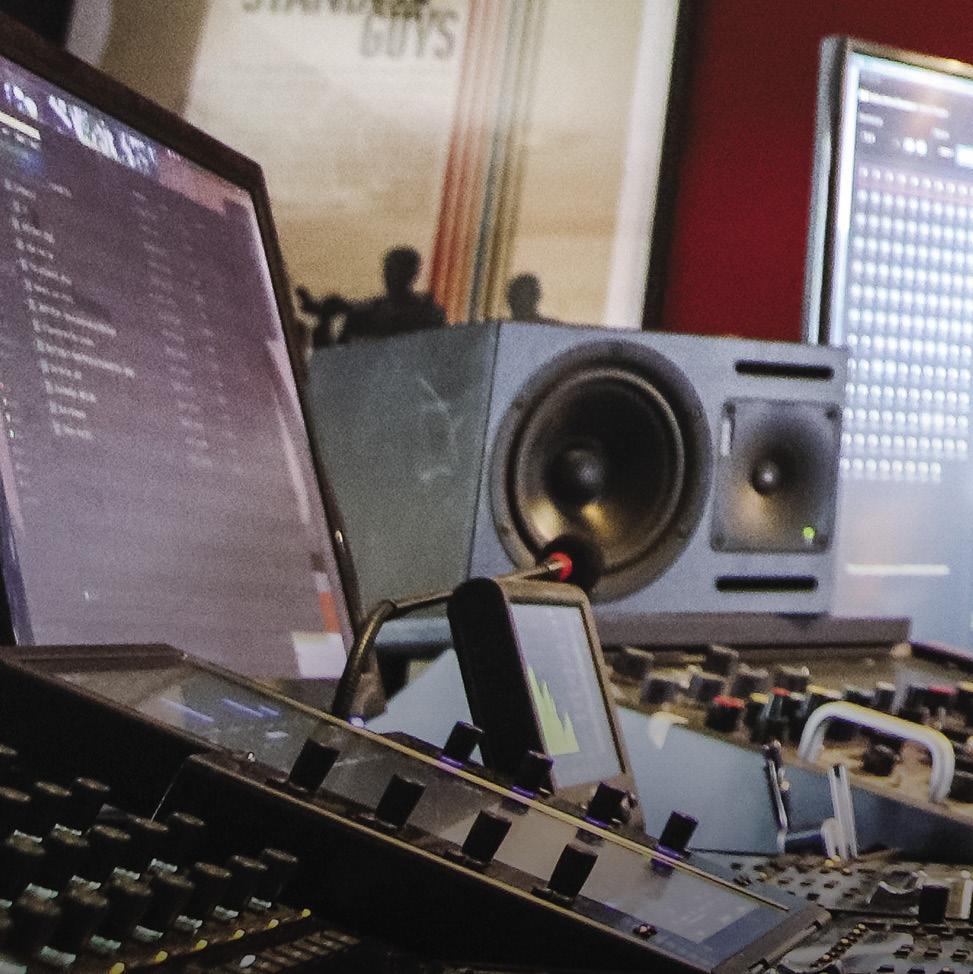
GRAMMY ®-winning producer/engineer Dave Way's resume runs across all genres , spanning pop, rock, R&B and more, and his credits include such acclaimed artists as Christina Aguilera, Fiona Apple, Ziggy Marley, Macy Gray, Michael Jackson, “Weird Al" Yankovic, Phoebe Bridgers, Ringo Starr and dozens of others, in addition to the acclaimed soundtrack to Echo in the Canyon. His most recent GRAMMY nomination was for “Best Immersive Audio Album," for his work as immersive audio co-producer on the 2019 album The Savior by A Bad Think.





Learn more at pro.focusrite.com or scan the QR code below


Like many working in the world of immersive audio, Way's attention has turned to the Dolby Atmos ® format, and in 2020 he took the leap and upgraded his personal facility, Waystation Studio, to be able to mix in Atmos. Since last year, he has been settling in with the new setup, mixing several projects and even recording an entire album specifically to be mixed in Atmos –helped in no small part by his arsenal of interfaces and a RedNet R1 controller from Focusrite Pro.


Whether you’re a seasoned professional or just starting your audio production journey, accurate and trustworthy reference monitors are critical tools for any musician, DJ and recording engineer. Delivering stunning details, JBL Professional 3 Series MkII powered studio monitors are engineered to reveal every nuance of your mix with pristine clarity. With performance like this, take your projects to new heights and ensure your listeners hear your sound as intended.
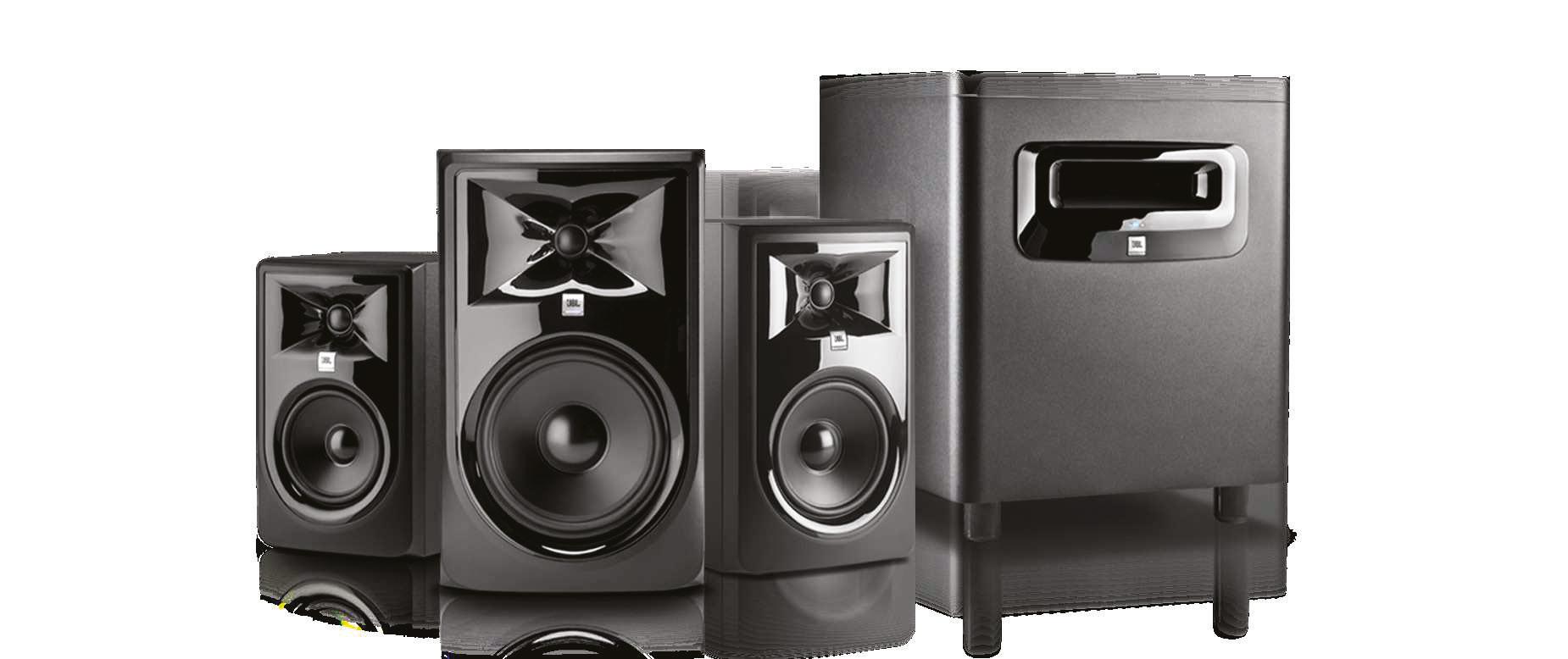
Learn more at: jblpro.com/3-series-mkii
